An Overview and Assessment of MA Research in China (1997-2005)
VerifiedAdded on 2022/08/27
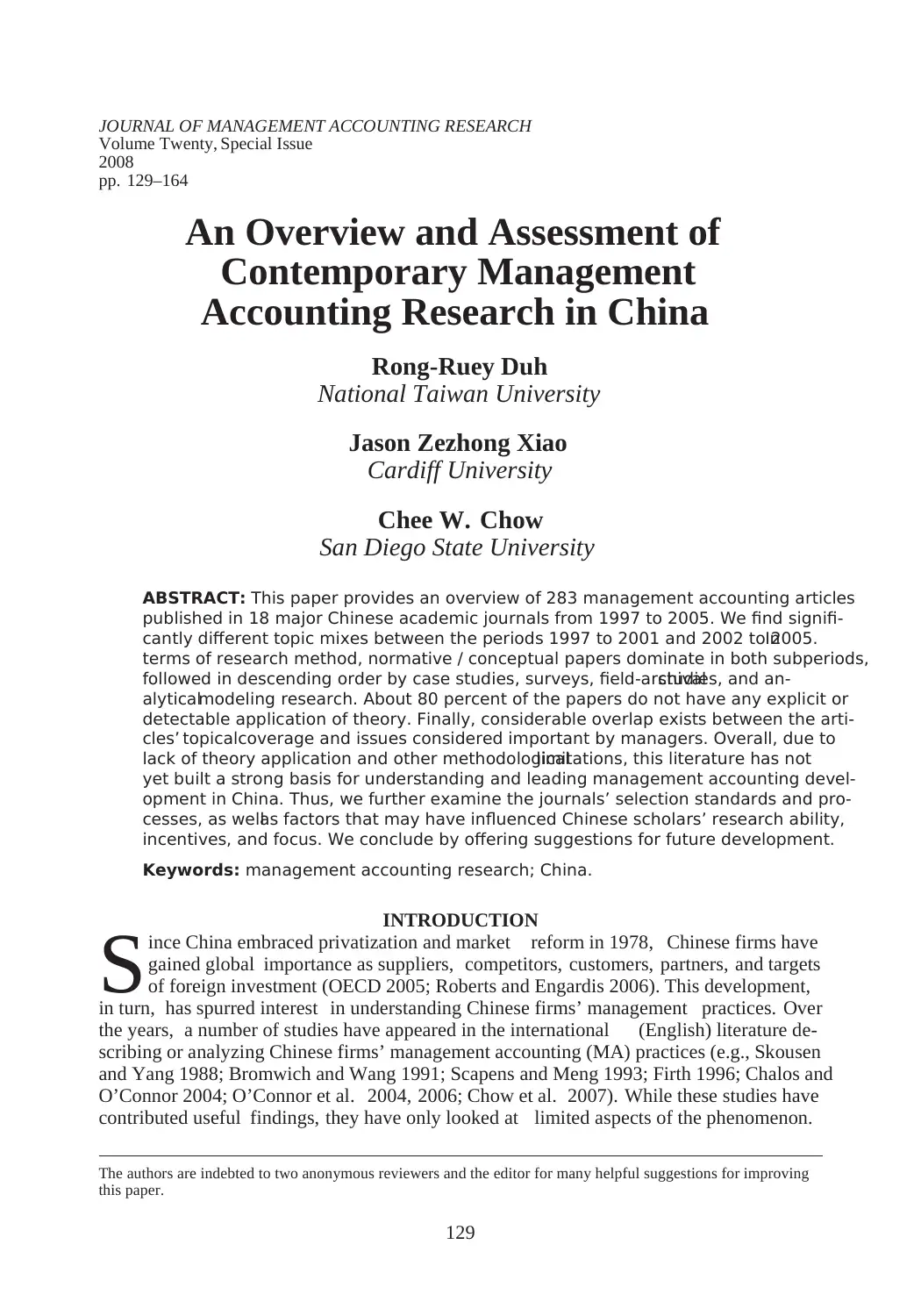
JOURNAL OF MANAGEMENT ACCOUNTING RESEARCH
Volume Twenty, Special Issue
2008
pp. 129–164
An Overview and Assessment of
Contemporary Management
Accounting Research in China
Rong-Ruey Duh
National Taiwan University
Jason Zezhong Xiao
Cardiff University
Chee W. Chow
San Diego State University
ABSTRACT: This paper provides an overview of 283 management accounting articles
published in 18 major Chinese academic journals from 1997 to 2005. We find signifi-
cantly different topic mixes between the periods 1997 to 2001 and 2002 to 2005.In
terms of research method, normative / conceptual papers dominate in both subperiods,
followed in descending order by case studies, surveys, field-archivalstudies, and an-
alyticalmodeling research. About 80 percent of the papers do not have any explicit or
detectable application of theory. Finally, considerable overlap exists between the arti-
cles’ topicalcoverage and issues considered important by managers. Overall, due to
lack of theory application and other methodologicallimitations, this literature has not
yet built a strong basis for understanding and leading management accounting devel-
opment in China. Thus, we further examine the journals’ selection standards and pro-
cesses, as wellas factors that may have influenced Chinese scholars’ research ability,
incentives, and focus. We conclude by offering suggestions for future development.
Keywords: management accounting research; China.
INTRODUCTION
Since China embraced privatization and market reform in 1978, Chinese firms have
gained global importance as suppliers, competitors, customers, partners, and targets
of foreign investment (OECD 2005; Roberts and Engardis 2006). This development,
in turn, has spurred interest in understanding Chinese firms’ management practices. Over
the years, a number of studies have appeared in the international (English) literature de-
scribing or analyzing Chinese firms’ management accounting (MA) practices (e.g., Skousen
and Yang 1988; Bromwich and Wang 1991; Scapens and Meng 1993; Firth 1996; Chalos and
O’Connor 2004; O’Connor et al. 2004, 2006; Chow et al. 2007). While these studies have
contributed useful findings, they have only looked at limited aspects of the phenomenon.
The authors are indebted to two anonymous reviewers and the editor for many helpful suggestions for improving
this paper.
Paraphrase This Document
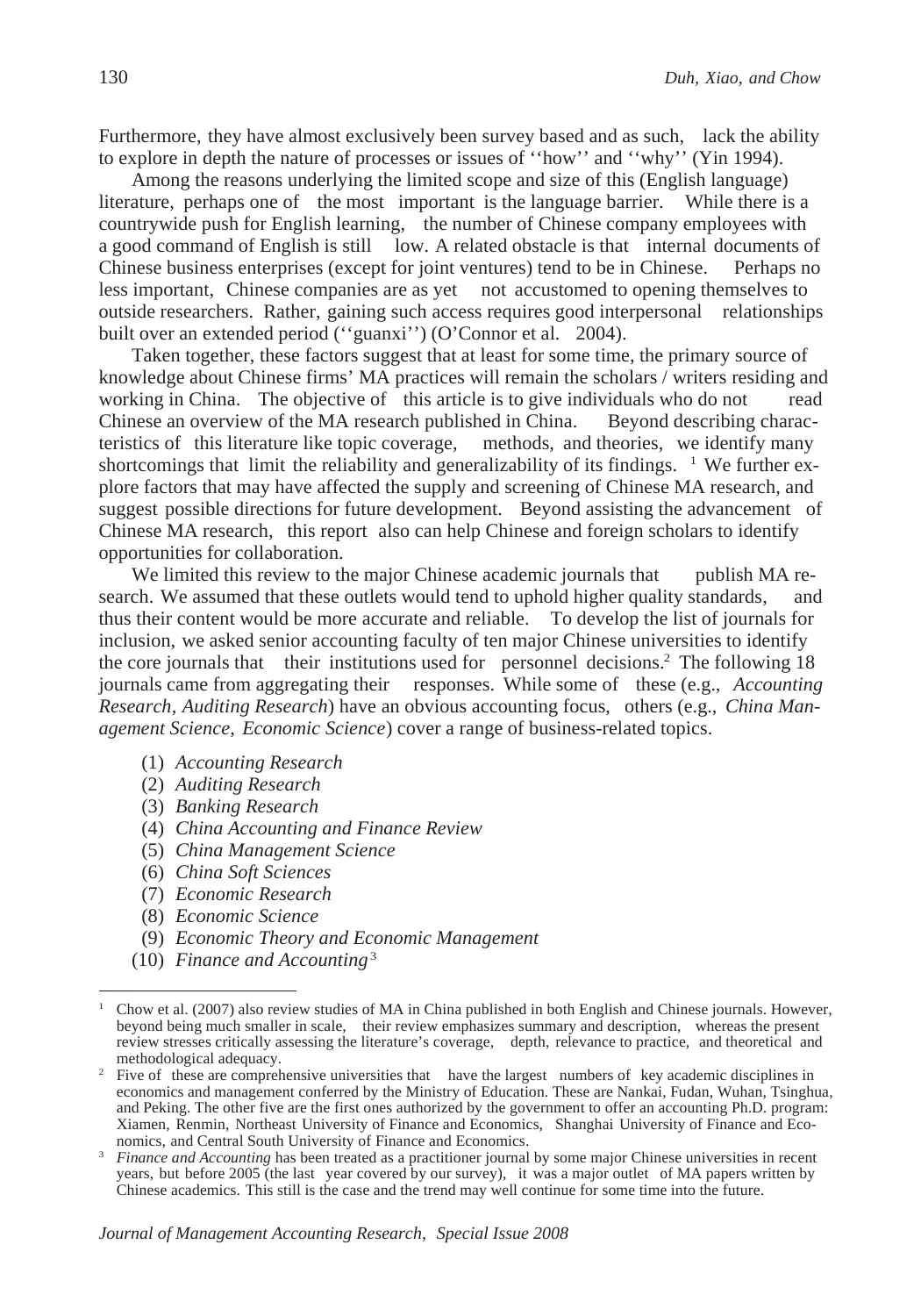
Journal of Management Accounting Research, Special Issue 2008
Furthermore, they have almost exclusively been survey based and as such, lack the ability
to explore in depth the nature of processes or issues of ‘‘how’’ and ‘‘why’’ (Yin 1994).
Among the reasons underlying the limited scope and size of this (English language)
literature, perhaps one of the most important is the language barrier. While there is a
countrywide push for English learning, the number of Chinese company employees with
a good command of English is still low. A related obstacle is that internal documents of
Chinese business enterprises (except for joint ventures) tend to be in Chinese. Perhaps no
less important, Chinese companies are as yet not accustomed to opening themselves to
outside researchers. Rather, gaining such access requires good interpersonal relationships
built over an extended period (‘‘guanxi’’) (O’Connor et al. 2004).
Taken together, these factors suggest that at least for some time, the primary source of
knowledge about Chinese firms’ MA practices will remain the scholars / writers residing and
working in China. The objective of this article is to give individuals who do not read
Chinese an overview of the MA research published in China. Beyond describing charac-
teristics of this literature like topic coverage, methods, and theories, we identify many
shortcomings that limit the reliability and generalizability of its findings. 1 We further ex-
plore factors that may have affected the supply and screening of Chinese MA research, and
suggest possible directions for future development. Beyond assisting the advancement of
Chinese MA research, this report also can help Chinese and foreign scholars to identify
opportunities for collaboration.
We limited this review to the major Chinese academic journals that publish MA re-
search. We assumed that these outlets would tend to uphold higher quality standards, and
thus their content would be more accurate and reliable. To develop the list of journals for
inclusion, we asked senior accounting faculty of ten major Chinese universities to identify
the core journals that their institutions used for personnel decisions.2 The following 18
journals came from aggregating their responses. While some of these (e.g., Accounting
Research, Auditing Research) have an obvious accounting focus, others (e.g., China Man-
agement Science, Economic Science) cover a range of business-related topics.
(1) Accounting Research
(2) Auditing Research
(3) Banking Research
(4) China Accounting and Finance Review
(5) China Management Science
(6) China Soft Sciences
(7) Economic Research
(8) Economic Science
(9) Economic Theory and Economic Management
(10) Finance and Accounting 3
1 Chow et al. (2007) also review studies of MA in China published in both English and Chinese journals. However,
beyond being much smaller in scale, their review emphasizes summary and description, whereas the present
review stresses critically assessing the literature’s coverage, depth, relevance to practice, and theoretical and
methodological adequacy.
2 Five of these are comprehensive universities that have the largest numbers of key academic disciplines in
economics and management conferred by the Ministry of Education. These are Nankai, Fudan, Wuhan, Tsinghua,
and Peking. The other five are the first ones authorized by the government to offer an accounting Ph.D. program:
Xiamen, Renmin, Northeast University of Finance and Economics, Shanghai University of Finance and Eco-
nomics, and Central South University of Finance and Economics.
3 Finance and Accounting has been treated as a practitioner journal by some major Chinese universities in recent
years, but before 2005 (the last year covered by our survey), it was a major outlet of MA papers written by
Chinese academics. This still is the case and the trend may well continue for some time into the future.
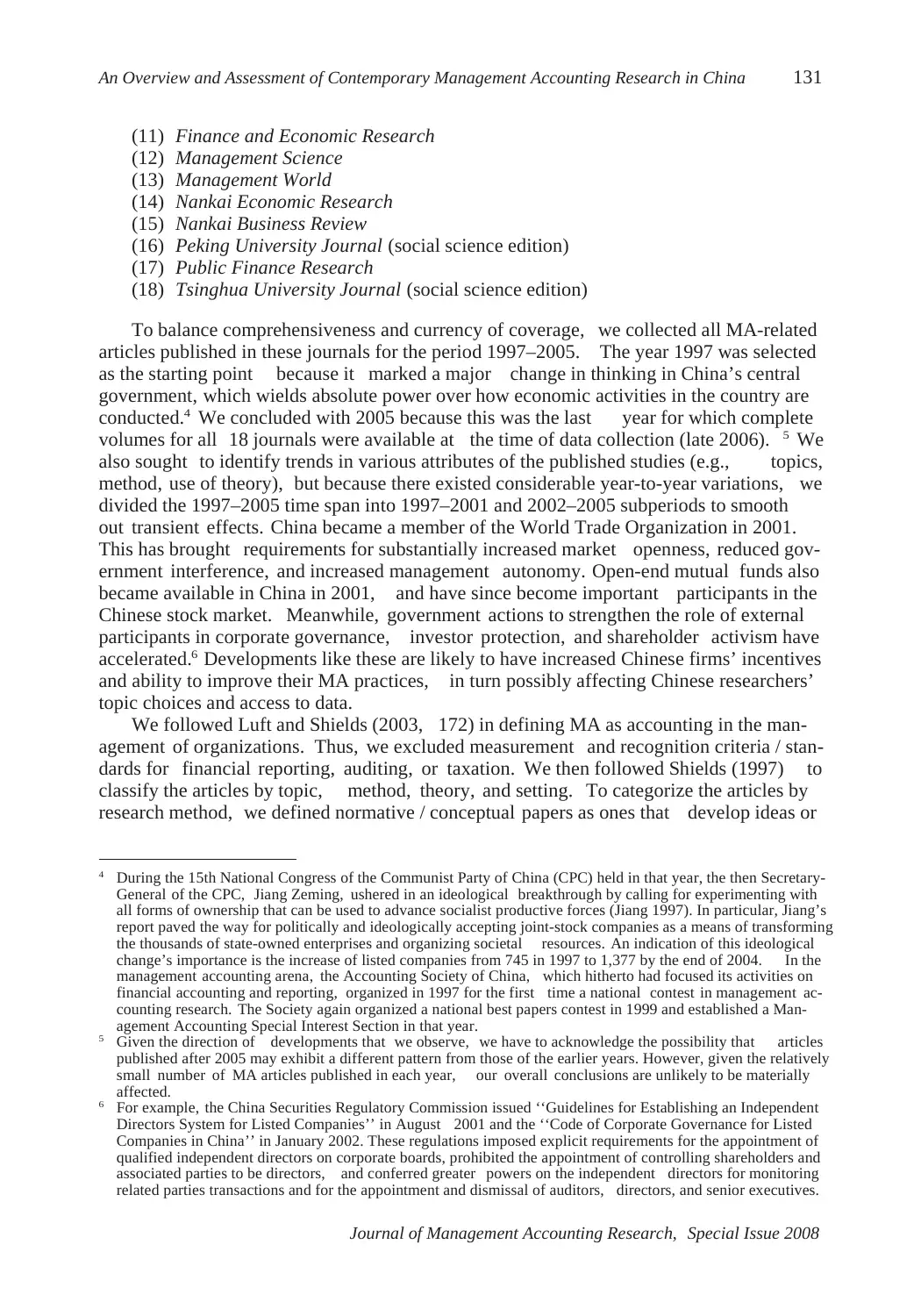
Journal of Management Accounting Research, Special Issue 2008
(11) Finance and Economic Research
(12) Management Science
(13) Management World
(14) Nankai Economic Research
(15) Nankai Business Review
(16) Peking University Journal (social science edition)
(17) Public Finance Research
(18) Tsinghua University Journal (social science edition)
To balance comprehensiveness and currency of coverage, we collected all MA-related
articles published in these journals for the period 1997–2005. The year 1997 was selected
as the starting point because it marked a major change in thinking in China’s central
government, which wields absolute power over how economic activities in the country are
conducted.4 We concluded with 2005 because this was the last year for which complete
volumes for all 18 journals were available at the time of data collection (late 2006). 5 We
also sought to identify trends in various attributes of the published studies (e.g., topics,
method, use of theory), but because there existed considerable year-to-year variations, we
divided the 1997–2005 time span into 1997–2001 and 2002–2005 subperiods to smooth
out transient effects. China became a member of the World Trade Organization in 2001.
This has brought requirements for substantially increased market openness, reduced gov-
ernment interference, and increased management autonomy. Open-end mutual funds also
became available in China in 2001, and have since become important participants in the
Chinese stock market. Meanwhile, government actions to strengthen the role of external
participants in corporate governance, investor protection, and shareholder activism have
accelerated.6 Developments like these are likely to have increased Chinese firms’ incentives
and ability to improve their MA practices, in turn possibly affecting Chinese researchers’
topic choices and access to data.
We followed Luft and Shields (2003, 172) in defining MA as accounting in the man-
agement of organizations. Thus, we excluded measurement and recognition criteria / stan-
dards for financial reporting, auditing, or taxation. We then followed Shields (1997) to
classify the articles by topic, method, theory, and setting. To categorize the articles by
research method, we defined normative / conceptual papers as ones that develop ideas or
4 During the 15th National Congress of the Communist Party of China (CPC) held in that year, the then Secretary-
General of the CPC, Jiang Zeming, ushered in an ideological breakthrough by calling for experimenting with
all forms of ownership that can be used to advance socialist productive forces (Jiang 1997). In particular, Jiang’s
report paved the way for politically and ideologically accepting joint-stock companies as a means of transforming
the thousands of state-owned enterprises and organizing societal resources. An indication of this ideological
change’s importance is the increase of listed companies from 745 in 1997 to 1,377 by the end of 2004. In the
management accounting arena, the Accounting Society of China, which hitherto had focused its activities on
financial accounting and reporting, organized in 1997 for the first time a national contest in management ac-
counting research. The Society again organized a national best papers contest in 1999 and established a Man-
agement Accounting Special Interest Section in that year.
5 Given the direction of developments that we observe, we have to acknowledge the possibility that articles
published after 2005 may exhibit a different pattern from those of the earlier years. However, given the relatively
small number of MA articles published in each year, our overall conclusions are unlikely to be materially
affected.
6 For example, the China Securities Regulatory Commission issued ‘‘Guidelines for Establishing an Independent
Directors System for Listed Companies’’ in August 2001 and the ‘‘Code of Corporate Governance for Listed
Companies in China’’ in January 2002. These regulations imposed explicit requirements for the appointment of
qualified independent directors on corporate boards, prohibited the appointment of controlling shareholders and
associated parties to be directors, and conferred greater powers on the independent directors for monitoring
related parties transactions and for the appointment and dismissal of auditors, directors, and senior executives.
⊘ This is a preview!⊘
Do you want full access?
Subscribe today to unlock all pages.

Trusted by 1+ million students worldwide
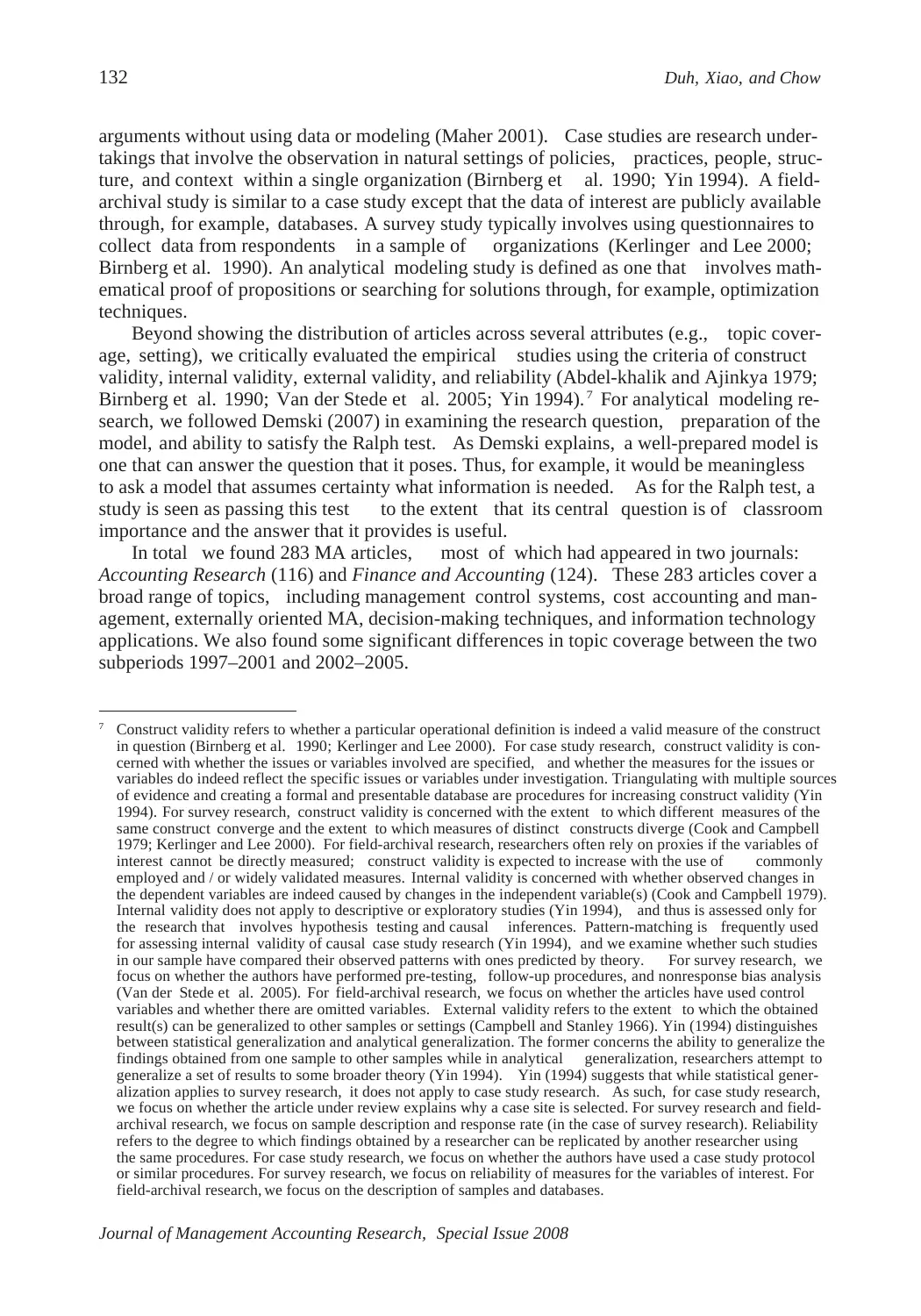
Journal of Management Accounting Research, Special Issue 2008
arguments without using data or modeling (Maher 2001). Case studies are research under-
takings that involve the observation in natural settings of policies, practices, people, struc-
ture, and context within a single organization (Birnberg et al. 1990; Yin 1994). A field-
archival study is similar to a case study except that the data of interest are publicly available
through, for example, databases. A survey study typically involves using questionnaires to
collect data from respondents in a sample of organizations (Kerlinger and Lee 2000;
Birnberg et al. 1990). An analytical modeling study is defined as one that involves math-
ematical proof of propositions or searching for solutions through, for example, optimization
techniques.
Beyond showing the distribution of articles across several attributes (e.g., topic cover-
age, setting), we critically evaluated the empirical studies using the criteria of construct
validity, internal validity, external validity, and reliability (Abdel-khalik and Ajinkya 1979;
Birnberg et al. 1990; Van der Stede et al. 2005; Yin 1994). 7 For analytical modeling re-
search, we followed Demski (2007) in examining the research question, preparation of the
model, and ability to satisfy the Ralph test. As Demski explains, a well-prepared model is
one that can answer the question that it poses. Thus, for example, it would be meaningless
to ask a model that assumes certainty what information is needed. As for the Ralph test, a
study is seen as passing this test to the extent that its central question is of classroom
importance and the answer that it provides is useful.
In total we found 283 MA articles, most of which had appeared in two journals:
Accounting Research (116) and Finance and Accounting (124). These 283 articles cover a
broad range of topics, including management control systems, cost accounting and man-
agement, externally oriented MA, decision-making techniques, and information technology
applications. We also found some significant differences in topic coverage between the two
subperiods 1997–2001 and 2002–2005.
7 Construct validity refers to whether a particular operational definition is indeed a valid measure of the construct
in question (Birnberg et al. 1990; Kerlinger and Lee 2000). For case study research, construct validity is con-
cerned with whether the issues or variables involved are specified, and whether the measures for the issues or
variables do indeed reflect the specific issues or variables under investigation. Triangulating with multiple sources
of evidence and creating a formal and presentable database are procedures for increasing construct validity (Yin
1994). For survey research, construct validity is concerned with the extent to which different measures of the
same construct converge and the extent to which measures of distinct constructs diverge (Cook and Campbell
1979; Kerlinger and Lee 2000). For field-archival research, researchers often rely on proxies if the variables of
interest cannot be directly measured; construct validity is expected to increase with the use of commonly
employed and / or widely validated measures. Internal validity is concerned with whether observed changes in
the dependent variables are indeed caused by changes in the independent variable(s) (Cook and Campbell 1979).
Internal validity does not apply to descriptive or exploratory studies (Yin 1994), and thus is assessed only for
the research that involves hypothesis testing and causal inferences. Pattern-matching is frequently used
for assessing internal validity of causal case study research (Yin 1994), and we examine whether such studies
in our sample have compared their observed patterns with ones predicted by theory. For survey research, we
focus on whether the authors have performed pre-testing, follow-up procedures, and nonresponse bias analysis
(Van der Stede et al. 2005). For field-archival research, we focus on whether the articles have used control
variables and whether there are omitted variables. External validity refers to the extent to which the obtained
result(s) can be generalized to other samples or settings (Campbell and Stanley 1966). Yin (1994) distinguishes
between statistical generalization and analytical generalization. The former concerns the ability to generalize the
findings obtained from one sample to other samples while in analytical generalization, researchers attempt to
generalize a set of results to some broader theory (Yin 1994). Yin (1994) suggests that while statistical gener-
alization applies to survey research, it does not apply to case study research. As such, for case study research,
we focus on whether the article under review explains why a case site is selected. For survey research and field-
archival research, we focus on sample description and response rate (in the case of survey research). Reliability
refers to the degree to which findings obtained by a researcher can be replicated by another researcher using
the same procedures. For case study research, we focus on whether the authors have used a case study protocol
or similar procedures. For survey research, we focus on reliability of measures for the variables of interest. For
field-archival research, we focus on the description of samples and databases.
Paraphrase This Document
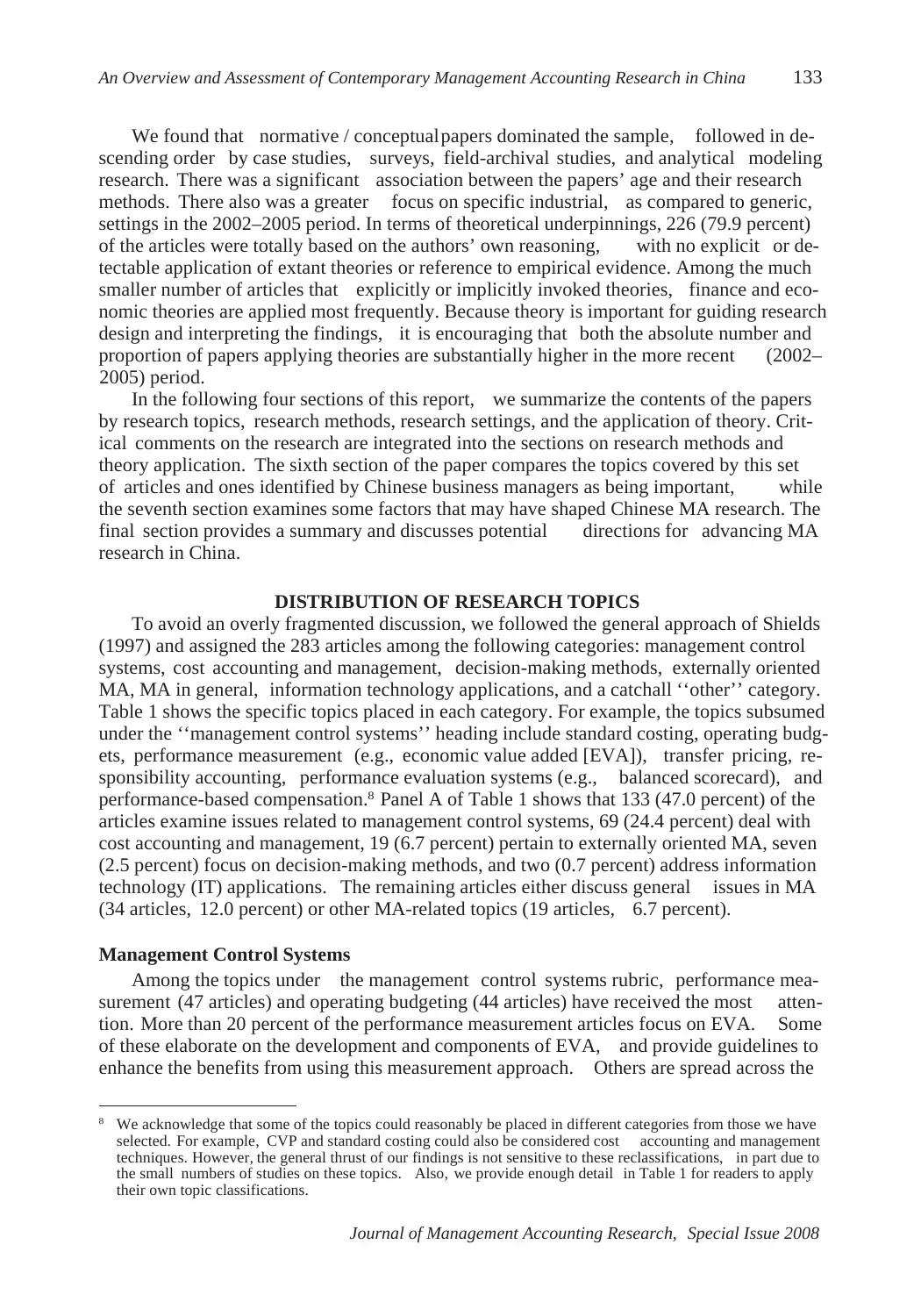
Journal of Management Accounting Research, Special Issue 2008
We found that normative / conceptualpapers dominated the sample, followed in de-
scending order by case studies, surveys, field-archival studies, and analytical modeling
research. There was a significant association between the papers’ age and their research
methods. There also was a greater focus on specific industrial, as compared to generic,
settings in the 2002–2005 period. In terms of theoretical underpinnings, 226 (79.9 percent)
of the articles were totally based on the authors’ own reasoning, with no explicit or de-
tectable application of extant theories or reference to empirical evidence. Among the much
smaller number of articles that explicitly or implicitly invoked theories, finance and eco-
nomic theories are applied most frequently. Because theory is important for guiding research
design and interpreting the findings, it is encouraging that both the absolute number and
proportion of papers applying theories are substantially higher in the more recent (2002–
2005) period.
In the following four sections of this report, we summarize the contents of the papers
by research topics, research methods, research settings, and the application of theory. Crit-
ical comments on the research are integrated into the sections on research methods and
theory application. The sixth section of the paper compares the topics covered by this set
of articles and ones identified by Chinese business managers as being important, while
the seventh section examines some factors that may have shaped Chinese MA research. The
final section provides a summary and discusses potential directions for advancing MA
research in China.
DISTRIBUTION OF RESEARCH TOPICS
To avoid an overly fragmented discussion, we followed the general approach of Shields
(1997) and assigned the 283 articles among the following categories: management control
systems, cost accounting and management, decision-making methods, externally oriented
MA, MA in general, information technology applications, and a catchall ‘‘other’’ category.
Table 1 shows the specific topics placed in each category. For example, the topics subsumed
under the ‘‘management control systems’’ heading include standard costing, operating budg-
ets, performance measurement (e.g., economic value added [EVA]), transfer pricing, re-
sponsibility accounting, performance evaluation systems (e.g., balanced scorecard), and
performance-based compensation.8 Panel A of Table 1 shows that 133 (47.0 percent) of the
articles examine issues related to management control systems, 69 (24.4 percent) deal with
cost accounting and management, 19 (6.7 percent) pertain to externally oriented MA, seven
(2.5 percent) focus on decision-making methods, and two (0.7 percent) address information
technology (IT) applications. The remaining articles either discuss general issues in MA
(34 articles, 12.0 percent) or other MA-related topics (19 articles, 6.7 percent).
Management Control Systems
Among the topics under the management control systems rubric, performance mea-
surement (47 articles) and operating budgeting (44 articles) have received the most atten-
tion. More than 20 percent of the performance measurement articles focus on EVA. Some
of these elaborate on the development and components of EVA, and provide guidelines to
enhance the benefits from using this measurement approach. Others are spread across the
8 We acknowledge that some of the topics could reasonably be placed in different categories from those we have
selected. For example, CVP and standard costing could also be considered cost accounting and management
techniques. However, the general thrust of our findings is not sensitive to these reclassifications, in part due to
the small numbers of studies on these topics. Also, we provide enough detail in Table 1 for readers to apply
their own topic classifications.
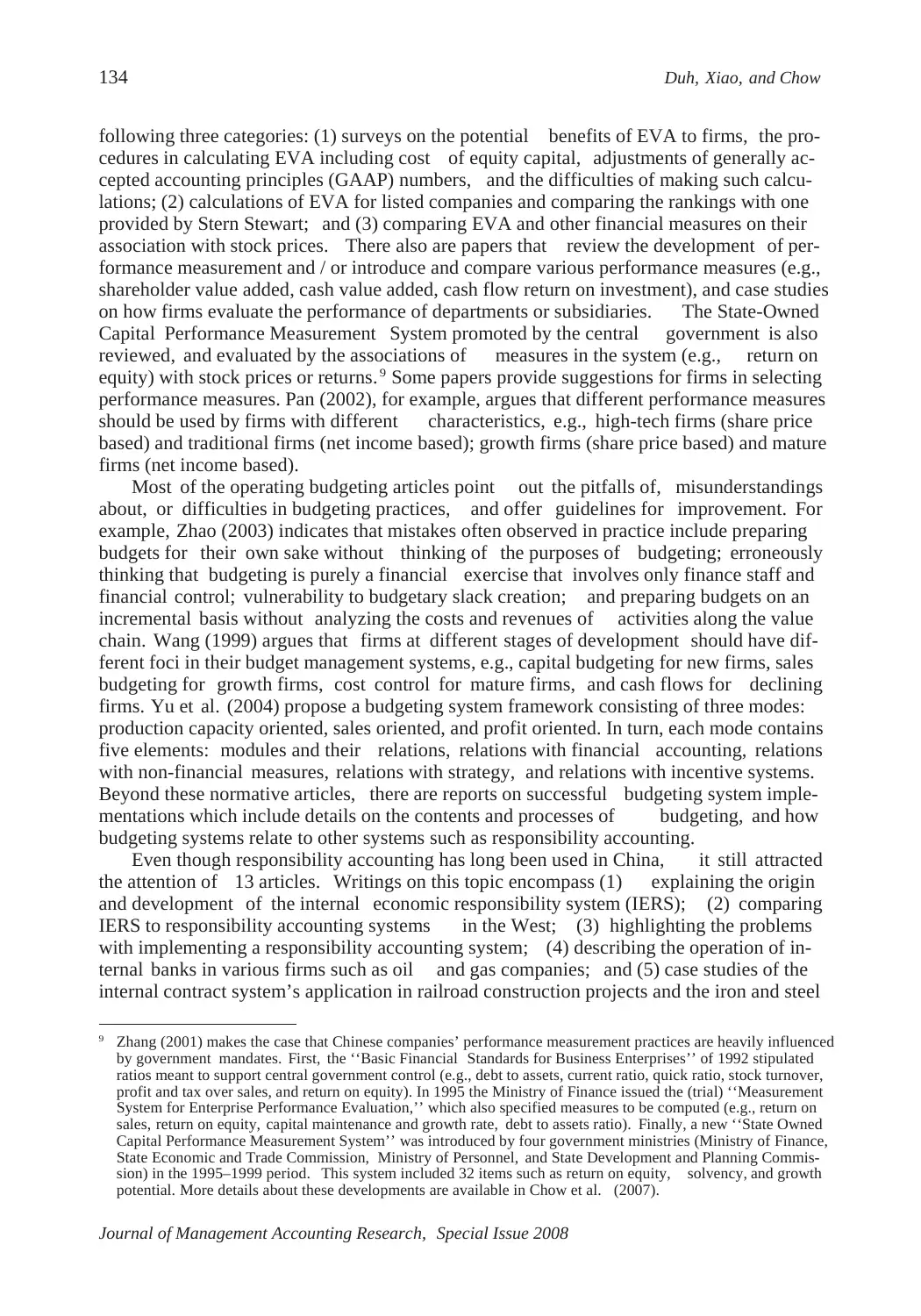
Journal of Management Accounting Research, Special Issue 2008
following three categories: (1) surveys on the potential benefits of EVA to firms, the pro-
cedures in calculating EVA including cost of equity capital, adjustments of generally ac-
cepted accounting principles (GAAP) numbers, and the difficulties of making such calcu-
lations; (2) calculations of EVA for listed companies and comparing the rankings with one
provided by Stern Stewart; and (3) comparing EVA and other financial measures on their
association with stock prices. There also are papers that review the development of per-
formance measurement and / or introduce and compare various performance measures (e.g.,
shareholder value added, cash value added, cash flow return on investment), and case studies
on how firms evaluate the performance of departments or subsidiaries. The State-Owned
Capital Performance Measurement System promoted by the central government is also
reviewed, and evaluated by the associations of measures in the system (e.g., return on
equity) with stock prices or returns. 9 Some papers provide suggestions for firms in selecting
performance measures. Pan (2002), for example, argues that different performance measures
should be used by firms with different characteristics, e.g., high-tech firms (share price
based) and traditional firms (net income based); growth firms (share price based) and mature
firms (net income based).
Most of the operating budgeting articles point out the pitfalls of, misunderstandings
about, or difficulties in budgeting practices, and offer guidelines for improvement. For
example, Zhao (2003) indicates that mistakes often observed in practice include preparing
budgets for their own sake without thinking of the purposes of budgeting; erroneously
thinking that budgeting is purely a financial exercise that involves only finance staff and
financial control; vulnerability to budgetary slack creation; and preparing budgets on an
incremental basis without analyzing the costs and revenues of activities along the value
chain. Wang (1999) argues that firms at different stages of development should have dif-
ferent foci in their budget management systems, e.g., capital budgeting for new firms, sales
budgeting for growth firms, cost control for mature firms, and cash flows for declining
firms. Yu et al. (2004) propose a budgeting system framework consisting of three modes:
production capacity oriented, sales oriented, and profit oriented. In turn, each mode contains
five elements: modules and their relations, relations with financial accounting, relations
with non-financial measures, relations with strategy, and relations with incentive systems.
Beyond these normative articles, there are reports on successful budgeting system imple-
mentations which include details on the contents and processes of budgeting, and how
budgeting systems relate to other systems such as responsibility accounting.
Even though responsibility accounting has long been used in China, it still attracted
the attention of 13 articles. Writings on this topic encompass (1) explaining the origin
and development of the internal economic responsibility system (IERS); (2) comparing
IERS to responsibility accounting systems in the West; (3) highlighting the problems
with implementing a responsibility accounting system; (4) describing the operation of in-
ternal banks in various firms such as oil and gas companies; and (5) case studies of the
internal contract system’s application in railroad construction projects and the iron and steel
9 Zhang (2001) makes the case that Chinese companies’ performance measurement practices are heavily influenced
by government mandates. First, the ‘‘Basic Financial Standards for Business Enterprises’’ of 1992 stipulated
ratios meant to support central government control (e.g., debt to assets, current ratio, quick ratio, stock turnover,
profit and tax over sales, and return on equity). In 1995 the Ministry of Finance issued the (trial) ‘‘Measurement
System for Enterprise Performance Evaluation,’’ which also specified measures to be computed (e.g., return on
sales, return on equity, capital maintenance and growth rate, debt to assets ratio). Finally, a new ‘‘State Owned
Capital Performance Measurement System’’ was introduced by four government ministries (Ministry of Finance,
State Economic and Trade Commission, Ministry of Personnel, and State Development and Planning Commis-
sion) in the 1995–1999 period. This system included 32 items such as return on equity, solvency, and growth
potential. More details about these developments are available in Chow et al. (2007).
⊘ This is a preview!⊘
Do you want full access?
Subscribe today to unlock all pages.

Trusted by 1+ million students worldwide
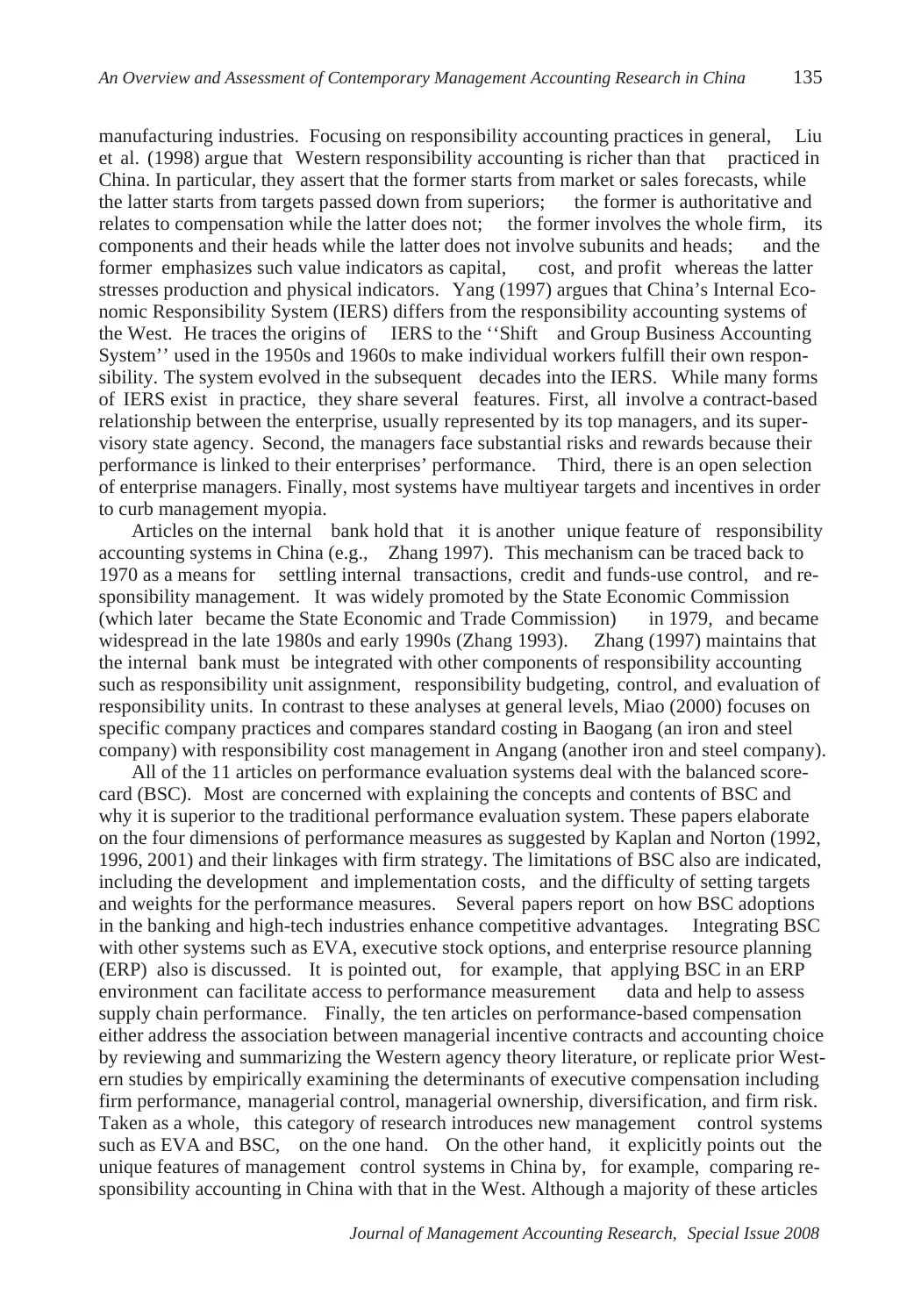
Journal of Management Accounting Research, Special Issue 2008
manufacturing industries. Focusing on responsibility accounting practices in general, Liu
et al. (1998) argue that Western responsibility accounting is richer than that practiced in
China. In particular, they assert that the former starts from market or sales forecasts, while
the latter starts from targets passed down from superiors; the former is authoritative and
relates to compensation while the latter does not; the former involves the whole firm, its
components and their heads while the latter does not involve subunits and heads; and the
former emphasizes such value indicators as capital, cost, and profit whereas the latter
stresses production and physical indicators. Yang (1997) argues that China’s Internal Eco-
nomic Responsibility System (IERS) differs from the responsibility accounting systems of
the West. He traces the origins of IERS to the ‘‘Shift and Group Business Accounting
System’’ used in the 1950s and 1960s to make individual workers fulfill their own respon-
sibility. The system evolved in the subsequent decades into the IERS. While many forms
of IERS exist in practice, they share several features. First, all involve a contract-based
relationship between the enterprise, usually represented by its top managers, and its super-
visory state agency. Second, the managers face substantial risks and rewards because their
performance is linked to their enterprises’ performance. Third, there is an open selection
of enterprise managers. Finally, most systems have multiyear targets and incentives in order
to curb management myopia.
Articles on the internal bank hold that it is another unique feature of responsibility
accounting systems in China (e.g., Zhang 1997). This mechanism can be traced back to
1970 as a means for settling internal transactions, credit and funds-use control, and re-
sponsibility management. It was widely promoted by the State Economic Commission
(which later became the State Economic and Trade Commission) in 1979, and became
widespread in the late 1980s and early 1990s (Zhang 1993). Zhang (1997) maintains that
the internal bank must be integrated with other components of responsibility accounting
such as responsibility unit assignment, responsibility budgeting, control, and evaluation of
responsibility units. In contrast to these analyses at general levels, Miao (2000) focuses on
specific company practices and compares standard costing in Baogang (an iron and steel
company) with responsibility cost management in Angang (another iron and steel company).
All of the 11 articles on performance evaluation systems deal with the balanced score-
card (BSC). Most are concerned with explaining the concepts and contents of BSC and
why it is superior to the traditional performance evaluation system. These papers elaborate
on the four dimensions of performance measures as suggested by Kaplan and Norton (1992,
1996, 2001) and their linkages with firm strategy. The limitations of BSC also are indicated,
including the development and implementation costs, and the difficulty of setting targets
and weights for the performance measures. Several papers report on how BSC adoptions
in the banking and high-tech industries enhance competitive advantages. Integrating BSC
with other systems such as EVA, executive stock options, and enterprise resource planning
(ERP) also is discussed. It is pointed out, for example, that applying BSC in an ERP
environment can facilitate access to performance measurement data and help to assess
supply chain performance. Finally, the ten articles on performance-based compensation
either address the association between managerial incentive contracts and accounting choice
by reviewing and summarizing the Western agency theory literature, or replicate prior West-
ern studies by empirically examining the determinants of executive compensation including
firm performance, managerial control, managerial ownership, diversification, and firm risk.
Taken as a whole, this category of research introduces new management control systems
such as EVA and BSC, on the one hand. On the other hand, it explicitly points out the
unique features of management control systems in China by, for example, comparing re-
sponsibility accounting in China with that in the West. Although a majority of these articles
Paraphrase This Document
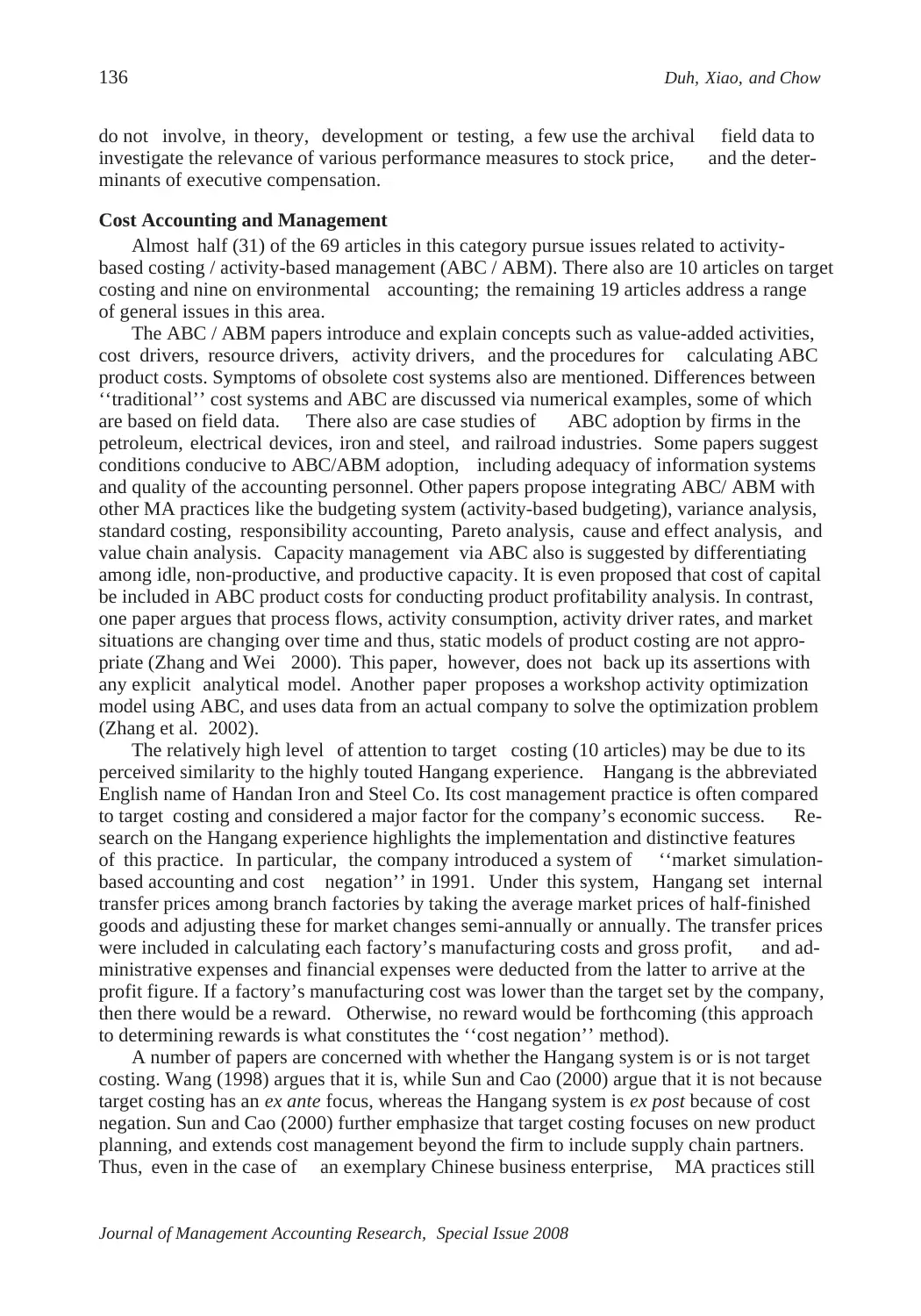
Journal of Management Accounting Research, Special Issue 2008
do not involve, in theory, development or testing, a few use the archival field data to
investigate the relevance of various performance measures to stock price, and the deter-
minants of executive compensation.
Cost Accounting and Management
Almost half (31) of the 69 articles in this category pursue issues related to activity-
based costing / activity-based management (ABC / ABM). There also are 10 articles on target
costing and nine on environmental accounting; the remaining 19 articles address a range
of general issues in this area.
The ABC / ABM papers introduce and explain concepts such as value-added activities,
cost drivers, resource drivers, activity drivers, and the procedures for calculating ABC
product costs. Symptoms of obsolete cost systems also are mentioned. Differences between
‘‘traditional’’ cost systems and ABC are discussed via numerical examples, some of which
are based on field data. There also are case studies of ABC adoption by firms in the
petroleum, electrical devices, iron and steel, and railroad industries. Some papers suggest
conditions conducive to ABC/ABM adoption, including adequacy of information systems
and quality of the accounting personnel. Other papers propose integrating ABC/ ABM with
other MA practices like the budgeting system (activity-based budgeting), variance analysis,
standard costing, responsibility accounting, Pareto analysis, cause and effect analysis, and
value chain analysis. Capacity management via ABC also is suggested by differentiating
among idle, non-productive, and productive capacity. It is even proposed that cost of capital
be included in ABC product costs for conducting product profitability analysis. In contrast,
one paper argues that process flows, activity consumption, activity driver rates, and market
situations are changing over time and thus, static models of product costing are not appro-
priate (Zhang and Wei 2000). This paper, however, does not back up its assertions with
any explicit analytical model. Another paper proposes a workshop activity optimization
model using ABC, and uses data from an actual company to solve the optimization problem
(Zhang et al. 2002).
The relatively high level of attention to target costing (10 articles) may be due to its
perceived similarity to the highly touted Hangang experience. Hangang is the abbreviated
English name of Handan Iron and Steel Co. Its cost management practice is often compared
to target costing and considered a major factor for the company’s economic success. Re-
search on the Hangang experience highlights the implementation and distinctive features
of this practice. In particular, the company introduced a system of ‘‘market simulation-
based accounting and cost negation’’ in 1991. Under this system, Hangang set internal
transfer prices among branch factories by taking the average market prices of half-finished
goods and adjusting these for market changes semi-annually or annually. The transfer prices
were included in calculating each factory’s manufacturing costs and gross profit, and ad-
ministrative expenses and financial expenses were deducted from the latter to arrive at the
profit figure. If a factory’s manufacturing cost was lower than the target set by the company,
then there would be a reward. Otherwise, no reward would be forthcoming (this approach
to determining rewards is what constitutes the ‘‘cost negation’’ method).
A number of papers are concerned with whether the Hangang system is or is not target
costing. Wang (1998) argues that it is, while Sun and Cao (2000) argue that it is not because
target costing has an ex ante focus, whereas the Hangang system is ex post because of cost
negation. Sun and Cao (2000) further emphasize that target costing focuses on new product
planning, and extends cost management beyond the firm to include supply chain partners.
Thus, even in the case of an exemplary Chinese business enterprise, MA practices still
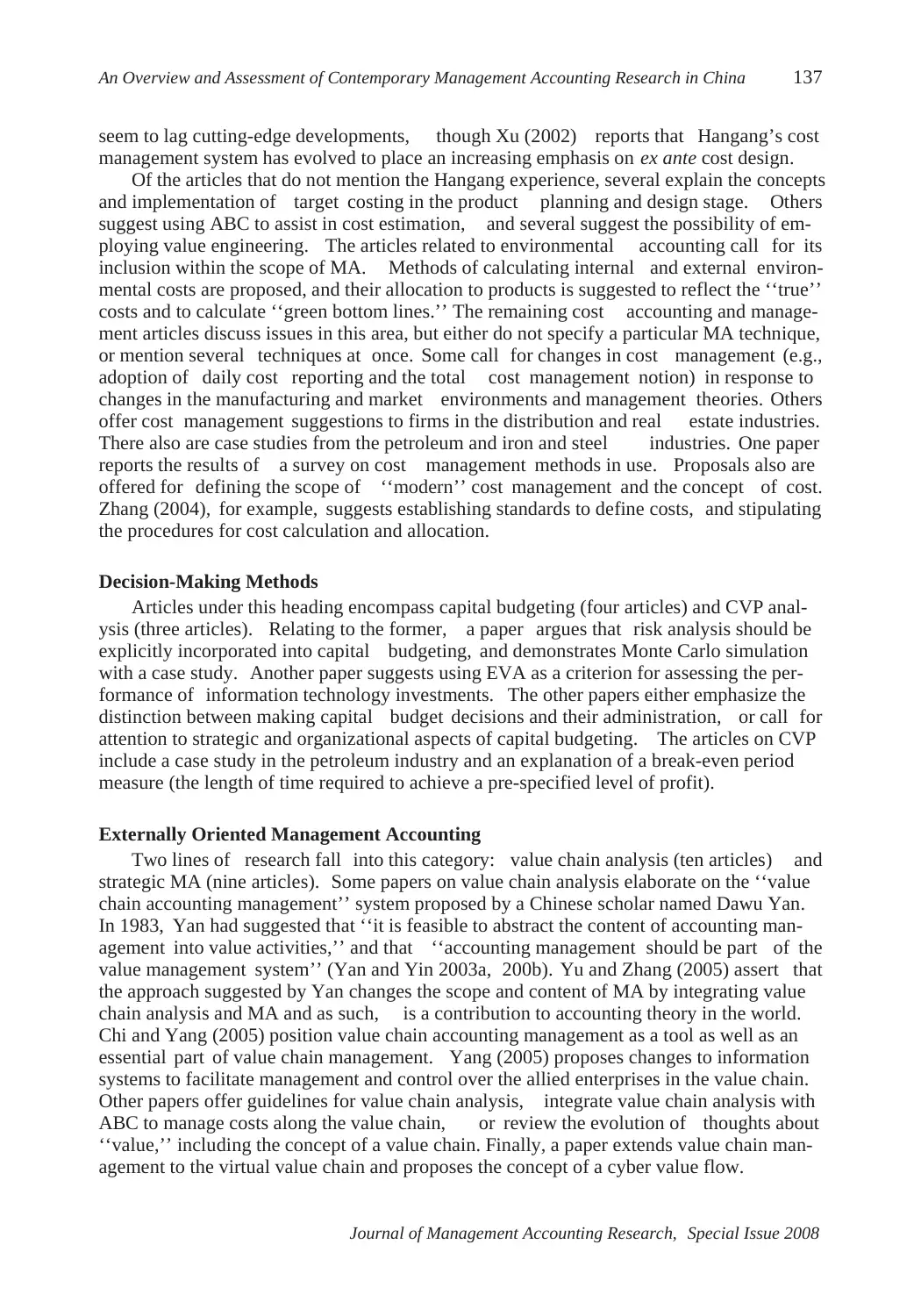
Journal of Management Accounting Research, Special Issue 2008
seem to lag cutting-edge developments, though Xu (2002) reports that Hangang’s cost
management system has evolved to place an increasing emphasis on ex ante cost design.
Of the articles that do not mention the Hangang experience, several explain the concepts
and implementation of target costing in the product planning and design stage. Others
suggest using ABC to assist in cost estimation, and several suggest the possibility of em-
ploying value engineering. The articles related to environmental accounting call for its
inclusion within the scope of MA. Methods of calculating internal and external environ-
mental costs are proposed, and their allocation to products is suggested to reflect the ‘‘true’’
costs and to calculate ‘‘green bottom lines.’’ The remaining cost accounting and manage-
ment articles discuss issues in this area, but either do not specify a particular MA technique,
or mention several techniques at once. Some call for changes in cost management (e.g.,
adoption of daily cost reporting and the total cost management notion) in response to
changes in the manufacturing and market environments and management theories. Others
offer cost management suggestions to firms in the distribution and real estate industries.
There also are case studies from the petroleum and iron and steel industries. One paper
reports the results of a survey on cost management methods in use. Proposals also are
offered for defining the scope of ‘‘modern’’ cost management and the concept of cost.
Zhang (2004), for example, suggests establishing standards to define costs, and stipulating
the procedures for cost calculation and allocation.
Decision-Making Methods
Articles under this heading encompass capital budgeting (four articles) and CVP anal-
ysis (three articles). Relating to the former, a paper argues that risk analysis should be
explicitly incorporated into capital budgeting, and demonstrates Monte Carlo simulation
with a case study. Another paper suggests using EVA as a criterion for assessing the per-
formance of information technology investments. The other papers either emphasize the
distinction between making capital budget decisions and their administration, or call for
attention to strategic and organizational aspects of capital budgeting. The articles on CVP
include a case study in the petroleum industry and an explanation of a break-even period
measure (the length of time required to achieve a pre-specified level of profit).
Externally Oriented Management Accounting
Two lines of research fall into this category: value chain analysis (ten articles) and
strategic MA (nine articles). Some papers on value chain analysis elaborate on the ‘‘value
chain accounting management’’ system proposed by a Chinese scholar named Dawu Yan.
In 1983, Yan had suggested that ‘‘it is feasible to abstract the content of accounting man-
agement into value activities,’’ and that ‘‘accounting management should be part of the
value management system’’ (Yan and Yin 2003a, 200b). Yu and Zhang (2005) assert that
the approach suggested by Yan changes the scope and content of MA by integrating value
chain analysis and MA and as such, is a contribution to accounting theory in the world.
Chi and Yang (2005) position value chain accounting management as a tool as well as an
essential part of value chain management. Yang (2005) proposes changes to information
systems to facilitate management and control over the allied enterprises in the value chain.
Other papers offer guidelines for value chain analysis, integrate value chain analysis with
ABC to manage costs along the value chain, or review the evolution of thoughts about
‘‘value,’’ including the concept of a value chain. Finally, a paper extends value chain man-
agement to the virtual value chain and proposes the concept of a cyber value flow.
⊘ This is a preview!⊘
Do you want full access?
Subscribe today to unlock all pages.

Trusted by 1+ million students worldwide
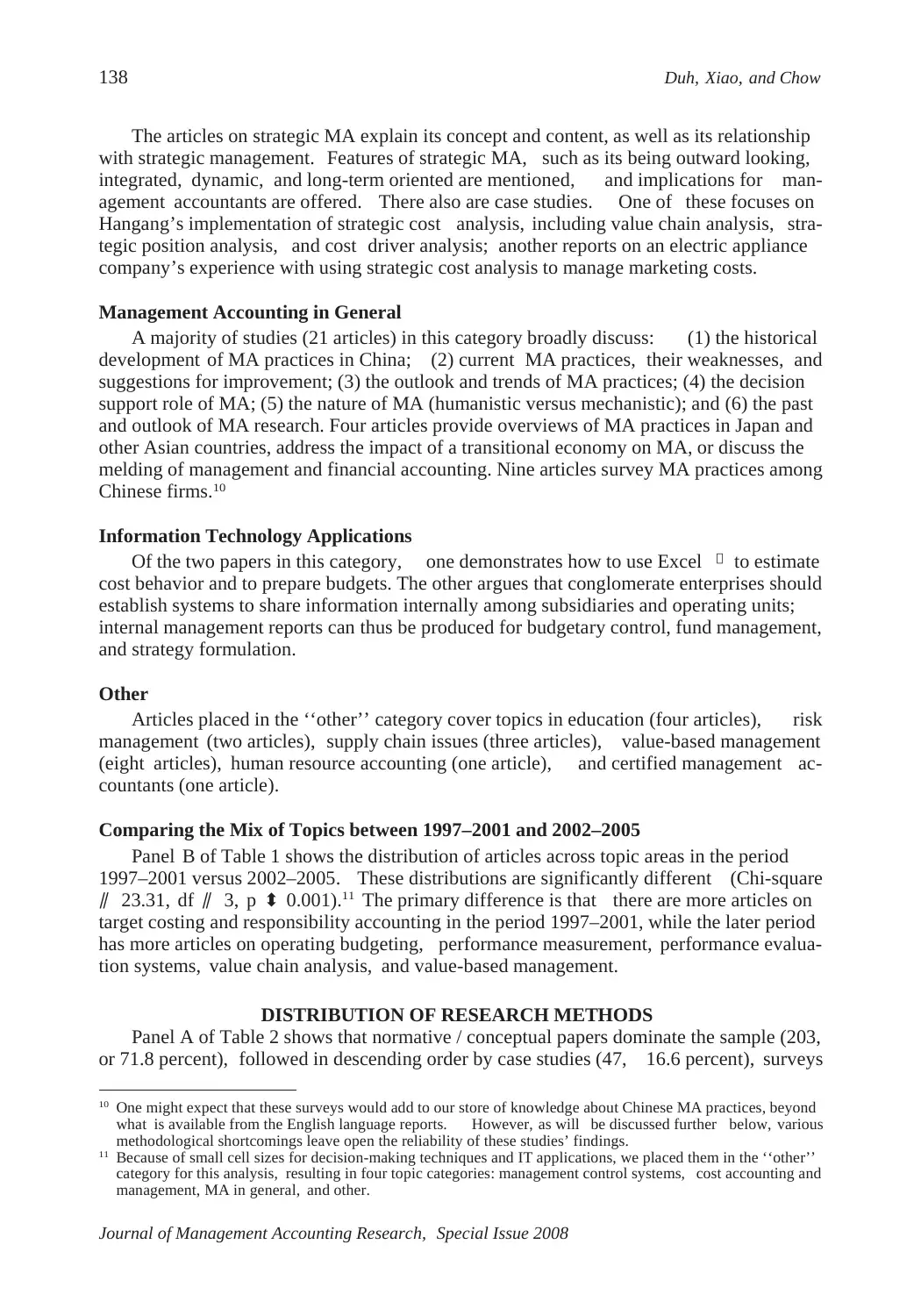
Journal of Management Accounting Research, Special Issue 2008
The articles on strategic MA explain its concept and content, as well as its relationship
with strategic management. Features of strategic MA, such as its being outward looking,
integrated, dynamic, and long-term oriented are mentioned, and implications for man-
agement accountants are offered. There also are case studies. One of these focuses on
Hangang’s implementation of strategic cost analysis, including value chain analysis, stra-
tegic position analysis, and cost driver analysis; another reports on an electric appliance
company’s experience with using strategic cost analysis to manage marketing costs.
Management Accounting in General
A majority of studies (21 articles) in this category broadly discuss: (1) the historical
development of MA practices in China; (2) current MA practices, their weaknesses, and
suggestions for improvement; (3) the outlook and trends of MA practices; (4) the decision
support role of MA; (5) the nature of MA (humanistic versus mechanistic); and (6) the past
and outlook of MA research. Four articles provide overviews of MA practices in Japan and
other Asian countries, address the impact of a transitional economy on MA, or discuss the
melding of management and financial accounting. Nine articles survey MA practices among
Chinese firms. 10
Information Technology Applications
Of the two papers in this category, one demonstrates how to use Excel 䉸 to estimate
cost behavior and to prepare budgets. The other argues that conglomerate enterprises should
establish systems to share information internally among subsidiaries and operating units;
internal management reports can thus be produced for budgetary control, fund management,
and strategy formulation.
Other
Articles placed in the ‘‘other’’ category cover topics in education (four articles), risk
management (two articles), supply chain issues (three articles), value-based management
(eight articles), human resource accounting (one article), and certified management ac-
countants (one article).
Comparing the Mix of Topics between 1997–2001 and 2002–2005
Panel B of Table 1 shows the distribution of articles across topic areas in the period
1997–2001 versus 2002–2005. These distributions are significantly different (Chi-square
⫽ 23.31, df ⫽ 3, p ⬍ 0.001).11 The primary difference is that there are more articles on
target costing and responsibility accounting in the period 1997–2001, while the later period
has more articles on operating budgeting, performance measurement, performance evalua-
tion systems, value chain analysis, and value-based management.
DISTRIBUTION OF RESEARCH METHODS
Panel A of Table 2 shows that normative / conceptual papers dominate the sample (203,
or 71.8 percent), followed in descending order by case studies (47, 16.6 percent), surveys
10 One might expect that these surveys would add to our store of knowledge about Chinese MA practices, beyond
what is available from the English language reports. However, as will be discussed further below, various
methodological shortcomings leave open the reliability of these studies’ findings.
11 Because of small cell sizes for decision-making techniques and IT applications, we placed them in the ‘‘other’’
category for this analysis, resulting in four topic categories: management control systems, cost accounting and
management, MA in general, and other.
Paraphrase This Document
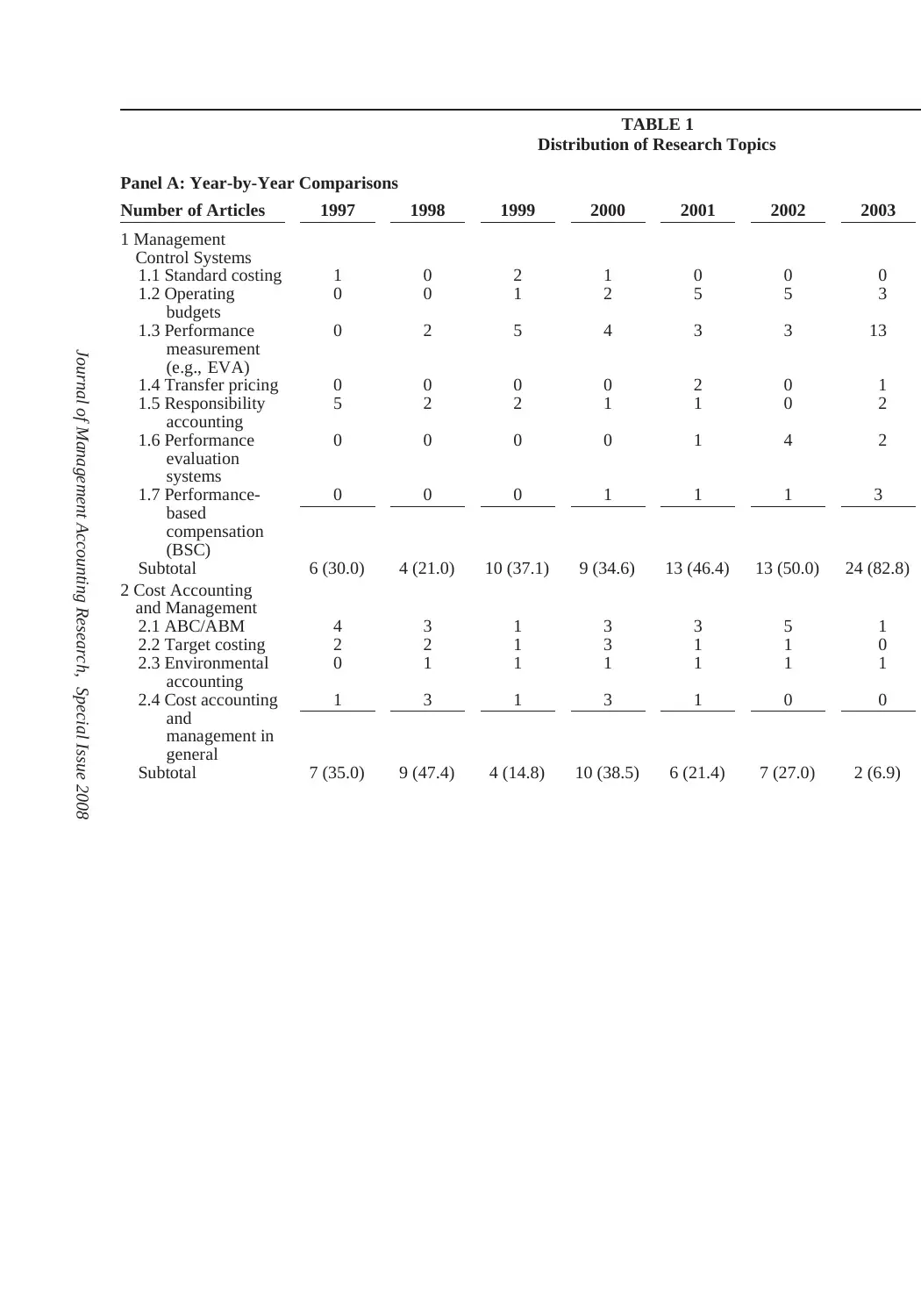
TABLE 1
Distribution of Research Topics
Panel A: Year-by-Year Comparisons
Number of Articles 1997 1998 1999 2000 2001 2002 2003
1 Management
Control Systems
1.1 Standard costing 1 0 2 1 0 0 0
1.2 Operating
budgets
0 0 1 2 5 5 3
1.3 Performance
measurement
(e.g., EVA)
0 2 5 4 3 3 13
1.4 Transfer pricing 0 0 0 0 2 0 1
1.5 Responsibility
accounting
5 2 2 1 1 0 2
1.6 Performance
evaluation
systems
0 0 0 0 1 4 2
1.7 Performance-
based
compensation
(BSC)
0 0 0 1 1 1 3
Subtotal 6 (30.0) 4 (21.0) 10 (37.1) 9 (34.6) 13 (46.4) 13 (50.0) 24 (82.8)
2 Cost Accounting
and Management
2.1 ABC/ABM 4 3 1 3 3 5 1
2.2 Target costing 2 2 1 3 1 1 0
2.3 Environmental
accounting
0 1 1 1 1 1 1
2.4 Cost accounting
and
management in
general
1 3 1 3 1 0 0
Subtotal 7 (35.0) 9 (47.4) 4 (14.8) 10 (38.5) 6 (21.4) 7 (27.0) 2 (6.9)
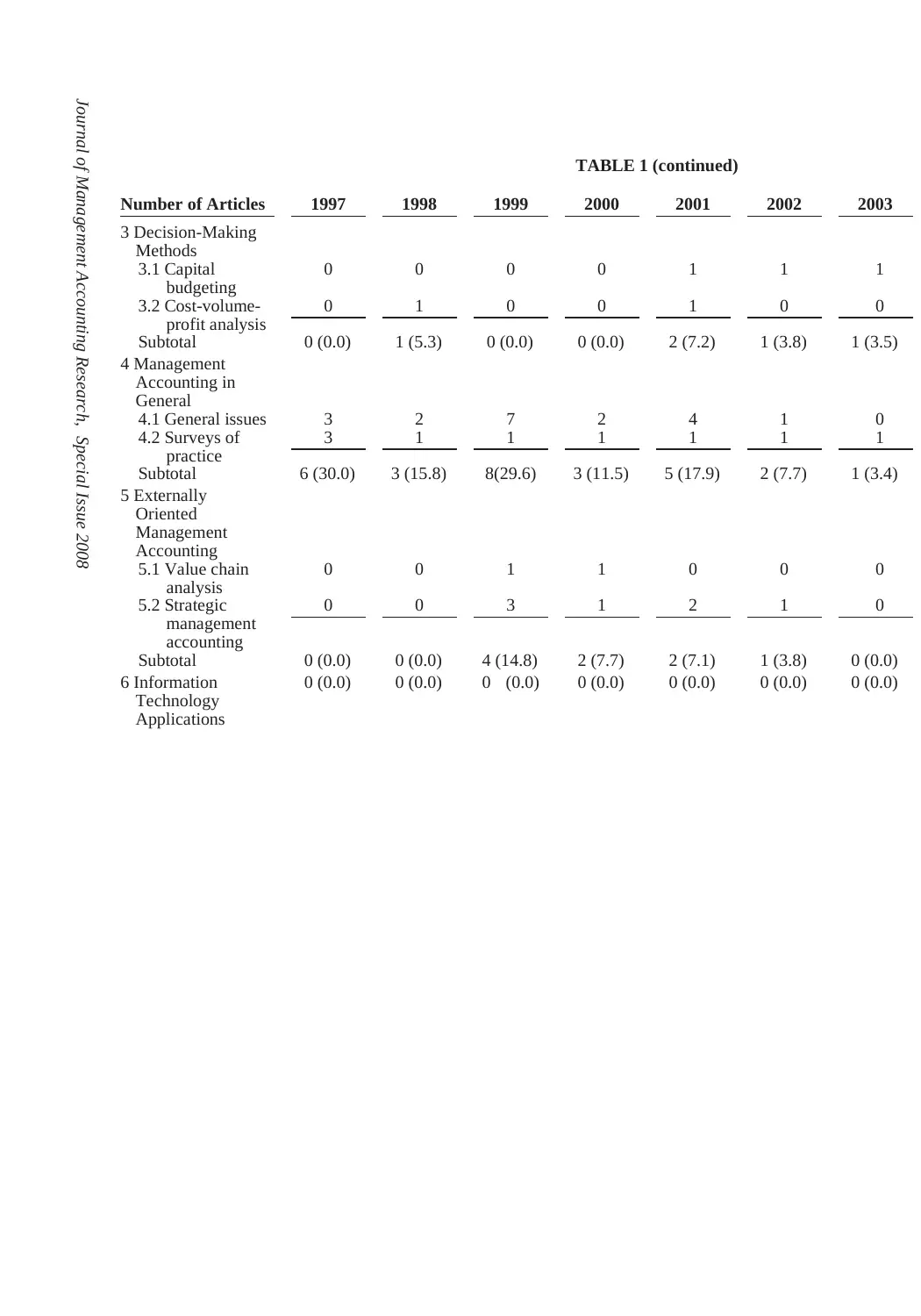
TABLE 1 (continued)
Number of Articles 1997 1998 1999 2000 2001 2002 2003
3 Decision-Making
Methods
3.1 Capital
budgeting
0 0 0 0 1 1 1
3.2 Cost-volume-
profit analysis
0 1 0 0 1 0 0
Subtotal 0 (0.0) 1 (5.3) 0 (0.0) 0 (0.0) 2 (7.2) 1 (3.8) 1 (3.5)
4 Management
Accounting in
General
4.1 General issues 3 2 7 2 4 1 0
4.2 Surveys of
practice
3 1 1 1 1 1 1
Subtotal 6 (30.0) 3 (15.8) 8(29.6) 3 (11.5) 5 (17.9) 2 (7.7) 1 (3.4)
5 Externally
Oriented
Management
Accounting
5.1 Value chain
analysis
0 0 1 1 0 0 0
5.2 Strategic
management
accounting
0 0 3 1 2 1 0
Subtotal 0 (0.0) 0 (0.0) 4 (14.8) 2 (7.7) 2 (7.1) 1 (3.8) 0 (0.0)
6 Information
Technology
Applications
0 (0.0) 0 (0.0) 0 (0.0) 0 (0.0) 0 (0.0) 0 (0.0) 0 (0.0)
⊘ This is a preview!⊘
Do you want full access?
Subscribe today to unlock all pages.

Trusted by 1+ million students worldwide
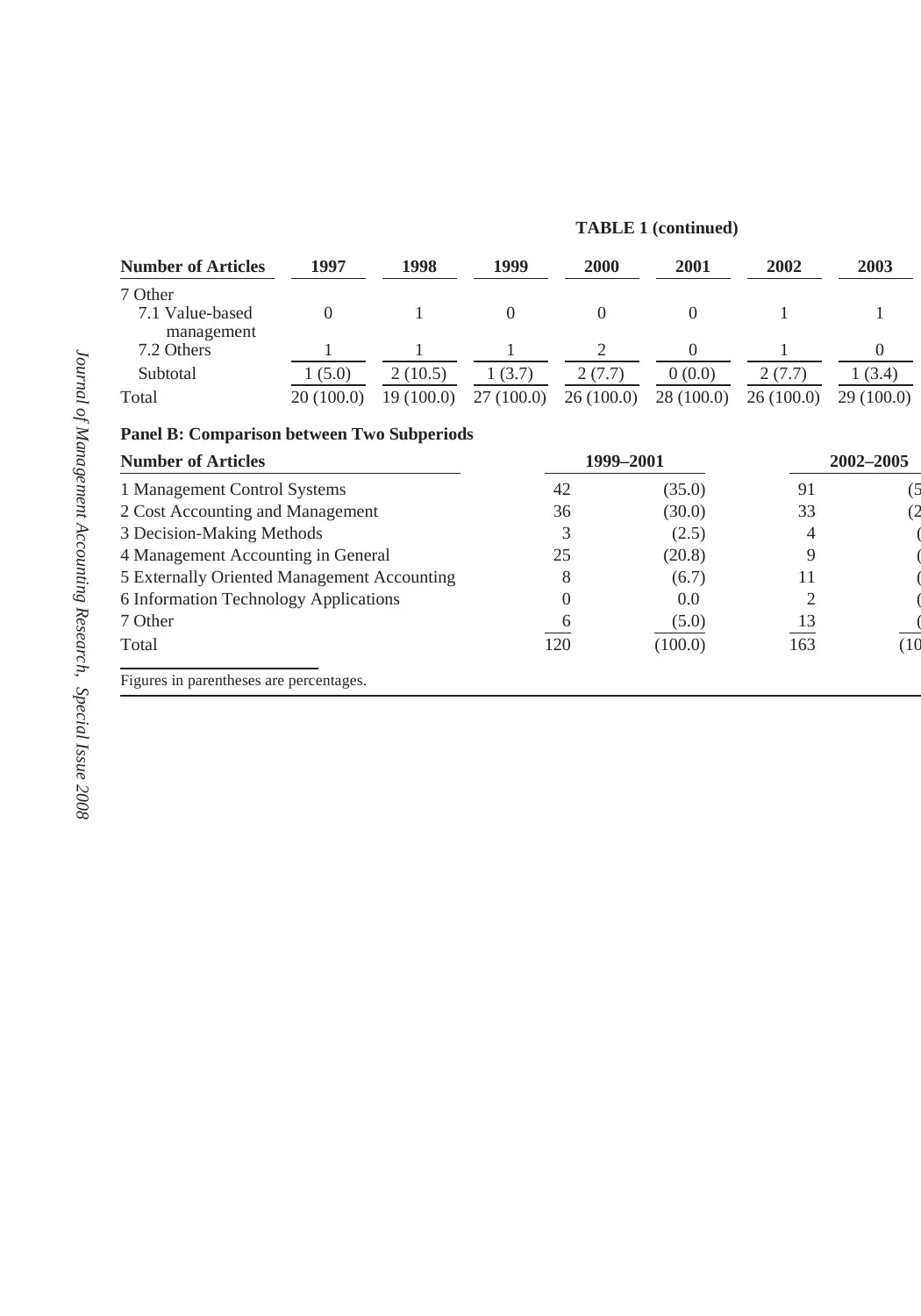
TABLE 1 (continued)
Number of Articles 1997 1998 1999 2000 2001 2002 2003
7 Other
7.1 Value-based
management
0 1 0 0 0 1 1
7.2 Others 1 1 1 2 0 1 0
Subtotal 1 (5.0) 2 (10.5) 1 (3.7) 2 (7.7) 0 (0.0) 2 (7.7) 1 (3.4)
Total 20 (100.0) 19 (100.0) 27 (100.0) 26 (100.0) 28 (100.0) 26 (100.0) 29 (100.0)
Panel B: Comparison between Two Subperiods
Number of Articles 1999–2001 2002–2005
1 Management Control Systems 42 (35.0) 91 (5
2 Cost Accounting and Management 36 (30.0) 33 (2
3 Decision-Making Methods 3 (2.5) 4 (
4 Management Accounting in General 25 (20.8) 9 (
5 Externally Oriented Management Accounting 8 (6.7) 11 (
6 Information Technology Applications 0 0.0 2 (
7 Other 6 (5.0) 13 (
Total 120 (100.0) 163 (10
Figures in parentheses are percentages.
Paraphrase This Document
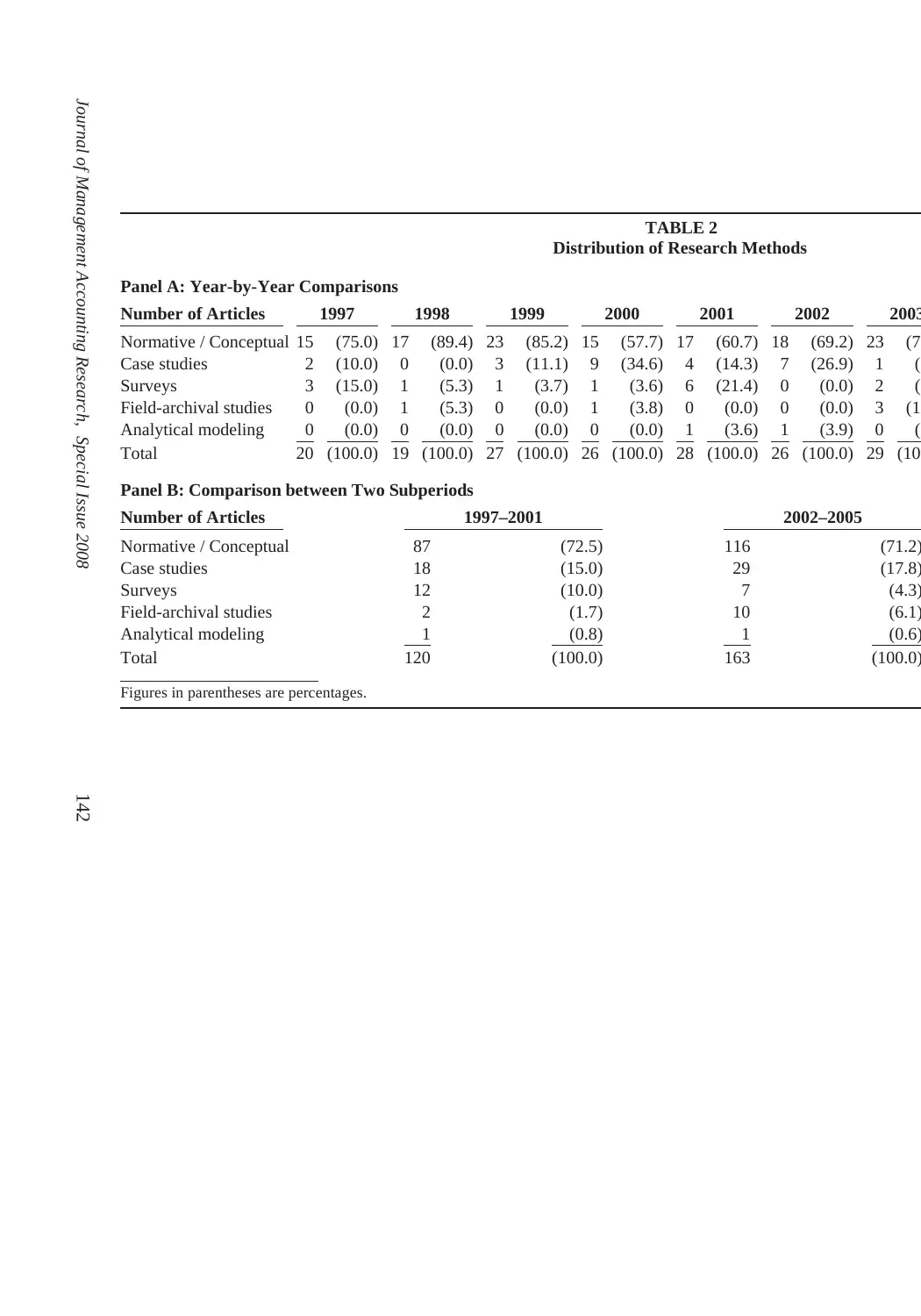
TABLE 2
Distribution of Research Methods
Panel A: Year-by-Year Comparisons
Number of Articles 1997 1998 1999 2000 2001 2002 2003
Normative / Conceptual 15 (75.0) 17 (89.4) 23 (85.2) 15 (57.7) 17 (60.7) 18 (69.2) 23 (79
Case studies 2 (10.0) 0 (0.0) 3 (11.1) 9 (34.6) 4 (14.3) 7 (26.9) 1 (3
Surveys 3 (15.0) 1 (5.3) 1 (3.7) 1 (3.6) 6 (21.4) 0 (0.0) 2 (6
Field-archival studies 0 (0.0) 1 (5.3) 0 (0.0) 1 (3.8) 0 (0.0) 0 (0.0) 3 (10
Analytical modeling 0 (0.0) 0 (0.0) 0 (0.0) 0 (0.0) 1 (3.6) 1 (3.9) 0 (0
Total 20 (100.0) 19 (100.0) 27 (100.0) 26 (100.0) 28 (100.0) 26 (100.0) 29 (100
Panel B: Comparison between Two Subperiods
Number of Articles 1997–2001 2002–2005
Normative / Conceptual 87 (72.5) 116 (71.2)
Case studies 18 (15.0) 29 (17.8)
Surveys 12 (10.0) 7 (4.3)
Field-archival studies 2 (1.7) 10 (6.1)
Analytical modeling 1 (0.8) 1 (0.6)
Total 120 (100.0) 163 (100.0)
Figures in parentheses are percentages.
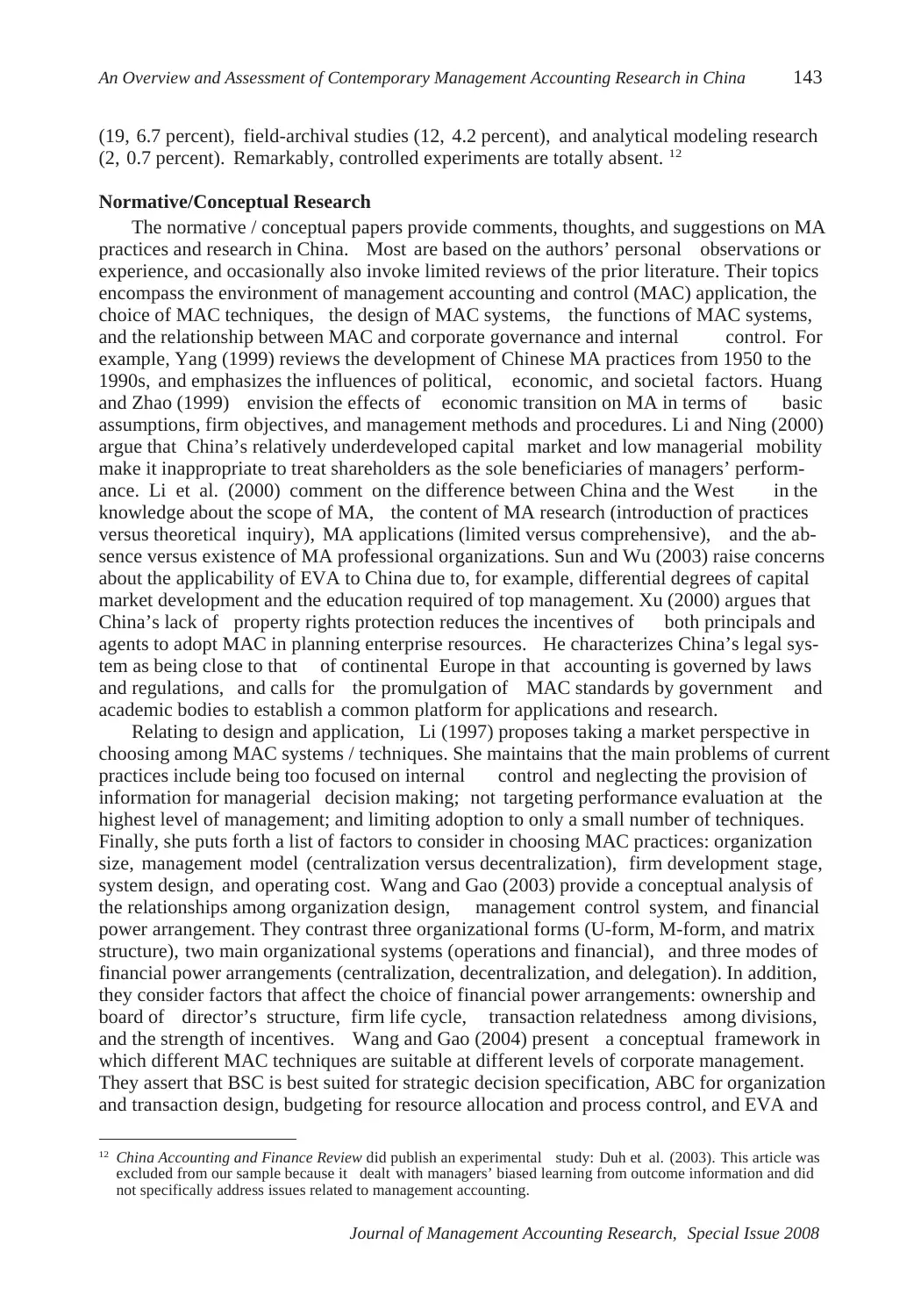
Journal of Management Accounting Research, Special Issue 2008
(19, 6.7 percent), field-archival studies (12, 4.2 percent), and analytical modeling research
(2, 0.7 percent). Remarkably, controlled experiments are totally absent. 12
Normative/Conceptual Research
The normative / conceptual papers provide comments, thoughts, and suggestions on MA
practices and research in China. Most are based on the authors’ personal observations or
experience, and occasionally also invoke limited reviews of the prior literature. Their topics
encompass the environment of management accounting and control (MAC) application, the
choice of MAC techniques, the design of MAC systems, the functions of MAC systems,
and the relationship between MAC and corporate governance and internal control. For
example, Yang (1999) reviews the development of Chinese MA practices from 1950 to the
1990s, and emphasizes the influences of political, economic, and societal factors. Huang
and Zhao (1999) envision the effects of economic transition on MA in terms of basic
assumptions, firm objectives, and management methods and procedures. Li and Ning (2000)
argue that China’s relatively underdeveloped capital market and low managerial mobility
make it inappropriate to treat shareholders as the sole beneficiaries of managers’ perform-
ance. Li et al. (2000) comment on the difference between China and the West in the
knowledge about the scope of MA, the content of MA research (introduction of practices
versus theoretical inquiry), MA applications (limited versus comprehensive), and the ab-
sence versus existence of MA professional organizations. Sun and Wu (2003) raise concerns
about the applicability of EVA to China due to, for example, differential degrees of capital
market development and the education required of top management. Xu (2000) argues that
China’s lack of property rights protection reduces the incentives of both principals and
agents to adopt MAC in planning enterprise resources. He characterizes China’s legal sys-
tem as being close to that of continental Europe in that accounting is governed by laws
and regulations, and calls for the promulgation of MAC standards by government and
academic bodies to establish a common platform for applications and research.
Relating to design and application, Li (1997) proposes taking a market perspective in
choosing among MAC systems / techniques. She maintains that the main problems of current
practices include being too focused on internal control and neglecting the provision of
information for managerial decision making; not targeting performance evaluation at the
highest level of management; and limiting adoption to only a small number of techniques.
Finally, she puts forth a list of factors to consider in choosing MAC practices: organization
size, management model (centralization versus decentralization), firm development stage,
system design, and operating cost. Wang and Gao (2003) provide a conceptual analysis of
the relationships among organization design, management control system, and financial
power arrangement. They contrast three organizational forms (U-form, M-form, and matrix
structure), two main organizational systems (operations and financial), and three modes of
financial power arrangements (centralization, decentralization, and delegation). In addition,
they consider factors that affect the choice of financial power arrangements: ownership and
board of director’s structure, firm life cycle, transaction relatedness among divisions,
and the strength of incentives. Wang and Gao (2004) present a conceptual framework in
which different MAC techniques are suitable at different levels of corporate management.
They assert that BSC is best suited for strategic decision specification, ABC for organization
and transaction design, budgeting for resource allocation and process control, and EVA and
12 China Accounting and Finance Review did publish an experimental study: Duh et al. (2003). This article was
excluded from our sample because it dealt with managers’ biased learning from outcome information and did
not specifically address issues related to management accounting.
⊘ This is a preview!⊘
Do you want full access?
Subscribe today to unlock all pages.

Trusted by 1+ million students worldwide
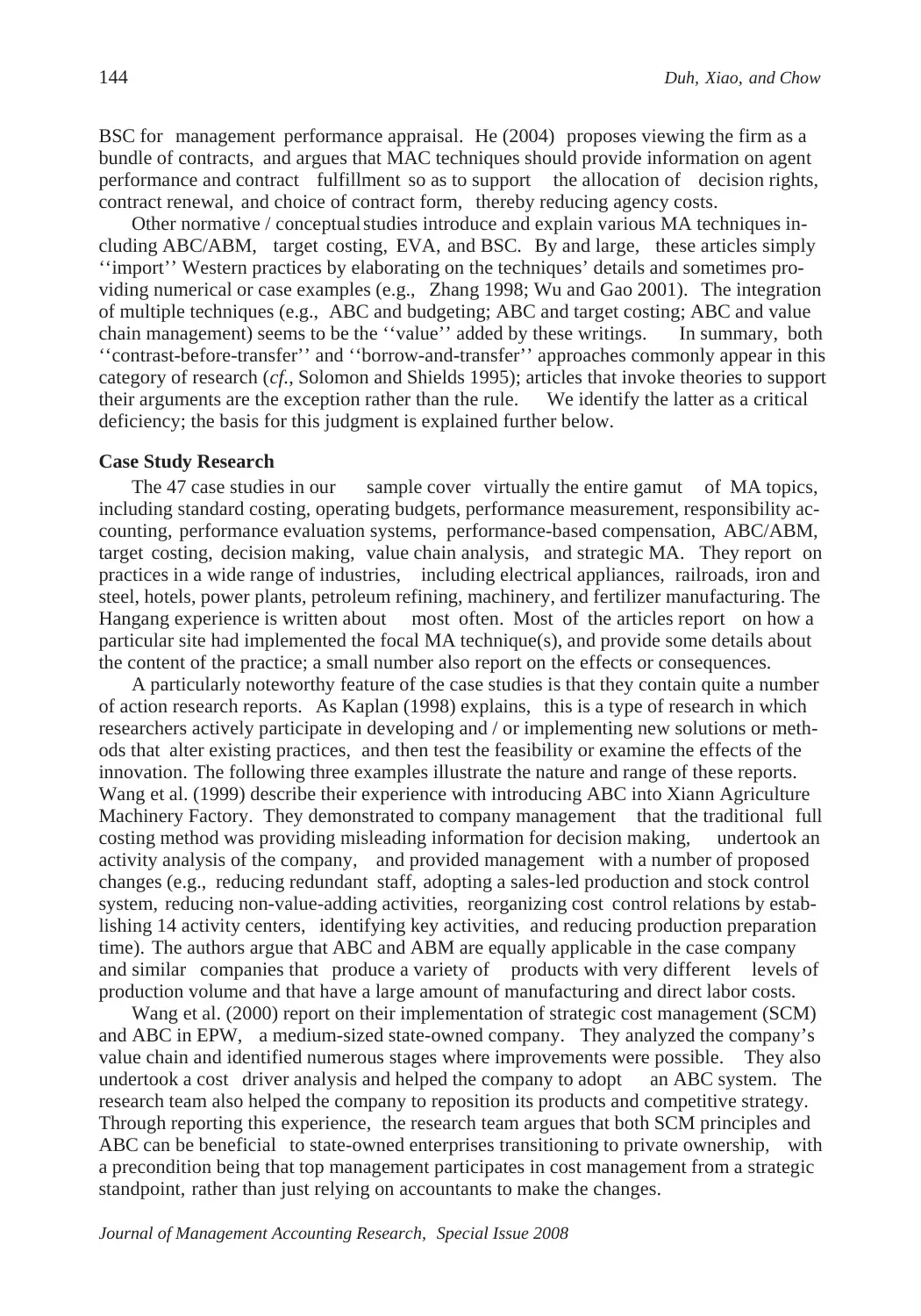
Journal of Management Accounting Research, Special Issue 2008
BSC for management performance appraisal. He (2004) proposes viewing the firm as a
bundle of contracts, and argues that MAC techniques should provide information on agent
performance and contract fulfillment so as to support the allocation of decision rights,
contract renewal, and choice of contract form, thereby reducing agency costs.
Other normative / conceptual studies introduce and explain various MA techniques in-
cluding ABC/ABM, target costing, EVA, and BSC. By and large, these articles simply
‘‘import’’ Western practices by elaborating on the techniques’ details and sometimes pro-
viding numerical or case examples (e.g., Zhang 1998; Wu and Gao 2001). The integration
of multiple techniques (e.g., ABC and budgeting; ABC and target costing; ABC and value
chain management) seems to be the ‘‘value’’ added by these writings. In summary, both
‘‘contrast-before-transfer’’ and ‘‘borrow-and-transfer’’ approaches commonly appear in this
category of research (cf., Solomon and Shields 1995); articles that invoke theories to support
their arguments are the exception rather than the rule. We identify the latter as a critical
deficiency; the basis for this judgment is explained further below.
Case Study Research
The 47 case studies in our sample cover virtually the entire gamut of MA topics,
including standard costing, operating budgets, performance measurement, responsibility ac-
counting, performance evaluation systems, performance-based compensation, ABC/ABM,
target costing, decision making, value chain analysis, and strategic MA. They report on
practices in a wide range of industries, including electrical appliances, railroads, iron and
steel, hotels, power plants, petroleum refining, machinery, and fertilizer manufacturing. The
Hangang experience is written about most often. Most of the articles report on how a
particular site had implemented the focal MA technique(s), and provide some details about
the content of the practice; a small number also report on the effects or consequences.
A particularly noteworthy feature of the case studies is that they contain quite a number
of action research reports. As Kaplan (1998) explains, this is a type of research in which
researchers actively participate in developing and / or implementing new solutions or meth-
ods that alter existing practices, and then test the feasibility or examine the effects of the
innovation. The following three examples illustrate the nature and range of these reports.
Wang et al. (1999) describe their experience with introducing ABC into Xiann Agriculture
Machinery Factory. They demonstrated to company management that the traditional full
costing method was providing misleading information for decision making, undertook an
activity analysis of the company, and provided management with a number of proposed
changes (e.g., reducing redundant staff, adopting a sales-led production and stock control
system, reducing non-value-adding activities, reorganizing cost control relations by estab-
lishing 14 activity centers, identifying key activities, and reducing production preparation
time). The authors argue that ABC and ABM are equally applicable in the case company
and similar companies that produce a variety of products with very different levels of
production volume and that have a large amount of manufacturing and direct labor costs.
Wang et al. (2000) report on their implementation of strategic cost management (SCM)
and ABC in EPW, a medium-sized state-owned company. They analyzed the company’s
value chain and identified numerous stages where improvements were possible. They also
undertook a cost driver analysis and helped the company to adopt an ABC system. The
research team also helped the company to reposition its products and competitive strategy.
Through reporting this experience, the research team argues that both SCM principles and
ABC can be beneficial to state-owned enterprises transitioning to private ownership, with
a precondition being that top management participates in cost management from a strategic
standpoint, rather than just relying on accountants to make the changes.
Paraphrase This Document
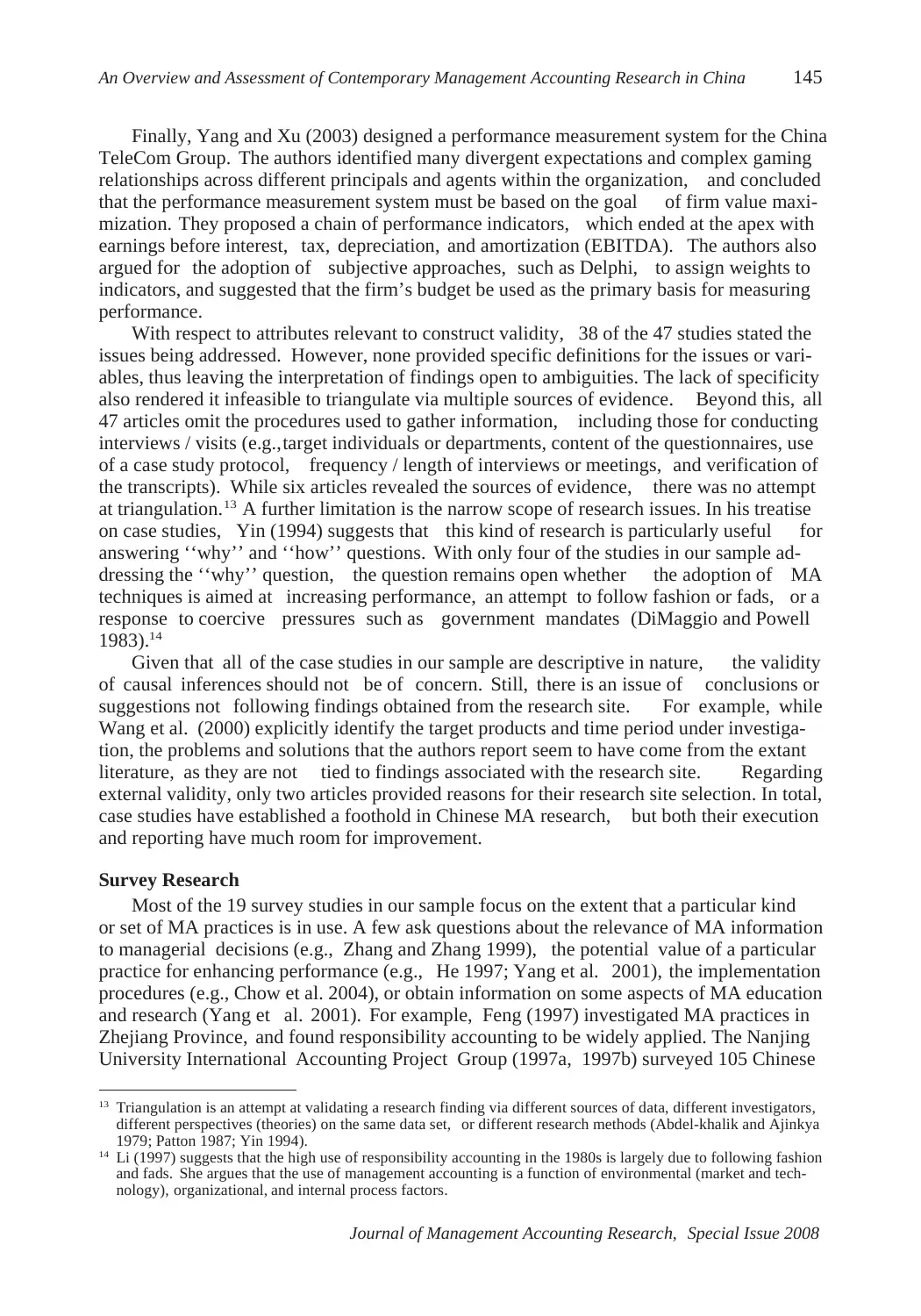
Journal of Management Accounting Research, Special Issue 2008
Finally, Yang and Xu (2003) designed a performance measurement system for the China
TeleCom Group. The authors identified many divergent expectations and complex gaming
relationships across different principals and agents within the organization, and concluded
that the performance measurement system must be based on the goal of firm value maxi-
mization. They proposed a chain of performance indicators, which ended at the apex with
earnings before interest, tax, depreciation, and amortization (EBITDA). The authors also
argued for the adoption of subjective approaches, such as Delphi, to assign weights to
indicators, and suggested that the firm’s budget be used as the primary basis for measuring
performance.
With respect to attributes relevant to construct validity, 38 of the 47 studies stated the
issues being addressed. However, none provided specific definitions for the issues or vari-
ables, thus leaving the interpretation of findings open to ambiguities. The lack of specificity
also rendered it infeasible to triangulate via multiple sources of evidence. Beyond this, all
47 articles omit the procedures used to gather information, including those for conducting
interviews / visits (e.g.,target individuals or departments, content of the questionnaires, use
of a case study protocol, frequency / length of interviews or meetings, and verification of
the transcripts). While six articles revealed the sources of evidence, there was no attempt
at triangulation. 13 A further limitation is the narrow scope of research issues. In his treatise
on case studies, Yin (1994) suggests that this kind of research is particularly useful for
answering ‘‘why’’ and ‘‘how’’ questions. With only four of the studies in our sample ad-
dressing the ‘‘why’’ question, the question remains open whether the adoption of MA
techniques is aimed at increasing performance, an attempt to follow fashion or fads, or a
response to coercive pressures such as government mandates (DiMaggio and Powell
1983).14
Given that all of the case studies in our sample are descriptive in nature, the validity
of causal inferences should not be of concern. Still, there is an issue of conclusions or
suggestions not following findings obtained from the research site. For example, while
Wang et al. (2000) explicitly identify the target products and time period under investiga-
tion, the problems and solutions that the authors report seem to have come from the extant
literature, as they are not tied to findings associated with the research site. Regarding
external validity, only two articles provided reasons for their research site selection. In total,
case studies have established a foothold in Chinese MA research, but both their execution
and reporting have much room for improvement.
Survey Research
Most of the 19 survey studies in our sample focus on the extent that a particular kind
or set of MA practices is in use. A few ask questions about the relevance of MA information
to managerial decisions (e.g., Zhang and Zhang 1999), the potential value of a particular
practice for enhancing performance (e.g., He 1997; Yang et al. 2001), the implementation
procedures (e.g., Chow et al. 2004), or obtain information on some aspects of MA education
and research (Yang et al. 2001). For example, Feng (1997) investigated MA practices in
Zhejiang Province, and found responsibility accounting to be widely applied. The Nanjing
University International Accounting Project Group (1997a, 1997b) surveyed 105 Chinese
13 Triangulation is an attempt at validating a research finding via different sources of data, different investigators,
different perspectives (theories) on the same data set, or different research methods (Abdel-khalik and Ajinkya
1979; Patton 1987; Yin 1994).
14 Li (1997) suggests that the high use of responsibility accounting in the 1980s is largely due to following fashion
and fads. She argues that the use of management accounting is a function of environmental (market and tech-
nology), organizational, and internal process factors.
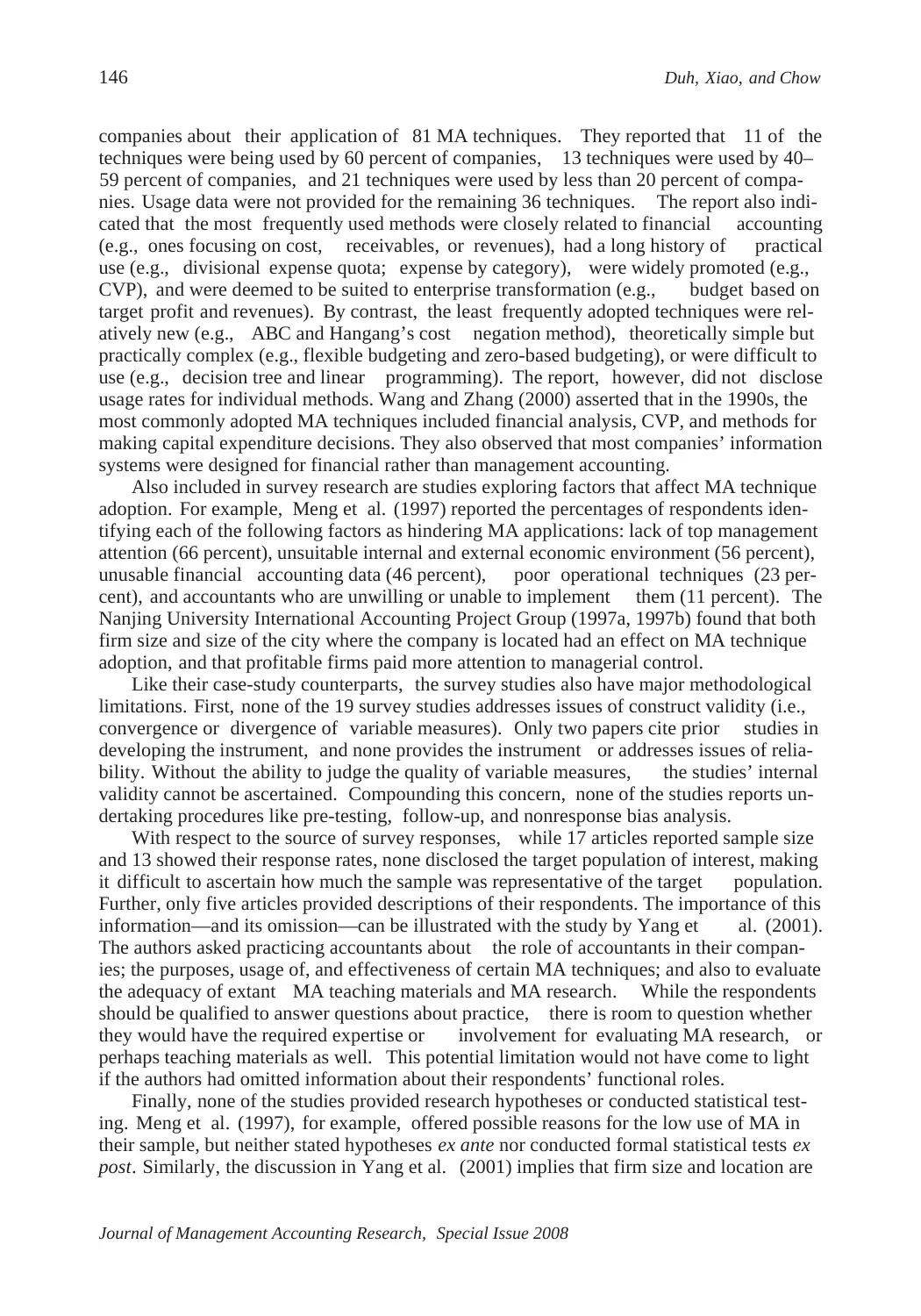
Journal of Management Accounting Research, Special Issue 2008
companies about their application of 81 MA techniques. They reported that 11 of the
techniques were being used by 60 percent of companies, 13 techniques were used by 40–
59 percent of companies, and 21 techniques were used by less than 20 percent of compa-
nies. Usage data were not provided for the remaining 36 techniques. The report also indi-
cated that the most frequently used methods were closely related to financial accounting
(e.g., ones focusing on cost, receivables, or revenues), had a long history of practical
use (e.g., divisional expense quota; expense by category), were widely promoted (e.g.,
CVP), and were deemed to be suited to enterprise transformation (e.g., budget based on
target profit and revenues). By contrast, the least frequently adopted techniques were rel-
atively new (e.g., ABC and Hangang’s cost negation method), theoretically simple but
practically complex (e.g., flexible budgeting and zero-based budgeting), or were difficult to
use (e.g., decision tree and linear programming). The report, however, did not disclose
usage rates for individual methods. Wang and Zhang (2000) asserted that in the 1990s, the
most commonly adopted MA techniques included financial analysis, CVP, and methods for
making capital expenditure decisions. They also observed that most companies’ information
systems were designed for financial rather than management accounting.
Also included in survey research are studies exploring factors that affect MA technique
adoption. For example, Meng et al. (1997) reported the percentages of respondents iden-
tifying each of the following factors as hindering MA applications: lack of top management
attention (66 percent), unsuitable internal and external economic environment (56 percent),
unusable financial accounting data (46 percent), poor operational techniques (23 per-
cent), and accountants who are unwilling or unable to implement them (11 percent). The
Nanjing University International Accounting Project Group (1997a, 1997b) found that both
firm size and size of the city where the company is located had an effect on MA technique
adoption, and that profitable firms paid more attention to managerial control.
Like their case-study counterparts, the survey studies also have major methodological
limitations. First, none of the 19 survey studies addresses issues of construct validity (i.e.,
convergence or divergence of variable measures). Only two papers cite prior studies in
developing the instrument, and none provides the instrument or addresses issues of relia-
bility. Without the ability to judge the quality of variable measures, the studies’ internal
validity cannot be ascertained. Compounding this concern, none of the studies reports un-
dertaking procedures like pre-testing, follow-up, and nonresponse bias analysis.
With respect to the source of survey responses, while 17 articles reported sample size
and 13 showed their response rates, none disclosed the target population of interest, making
it difficult to ascertain how much the sample was representative of the target population.
Further, only five articles provided descriptions of their respondents. The importance of this
information—and its omission—can be illustrated with the study by Yang et al. (2001).
The authors asked practicing accountants about the role of accountants in their compan-
ies; the purposes, usage of, and effectiveness of certain MA techniques; and also to evaluate
the adequacy of extant MA teaching materials and MA research. While the respondents
should be qualified to answer questions about practice, there is room to question whether
they would have the required expertise or involvement for evaluating MA research, or
perhaps teaching materials as well. This potential limitation would not have come to light
if the authors had omitted information about their respondents’ functional roles.
Finally, none of the studies provided research hypotheses or conducted statistical test-
ing. Meng et al. (1997), for example, offered possible reasons for the low use of MA in
their sample, but neither stated hypotheses ex ante nor conducted formal statistical tests ex
post. Similarly, the discussion in Yang et al. (2001) implies that firm size and location are
⊘ This is a preview!⊘
Do you want full access?
Subscribe today to unlock all pages.

Trusted by 1+ million students worldwide
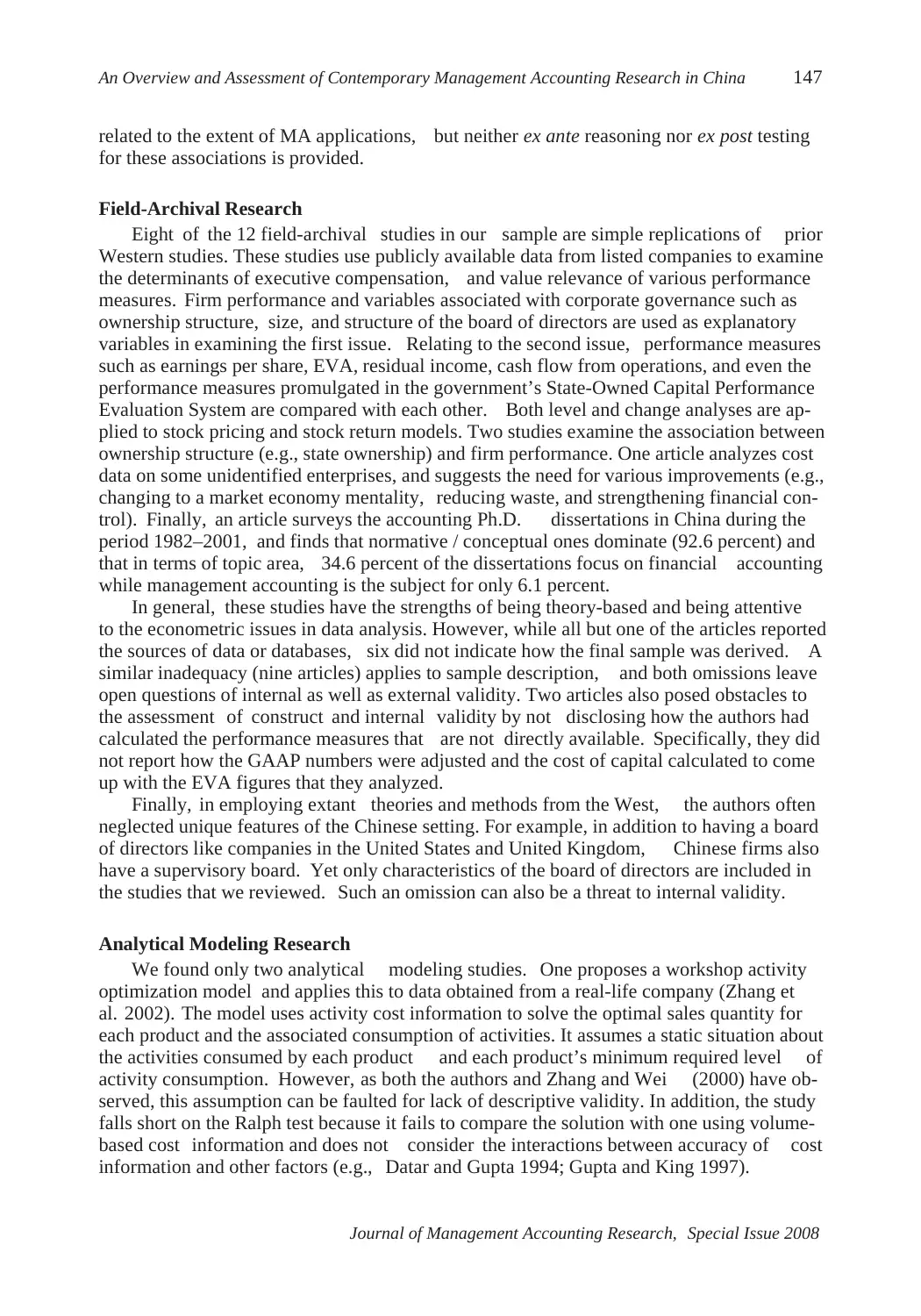
Journal of Management Accounting Research, Special Issue 2008
related to the extent of MA applications, but neither ex ante reasoning nor ex post testing
for these associations is provided.
Field-Archival Research
Eight of the 12 field-archival studies in our sample are simple replications of prior
Western studies. These studies use publicly available data from listed companies to examine
the determinants of executive compensation, and value relevance of various performance
measures. Firm performance and variables associated with corporate governance such as
ownership structure, size, and structure of the board of directors are used as explanatory
variables in examining the first issue. Relating to the second issue, performance measures
such as earnings per share, EVA, residual income, cash flow from operations, and even the
performance measures promulgated in the government’s State-Owned Capital Performance
Evaluation System are compared with each other. Both level and change analyses are ap-
plied to stock pricing and stock return models. Two studies examine the association between
ownership structure (e.g., state ownership) and firm performance. One article analyzes cost
data on some unidentified enterprises, and suggests the need for various improvements (e.g.,
changing to a market economy mentality, reducing waste, and strengthening financial con-
trol). Finally, an article surveys the accounting Ph.D. dissertations in China during the
period 1982–2001, and finds that normative / conceptual ones dominate (92.6 percent) and
that in terms of topic area, 34.6 percent of the dissertations focus on financial accounting
while management accounting is the subject for only 6.1 percent.
In general, these studies have the strengths of being theory-based and being attentive
to the econometric issues in data analysis. However, while all but one of the articles reported
the sources of data or databases, six did not indicate how the final sample was derived. A
similar inadequacy (nine articles) applies to sample description, and both omissions leave
open questions of internal as well as external validity. Two articles also posed obstacles to
the assessment of construct and internal validity by not disclosing how the authors had
calculated the performance measures that are not directly available. Specifically, they did
not report how the GAAP numbers were adjusted and the cost of capital calculated to come
up with the EVA figures that they analyzed.
Finally, in employing extant theories and methods from the West, the authors often
neglected unique features of the Chinese setting. For example, in addition to having a board
of directors like companies in the United States and United Kingdom, Chinese firms also
have a supervisory board. Yet only characteristics of the board of directors are included in
the studies that we reviewed. Such an omission can also be a threat to internal validity.
Analytical Modeling Research
We found only two analytical modeling studies. One proposes a workshop activity
optimization model and applies this to data obtained from a real-life company (Zhang et
al. 2002). The model uses activity cost information to solve the optimal sales quantity for
each product and the associated consumption of activities. It assumes a static situation about
the activities consumed by each product and each product’s minimum required level of
activity consumption. However, as both the authors and Zhang and Wei (2000) have ob-
served, this assumption can be faulted for lack of descriptive validity. In addition, the study
falls short on the Ralph test because it fails to compare the solution with one using volume-
based cost information and does not consider the interactions between accuracy of cost
information and other factors (e.g., Datar and Gupta 1994; Gupta and King 1997).
Paraphrase This Document
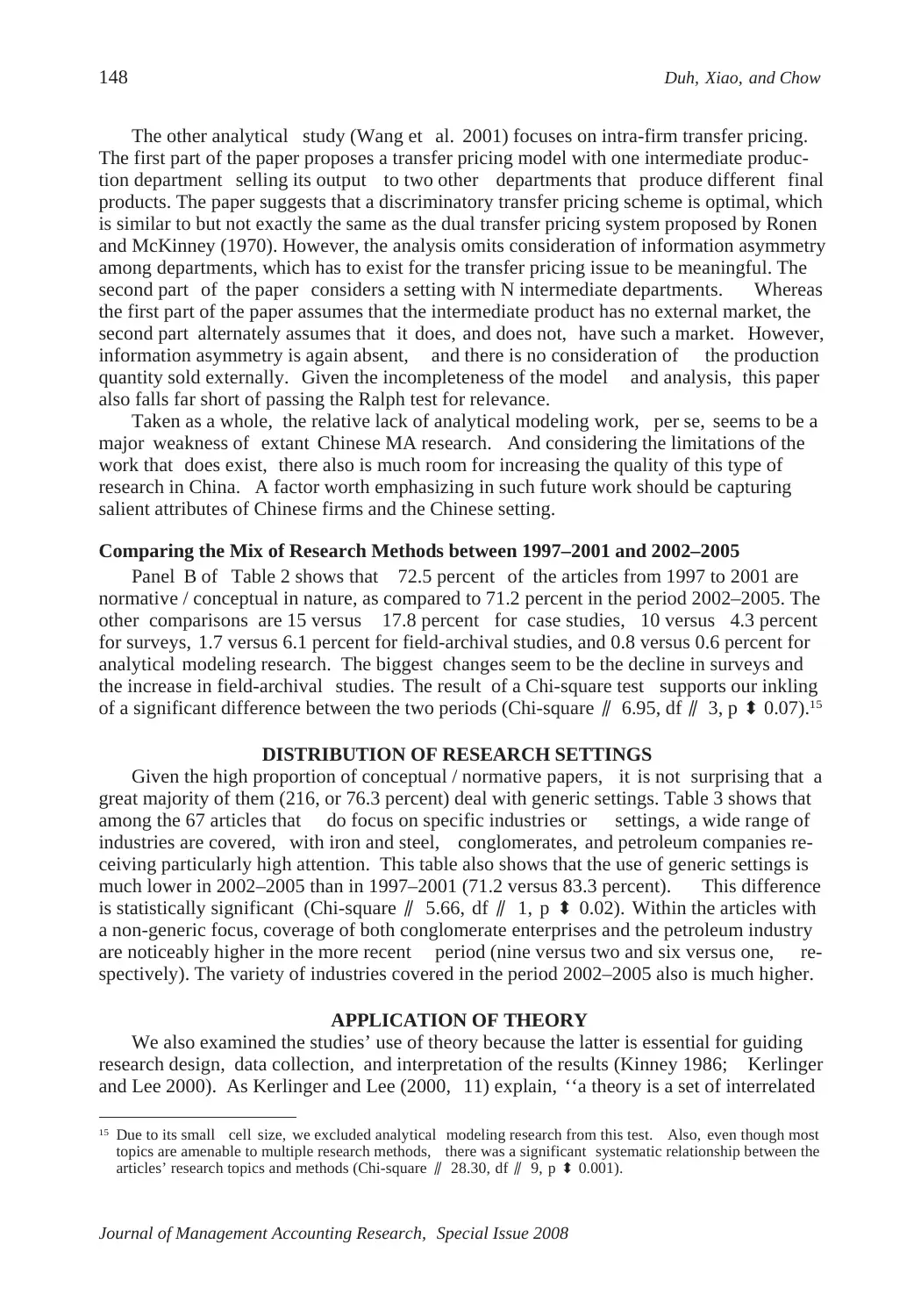
Journal of Management Accounting Research, Special Issue 2008
The other analytical study (Wang et al. 2001) focuses on intra-firm transfer pricing.
The first part of the paper proposes a transfer pricing model with one intermediate produc-
tion department selling its output to two other departments that produce different final
products. The paper suggests that a discriminatory transfer pricing scheme is optimal, which
is similar to but not exactly the same as the dual transfer pricing system proposed by Ronen
and McKinney (1970). However, the analysis omits consideration of information asymmetry
among departments, which has to exist for the transfer pricing issue to be meaningful. The
second part of the paper considers a setting with N intermediate departments. Whereas
the first part of the paper assumes that the intermediate product has no external market, the
second part alternately assumes that it does, and does not, have such a market. However,
information asymmetry is again absent, and there is no consideration of the production
quantity sold externally. Given the incompleteness of the model and analysis, this paper
also falls far short of passing the Ralph test for relevance.
Taken as a whole, the relative lack of analytical modeling work, per se, seems to be a
major weakness of extant Chinese MA research. And considering the limitations of the
work that does exist, there also is much room for increasing the quality of this type of
research in China. A factor worth emphasizing in such future work should be capturing
salient attributes of Chinese firms and the Chinese setting.
Comparing the Mix of Research Methods between 1997–2001 and 2002–2005
Panel B of Table 2 shows that 72.5 percent of the articles from 1997 to 2001 are
normative / conceptual in nature, as compared to 71.2 percent in the period 2002–2005. The
other comparisons are 15 versus 17.8 percent for case studies, 10 versus 4.3 percent
for surveys, 1.7 versus 6.1 percent for field-archival studies, and 0.8 versus 0.6 percent for
analytical modeling research. The biggest changes seem to be the decline in surveys and
the increase in field-archival studies. The result of a Chi-square test supports our inkling
of a significant difference between the two periods (Chi-square ⫽ 6.95, df ⫽ 3, p ⬍ 0.07).15
DISTRIBUTION OF RESEARCH SETTINGS
Given the high proportion of conceptual / normative papers, it is not surprising that a
great majority of them (216, or 76.3 percent) deal with generic settings. Table 3 shows that
among the 67 articles that do focus on specific industries or settings, a wide range of
industries are covered, with iron and steel, conglomerates, and petroleum companies re-
ceiving particularly high attention. This table also shows that the use of generic settings is
much lower in 2002–2005 than in 1997–2001 (71.2 versus 83.3 percent). This difference
is statistically significant (Chi-square ⫽ 5.66, df ⫽ 1, p ⬍ 0.02). Within the articles with
a non-generic focus, coverage of both conglomerate enterprises and the petroleum industry
are noticeably higher in the more recent period (nine versus two and six versus one, re-
spectively). The variety of industries covered in the period 2002–2005 also is much higher.
APPLICATION OF THEORY
We also examined the studies’ use of theory because the latter is essential for guiding
research design, data collection, and interpretation of the results (Kinney 1986; Kerlinger
and Lee 2000). As Kerlinger and Lee (2000, 11) explain, ‘‘a theory is a set of interrelated
15 Due to its small cell size, we excluded analytical modeling research from this test. Also, even though most
topics are amenable to multiple research methods, there was a significant systematic relationship between the
articles’ research topics and methods (Chi-square ⫽ 28.30, df ⫽ 9, p ⬍ 0.001).
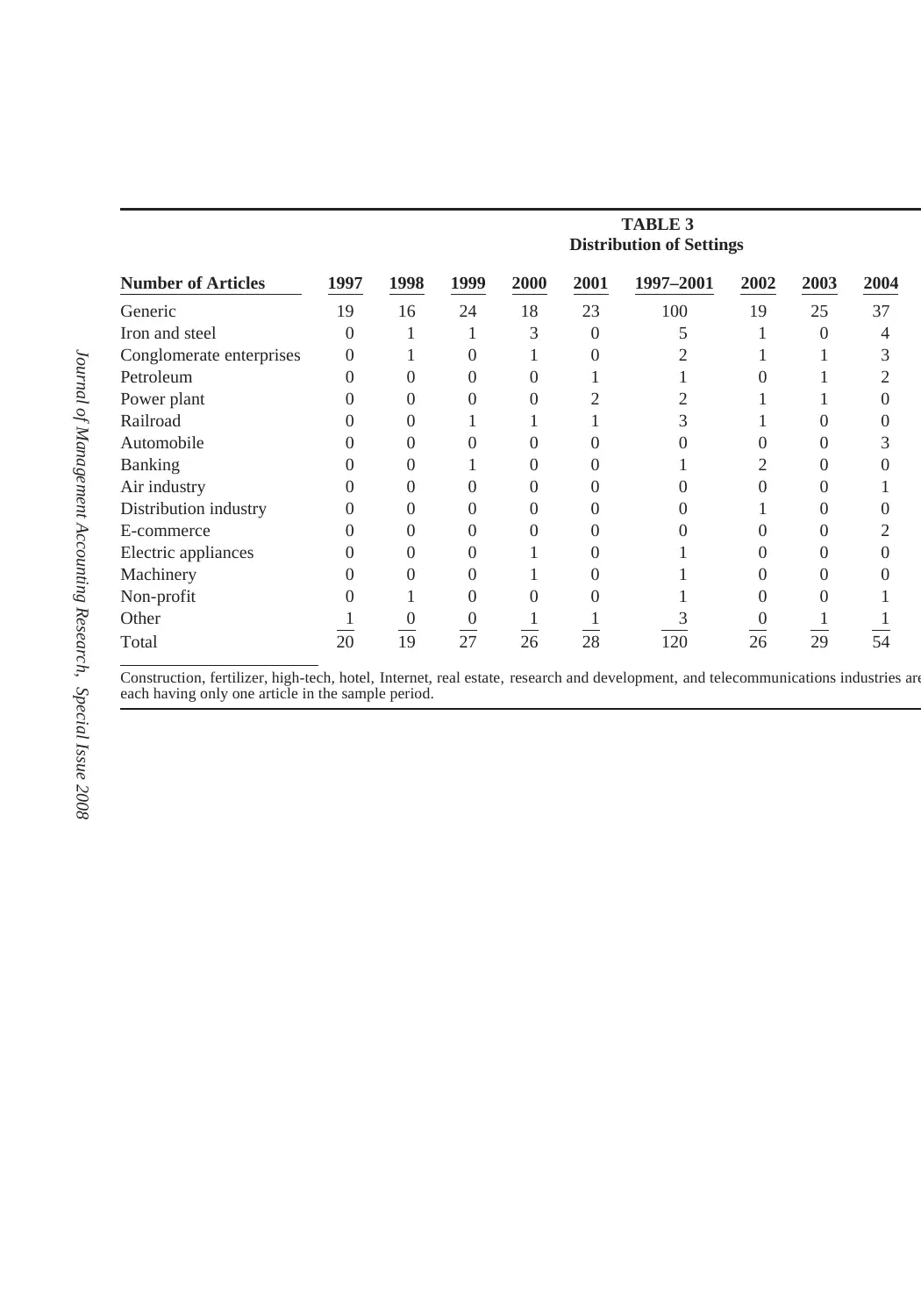
TABLE 3
Distribution of Settings
Number of Articles 1997 1998 1999 2000 2001 1997–2001 2002 2003 2004
Generic 19 16 24 18 23 100 19 25 37
Iron and steel 0 1 1 3 0 5 1 0 4
Conglomerate enterprises 0 1 0 1 0 2 1 1 3
Petroleum 0 0 0 0 1 1 0 1 2
Power plant 0 0 0 0 2 2 1 1 0
Railroad 0 0 1 1 1 3 1 0 0
Automobile 0 0 0 0 0 0 0 0 3
Banking 0 0 1 0 0 1 2 0 0
Air industry 0 0 0 0 0 0 0 0 1
Distribution industry 0 0 0 0 0 0 1 0 0
E-commerce 0 0 0 0 0 0 0 0 2
Electric appliances 0 0 0 1 0 1 0 0 0
Machinery 0 0 0 1 0 1 0 0 0
Non-profit 0 1 0 0 0 1 0 0 1
Other 1 0 0 1 1 3 0 1 1
Total 20 19 27 26 28 120 26 29 54
Construction, fertilizer, high-tech, hotel, Internet, real estate, research and development, and telecommunications industries are
each having only one article in the sample period.
⊘ This is a preview!⊘
Do you want full access?
Subscribe today to unlock all pages.

Trusted by 1+ million students worldwide
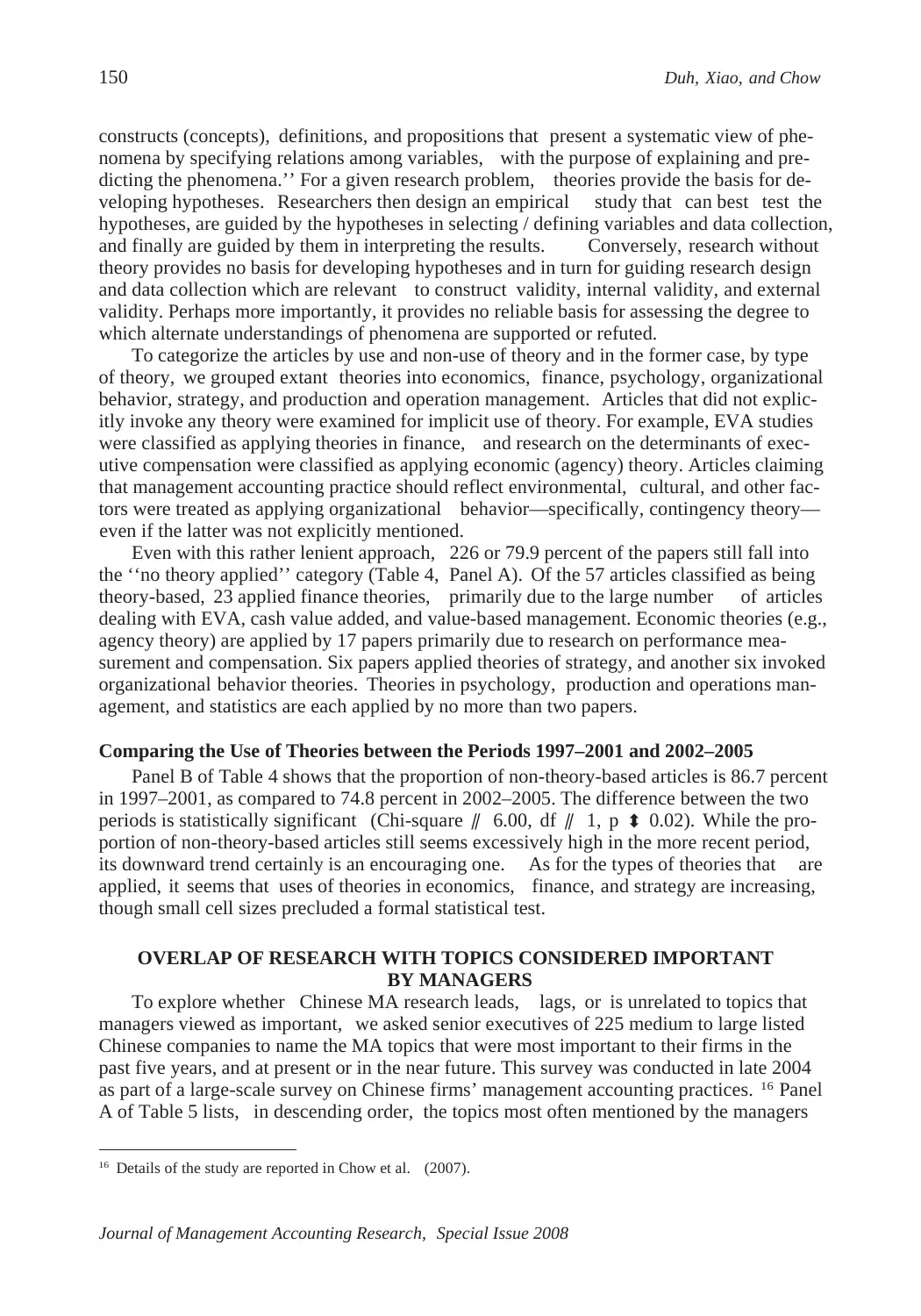
Journal of Management Accounting Research, Special Issue 2008
constructs (concepts), definitions, and propositions that present a systematic view of phe-
nomena by specifying relations among variables, with the purpose of explaining and pre-
dicting the phenomena.’’ For a given research problem, theories provide the basis for de-
veloping hypotheses. Researchers then design an empirical study that can best test the
hypotheses, are guided by the hypotheses in selecting / defining variables and data collection,
and finally are guided by them in interpreting the results. Conversely, research without
theory provides no basis for developing hypotheses and in turn for guiding research design
and data collection which are relevant to construct validity, internal validity, and external
validity. Perhaps more importantly, it provides no reliable basis for assessing the degree to
which alternate understandings of phenomena are supported or refuted.
To categorize the articles by use and non-use of theory and in the former case, by type
of theory, we grouped extant theories into economics, finance, psychology, organizational
behavior, strategy, and production and operation management. Articles that did not explic-
itly invoke any theory were examined for implicit use of theory. For example, EVA studies
were classified as applying theories in finance, and research on the determinants of exec-
utive compensation were classified as applying economic (agency) theory. Articles claiming
that management accounting practice should reflect environmental, cultural, and other fac-
tors were treated as applying organizational behavior—specifically, contingency theory—
even if the latter was not explicitly mentioned.
Even with this rather lenient approach, 226 or 79.9 percent of the papers still fall into
the ‘‘no theory applied’’ category (Table 4, Panel A). Of the 57 articles classified as being
theory-based, 23 applied finance theories, primarily due to the large number of articles
dealing with EVA, cash value added, and value-based management. Economic theories (e.g.,
agency theory) are applied by 17 papers primarily due to research on performance mea-
surement and compensation. Six papers applied theories of strategy, and another six invoked
organizational behavior theories. Theories in psychology, production and operations man-
agement, and statistics are each applied by no more than two papers.
Comparing the Use of Theories between the Periods 1997–2001 and 2002–2005
Panel B of Table 4 shows that the proportion of non-theory-based articles is 86.7 percent
in 1997–2001, as compared to 74.8 percent in 2002–2005. The difference between the two
periods is statistically significant (Chi-square ⫽ 6.00, df ⫽ 1, p ⬍ 0.02). While the pro-
portion of non-theory-based articles still seems excessively high in the more recent period,
its downward trend certainly is an encouraging one. As for the types of theories that are
applied, it seems that uses of theories in economics, finance, and strategy are increasing,
though small cell sizes precluded a formal statistical test.
OVERLAP OF RESEARCH WITH TOPICS CONSIDERED IMPORTANT
BY MANAGERS
To explore whether Chinese MA research leads, lags, or is unrelated to topics that
managers viewed as important, we asked senior executives of 225 medium to large listed
Chinese companies to name the MA topics that were most important to their firms in the
past five years, and at present or in the near future. This survey was conducted in late 2004
as part of a large-scale survey on Chinese firms’ management accounting practices. 16 Panel
A of Table 5 lists, in descending order, the topics most often mentioned by the managers
16 Details of the study are reported in Chow et al. (2007).
Paraphrase This Document
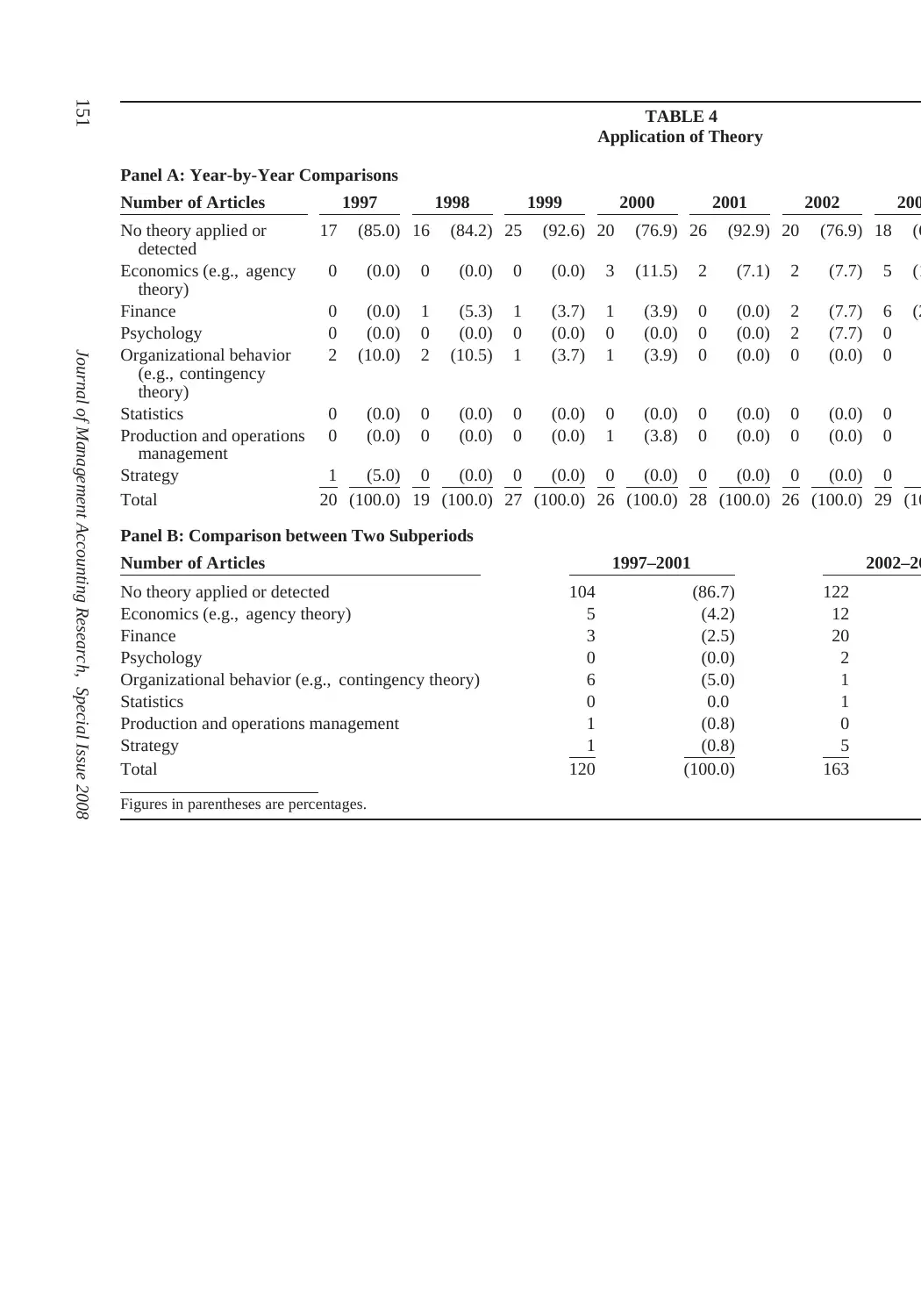
TABLE 4
Application of Theory
Panel A: Year-by-Year Comparisons
Number of Articles 1997 1998 1999 2000 2001 2002 200
No theory applied or
detected
17 (85.0) 16 (84.2) 25 (92.6) 20 (76.9) 26 (92.9) 20 (76.9) 18 (6
Economics (e.g., agency
theory)
0 (0.0) 0 (0.0) 0 (0.0) 3 (11.5) 2 (7.1) 2 (7.7) 5 (1
Finance 0 (0.0) 1 (5.3) 1 (3.7) 1 (3.9) 0 (0.0) 2 (7.7) 6 (2
Psychology 0 (0.0) 0 (0.0) 0 (0.0) 0 (0.0) 0 (0.0) 2 (7.7) 0
Organizational behavior
(e.g., contingency
theory)
2 (10.0) 2 (10.5) 1 (3.7) 1 (3.9) 0 (0.0) 0 (0.0) 0
Statistics 0 (0.0) 0 (0.0) 0 (0.0) 0 (0.0) 0 (0.0) 0 (0.0) 0
Production and operations
management
0 (0.0) 0 (0.0) 0 (0.0) 1 (3.8) 0 (0.0) 0 (0.0) 0
Strategy 1 (5.0) 0 (0.0) 0 (0.0) 0 (0.0) 0 (0.0) 0 (0.0) 0
Total 20 (100.0) 19 (100.0) 27 (100.0) 26 (100.0) 28 (100.0) 26 (100.0) 29 (10
Panel B: Comparison between Two Subperiods
Number of Articles 1997–2001 2002–20
No theory applied or detected 104 (86.7) 122
Economics (e.g., agency theory) 5 (4.2) 12
Finance 3 (2.5) 20
Psychology 0 (0.0) 2
Organizational behavior (e.g., contingency theory) 6 (5.0) 1
Statistics 0 0.0 1
Production and operations management 1 (0.8) 0
Strategy 1 (0.8) 5
Total 120 (100.0) 163
Figures in parentheses are percentages.
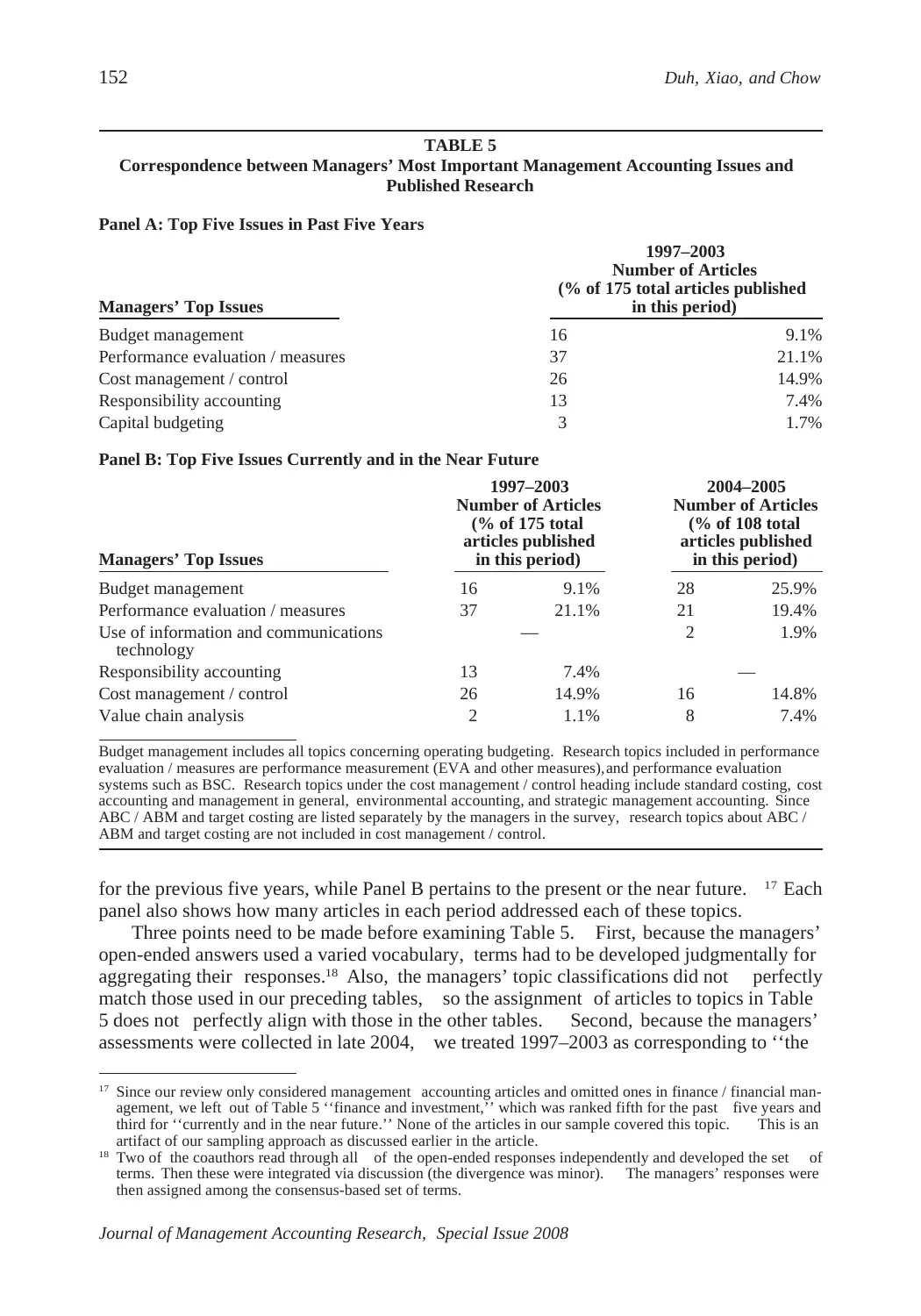
Journal of Management Accounting Research, Special Issue 2008
TABLE 5
Correspondence between Managers’ Most Important Management Accounting Issues and
Published Research
Panel A: Top Five Issues in Past Five Years
Managers’ Top Issues
1997–2003
Number of Articles
(% of 175 total articles published
in this period)
Budget management 16 9.1%
Performance evaluation / measures 37 21.1%
Cost management / control 26 14.9%
Responsibility accounting 13 7.4%
Capital budgeting 3 1.7%
Panel B: Top Five Issues Currently and in the Near Future
Managers’ Top Issues
1997–2003
Number of Articles
(% of 175 total
articles published
in this period)
2004–2005
Number of Articles
(% of 108 total
articles published
in this period)
Budget management 16 9.1% 28 25.9%
Performance evaluation / measures 37 21.1% 21 19.4%
Use of information and communications
technology
— 2 1.9%
Responsibility accounting 13 7.4% —
Cost management / control 26 14.9% 16 14.8%
Value chain analysis 2 1.1% 8 7.4%
Budget management includes all topics concerning operating budgeting. Research topics included in performance
evaluation / measures are performance measurement (EVA and other measures),and performance evaluation
systems such as BSC. Research topics under the cost management / control heading include standard costing, cost
accounting and management in general, environmental accounting, and strategic management accounting. Since
ABC / ABM and target costing are listed separately by the managers in the survey, research topics about ABC /
ABM and target costing are not included in cost management / control.
for the previous five years, while Panel B pertains to the present or the near future. 17 Each
panel also shows how many articles in each period addressed each of these topics.
Three points need to be made before examining Table 5. First, because the managers’
open-ended answers used a varied vocabulary, terms had to be developed judgmentally for
aggregating their responses.18 Also, the managers’ topic classifications did not perfectly
match those used in our preceding tables, so the assignment of articles to topics in Table
5 does not perfectly align with those in the other tables. Second, because the managers’
assessments were collected in late 2004, we treated 1997–2003 as corresponding to ‘‘the
17 Since our review only considered management accounting articles and omitted ones in finance / financial man-
agement, we left out of Table 5 ‘‘finance and investment,’’ which was ranked fifth for the past five years and
third for ‘‘currently and in the near future.’’ None of the articles in our sample covered this topic. This is an
artifact of our sampling approach as discussed earlier in the article.
18 Two of the coauthors read through all of the open-ended responses independently and developed the set of
terms. Then these were integrated via discussion (the divergence was minor). The managers’ responses were
then assigned among the consensus-based set of terms.
⊘ This is a preview!⊘
Do you want full access?
Subscribe today to unlock all pages.

Trusted by 1+ million students worldwide
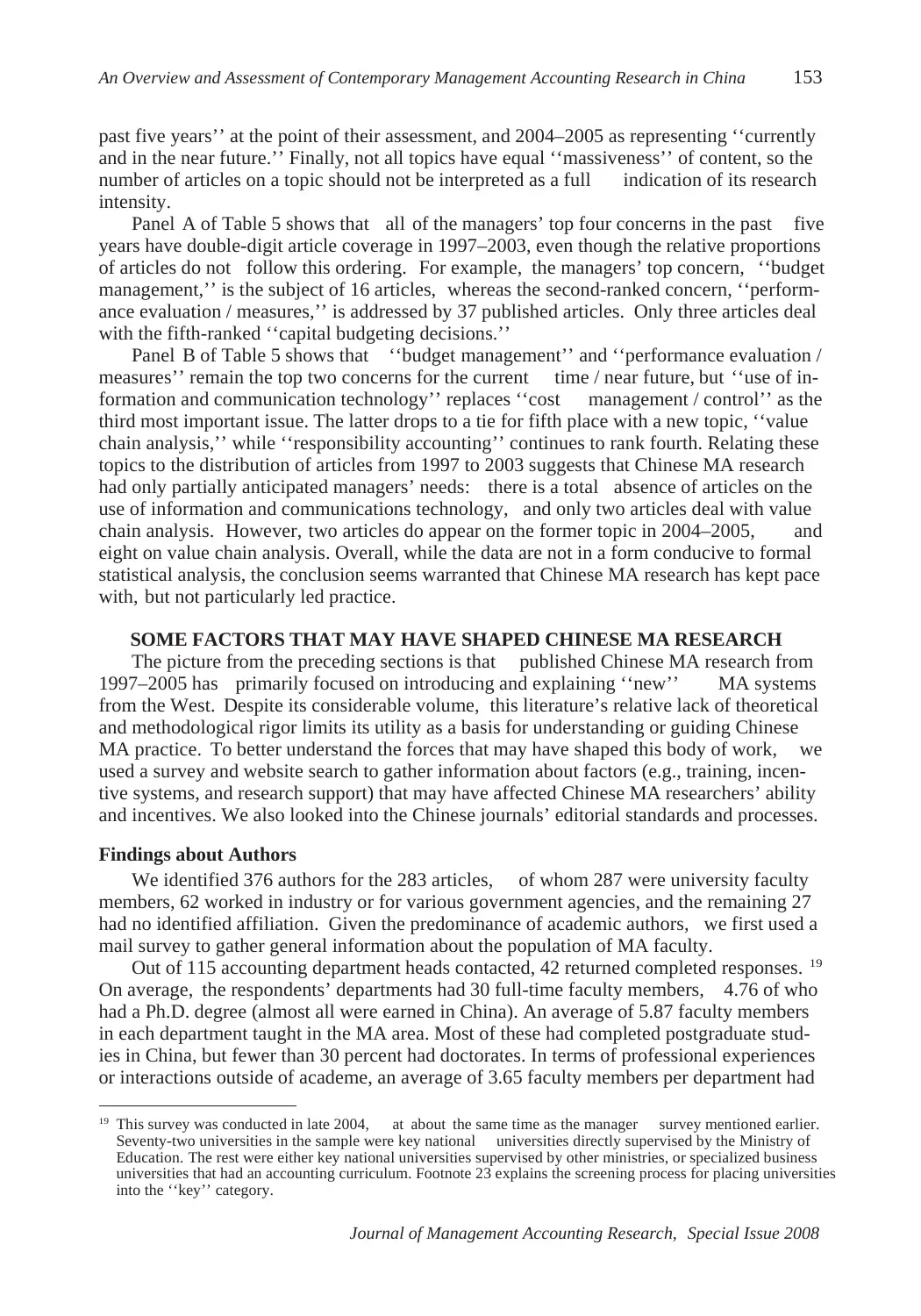
Journal of Management Accounting Research, Special Issue 2008
past five years’’ at the point of their assessment, and 2004–2005 as representing ‘‘currently
and in the near future.’’ Finally, not all topics have equal ‘‘massiveness’’ of content, so the
number of articles on a topic should not be interpreted as a full indication of its research
intensity.
Panel A of Table 5 shows that all of the managers’ top four concerns in the past five
years have double-digit article coverage in 1997–2003, even though the relative proportions
of articles do not follow this ordering. For example, the managers’ top concern, ‘‘budget
management,’’ is the subject of 16 articles, whereas the second-ranked concern, ‘‘perform-
ance evaluation / measures,’’ is addressed by 37 published articles. Only three articles deal
with the fifth-ranked ‘‘capital budgeting decisions.’’
Panel B of Table 5 shows that ‘‘budget management’’ and ‘‘performance evaluation /
measures’’ remain the top two concerns for the current time / near future, but ‘‘use of in-
formation and communication technology’’ replaces ‘‘cost management / control’’ as the
third most important issue. The latter drops to a tie for fifth place with a new topic, ‘‘value
chain analysis,’’ while ‘‘responsibility accounting’’ continues to rank fourth. Relating these
topics to the distribution of articles from 1997 to 2003 suggests that Chinese MA research
had only partially anticipated managers’ needs: there is a total absence of articles on the
use of information and communications technology, and only two articles deal with value
chain analysis. However, two articles do appear on the former topic in 2004–2005, and
eight on value chain analysis. Overall, while the data are not in a form conducive to formal
statistical analysis, the conclusion seems warranted that Chinese MA research has kept pace
with, but not particularly led practice.
SOME FACTORS THAT MAY HAVE SHAPED CHINESE MA RESEARCH
The picture from the preceding sections is that published Chinese MA research from
1997–2005 has primarily focused on introducing and explaining ‘‘new’’ MA systems
from the West. Despite its considerable volume, this literature’s relative lack of theoretical
and methodological rigor limits its utility as a basis for understanding or guiding Chinese
MA practice. To better understand the forces that may have shaped this body of work, we
used a survey and website search to gather information about factors (e.g., training, incen-
tive systems, and research support) that may have affected Chinese MA researchers’ ability
and incentives. We also looked into the Chinese journals’ editorial standards and processes.
Findings about Authors
We identified 376 authors for the 283 articles, of whom 287 were university faculty
members, 62 worked in industry or for various government agencies, and the remaining 27
had no identified affiliation. Given the predominance of academic authors, we first used a
mail survey to gather general information about the population of MA faculty.
Out of 115 accounting department heads contacted, 42 returned completed responses. 19
On average, the respondents’ departments had 30 full-time faculty members, 4.76 of who
had a Ph.D. degree (almost all were earned in China). An average of 5.87 faculty members
in each department taught in the MA area. Most of these had completed postgraduate stud-
ies in China, but fewer than 30 percent had doctorates. In terms of professional experiences
or interactions outside of academe, an average of 3.65 faculty members per department had
19 This survey was conducted in late 2004, at about the same time as the manager survey mentioned earlier.
Seventy-two universities in the sample were key national universities directly supervised by the Ministry of
Education. The rest were either key national universities supervised by other ministries, or specialized business
universities that had an accounting curriculum. Footnote 23 explains the screening process for placing universities
into the ‘‘key’’ category.
Paraphrase This Document
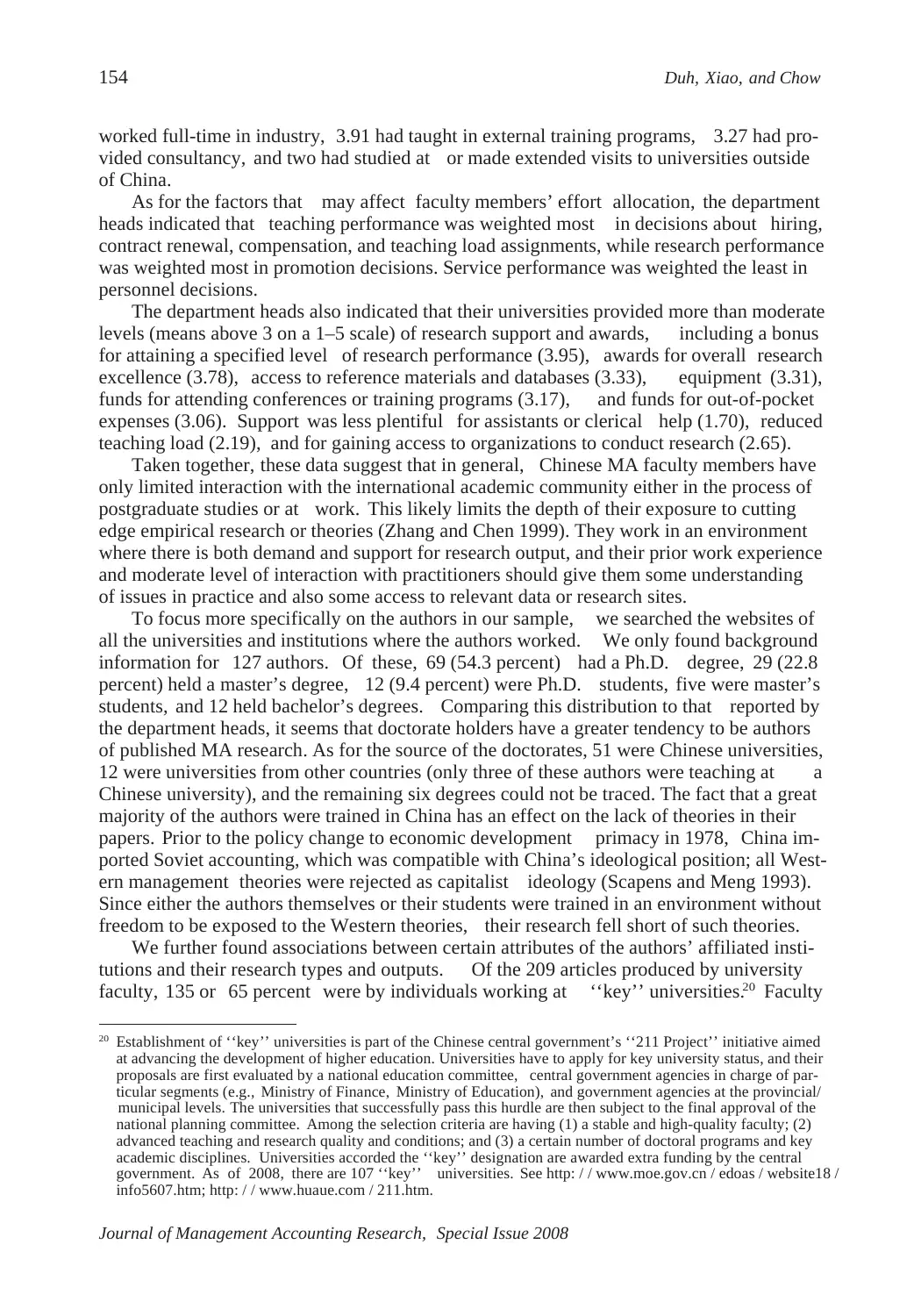
Journal of Management Accounting Research, Special Issue 2008
worked full-time in industry, 3.91 had taught in external training programs, 3.27 had pro-
vided consultancy, and two had studied at or made extended visits to universities outside
of China.
As for the factors that may affect faculty members’ effort allocation, the department
heads indicated that teaching performance was weighted most in decisions about hiring,
contract renewal, compensation, and teaching load assignments, while research performance
was weighted most in promotion decisions. Service performance was weighted the least in
personnel decisions.
The department heads also indicated that their universities provided more than moderate
levels (means above 3 on a 1–5 scale) of research support and awards, including a bonus
for attaining a specified level of research performance (3.95), awards for overall research
excellence (3.78), access to reference materials and databases (3.33), equipment (3.31),
funds for attending conferences or training programs (3.17), and funds for out-of-pocket
expenses (3.06). Support was less plentiful for assistants or clerical help (1.70), reduced
teaching load (2.19), and for gaining access to organizations to conduct research (2.65).
Taken together, these data suggest that in general, Chinese MA faculty members have
only limited interaction with the international academic community either in the process of
postgraduate studies or at work. This likely limits the depth of their exposure to cutting
edge empirical research or theories (Zhang and Chen 1999). They work in an environment
where there is both demand and support for research output, and their prior work experience
and moderate level of interaction with practitioners should give them some understanding
of issues in practice and also some access to relevant data or research sites.
To focus more specifically on the authors in our sample, we searched the websites of
all the universities and institutions where the authors worked. We only found background
information for 127 authors. Of these, 69 (54.3 percent) had a Ph.D. degree, 29 (22.8
percent) held a master’s degree, 12 (9.4 percent) were Ph.D. students, five were master’s
students, and 12 held bachelor’s degrees. Comparing this distribution to that reported by
the department heads, it seems that doctorate holders have a greater tendency to be authors
of published MA research. As for the source of the doctorates, 51 were Chinese universities,
12 were universities from other countries (only three of these authors were teaching at a
Chinese university), and the remaining six degrees could not be traced. The fact that a great
majority of the authors were trained in China has an effect on the lack of theories in their
papers. Prior to the policy change to economic development primacy in 1978, China im-
ported Soviet accounting, which was compatible with China’s ideological position; all West-
ern management theories were rejected as capitalist ideology (Scapens and Meng 1993).
Since either the authors themselves or their students were trained in an environment without
freedom to be exposed to the Western theories, their research fell short of such theories.
We further found associations between certain attributes of the authors’ affiliated insti-
tutions and their research types and outputs. Of the 209 articles produced by university
faculty, 135 or 65 percent were by individuals working at ‘‘key’’ universities.20 Faculty
20 Establishment of ‘‘key’’ universities is part of the Chinese central government’s ‘‘211 Project’’ initiative aimed
at advancing the development of higher education. Universities have to apply for key university status, and their
proposals are first evaluated by a national education committee, central government agencies in charge of par-
ticular segments (e.g., Ministry of Finance, Ministry of Education), and government agencies at the provincial/
municipal levels. The universities that successfully pass this hurdle are then subject to the final approval of the
national planning committee. Among the selection criteria are having (1) a stable and high-quality faculty; (2)
advanced teaching and research quality and conditions; and (3) a certain number of doctoral programs and key
academic disciplines. Universities accorded the ‘‘key’’ designation are awarded extra funding by the central
government. As of 2008, there are 107 ‘‘key’’ universities. See http: / / www.moe.gov.cn / edoas / website18 /
info5607.htm; http: / / www.huaue.com / 211.htm.
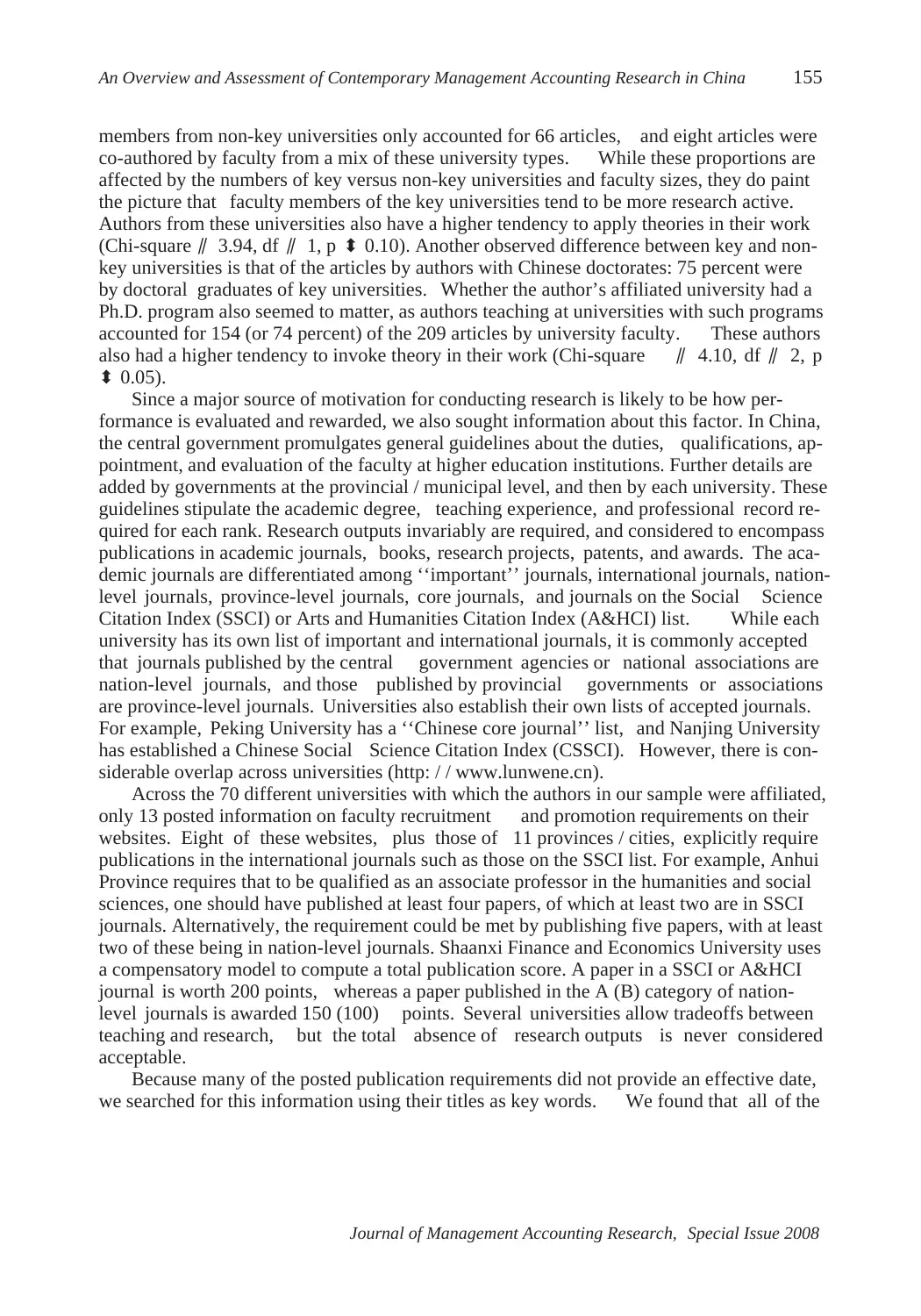
Journal of Management Accounting Research, Special Issue 2008
members from non-key universities only accounted for 66 articles, and eight articles were
co-authored by faculty from a mix of these university types. While these proportions are
affected by the numbers of key versus non-key universities and faculty sizes, they do paint
the picture that faculty members of the key universities tend to be more research active.
Authors from these universities also have a higher tendency to apply theories in their work
(Chi-square ⫽ 3.94, df ⫽ 1, p ⬍ 0.10). Another observed difference between key and non-
key universities is that of the articles by authors with Chinese doctorates: 75 percent were
by doctoral graduates of key universities. Whether the author’s affiliated university had a
Ph.D. program also seemed to matter, as authors teaching at universities with such programs
accounted for 154 (or 74 percent) of the 209 articles by university faculty. These authors
also had a higher tendency to invoke theory in their work (Chi-square ⫽ 4.10, df ⫽ 2, p
⬍ 0.05).
Since a major source of motivation for conducting research is likely to be how per-
formance is evaluated and rewarded, we also sought information about this factor. In China,
the central government promulgates general guidelines about the duties, qualifications, ap-
pointment, and evaluation of the faculty at higher education institutions. Further details are
added by governments at the provincial / municipal level, and then by each university. These
guidelines stipulate the academic degree, teaching experience, and professional record re-
quired for each rank. Research outputs invariably are required, and considered to encompass
publications in academic journals, books, research projects, patents, and awards. The aca-
demic journals are differentiated among ‘‘important’’ journals, international journals, nation-
level journals, province-level journals, core journals, and journals on the Social Science
Citation Index (SSCI) or Arts and Humanities Citation Index (A&HCI) list. While each
university has its own list of important and international journals, it is commonly accepted
that journals published by the central government agencies or national associations are
nation-level journals, and those published by provincial governments or associations
are province-level journals. Universities also establish their own lists of accepted journals.
For example, Peking University has a ‘‘Chinese core journal’’ list, and Nanjing University
has established a Chinese Social Science Citation Index (CSSCI). However, there is con-
siderable overlap across universities (http: / / www.lunwene.cn).
Across the 70 different universities with which the authors in our sample were affiliated,
only 13 posted information on faculty recruitment and promotion requirements on their
websites. Eight of these websites, plus those of 11 provinces / cities, explicitly require
publications in the international journals such as those on the SSCI list. For example, Anhui
Province requires that to be qualified as an associate professor in the humanities and social
sciences, one should have published at least four papers, of which at least two are in SSCI
journals. Alternatively, the requirement could be met by publishing five papers, with at least
two of these being in nation-level journals. Shaanxi Finance and Economics University uses
a compensatory model to compute a total publication score. A paper in a SSCI or A&HCI
journal is worth 200 points, whereas a paper published in the A (B) category of nation-
level journals is awarded 150 (100) points. Several universities allow tradeoffs between
teaching and research, but the total absence of research outputs is never considered
acceptable.
Because many of the posted publication requirements did not provide an effective date,
we searched for this information using their titles as key words. We found that all of the
⊘ This is a preview!⊘
Do you want full access?
Subscribe today to unlock all pages.

Trusted by 1+ million students worldwide
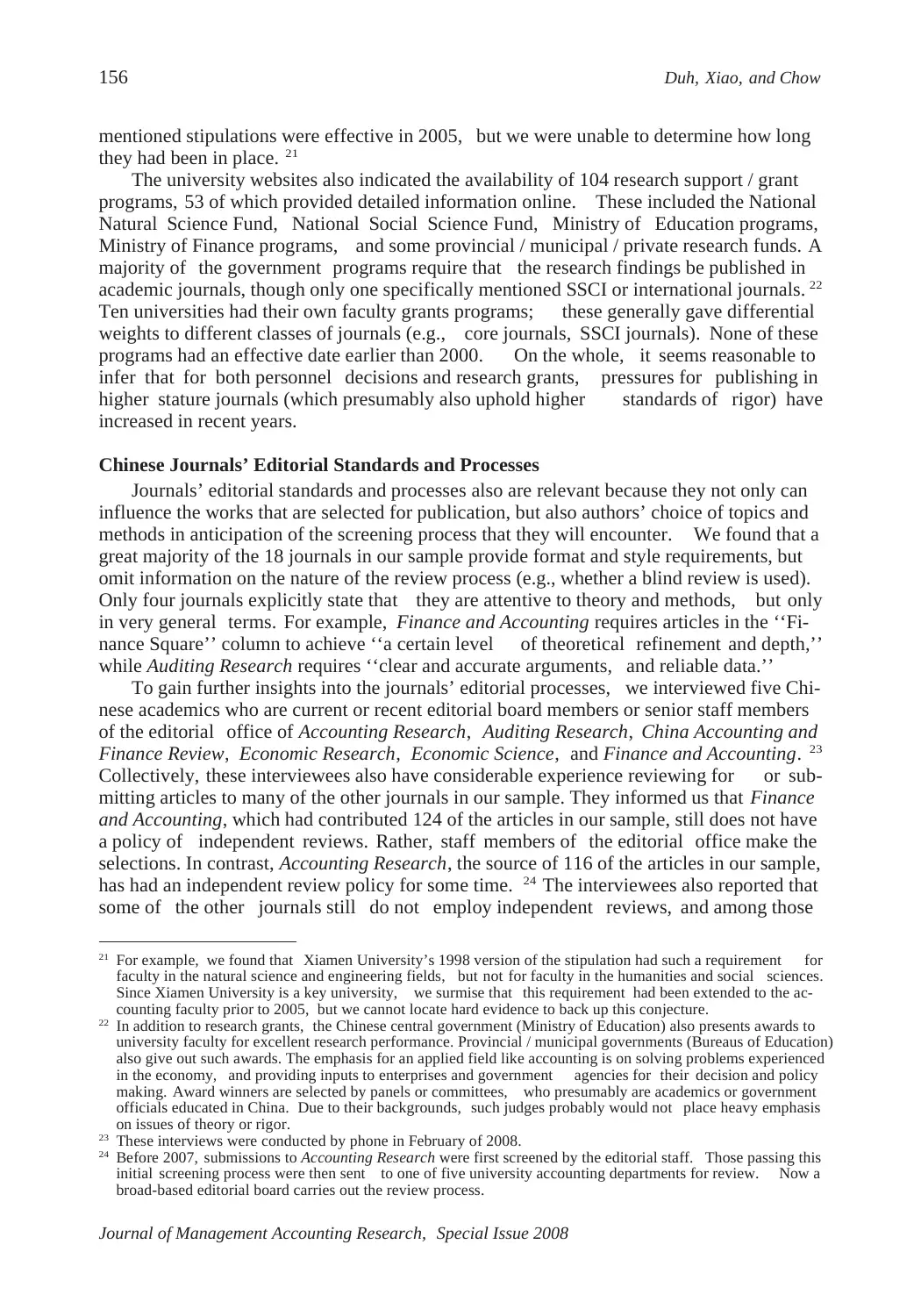
Journal of Management Accounting Research, Special Issue 2008
mentioned stipulations were effective in 2005, but we were unable to determine how long
they had been in place. 21
The university websites also indicated the availability of 104 research support / grant
programs, 53 of which provided detailed information online. These included the National
Natural Science Fund, National Social Science Fund, Ministry of Education programs,
Ministry of Finance programs, and some provincial / municipal / private research funds. A
majority of the government programs require that the research findings be published in
academic journals, though only one specifically mentioned SSCI or international journals. 22
Ten universities had their own faculty grants programs; these generally gave differential
weights to different classes of journals (e.g., core journals, SSCI journals). None of these
programs had an effective date earlier than 2000. On the whole, it seems reasonable to
infer that for both personnel decisions and research grants, pressures for publishing in
higher stature journals (which presumably also uphold higher standards of rigor) have
increased in recent years.
Chinese Journals’ Editorial Standards and Processes
Journals’ editorial standards and processes also are relevant because they not only can
influence the works that are selected for publication, but also authors’ choice of topics and
methods in anticipation of the screening process that they will encounter. We found that a
great majority of the 18 journals in our sample provide format and style requirements, but
omit information on the nature of the review process (e.g., whether a blind review is used).
Only four journals explicitly state that they are attentive to theory and methods, but only
in very general terms. For example, Finance and Accounting requires articles in the ‘‘Fi-
nance Square’’ column to achieve ‘‘a certain level of theoretical refinement and depth,’’
while Auditing Research requires ‘‘clear and accurate arguments, and reliable data.’’
To gain further insights into the journals’ editorial processes, we interviewed five Chi-
nese academics who are current or recent editorial board members or senior staff members
of the editorial office of Accounting Research, Auditing Research, China Accounting and
Finance Review, Economic Research, Economic Science, and Finance and Accounting. 23
Collectively, these interviewees also have considerable experience reviewing for or sub-
mitting articles to many of the other journals in our sample. They informed us that Finance
and Accounting, which had contributed 124 of the articles in our sample, still does not have
a policy of independent reviews. Rather, staff members of the editorial office make the
selections. In contrast, Accounting Research, the source of 116 of the articles in our sample,
has had an independent review policy for some time. 24 The interviewees also reported that
some of the other journals still do not employ independent reviews, and among those
21 For example, we found that Xiamen University’s 1998 version of the stipulation had such a requirement for
faculty in the natural science and engineering fields, but not for faculty in the humanities and social sciences.
Since Xiamen University is a key university, we surmise that this requirement had been extended to the ac-
counting faculty prior to 2005, but we cannot locate hard evidence to back up this conjecture.
22 In addition to research grants, the Chinese central government (Ministry of Education) also presents awards to
university faculty for excellent research performance. Provincial / municipal governments (Bureaus of Education)
also give out such awards. The emphasis for an applied field like accounting is on solving problems experienced
in the economy, and providing inputs to enterprises and government agencies for their decision and policy
making. Award winners are selected by panels or committees, who presumably are academics or government
officials educated in China. Due to their backgrounds, such judges probably would not place heavy emphasis
on issues of theory or rigor.
23 These interviews were conducted by phone in February of 2008.
24 Before 2007, submissions to Accounting Research were first screened by the editorial staff. Those passing this
initial screening process were then sent to one of five university accounting departments for review. Now a
broad-based editorial board carries out the review process.
Paraphrase This Document
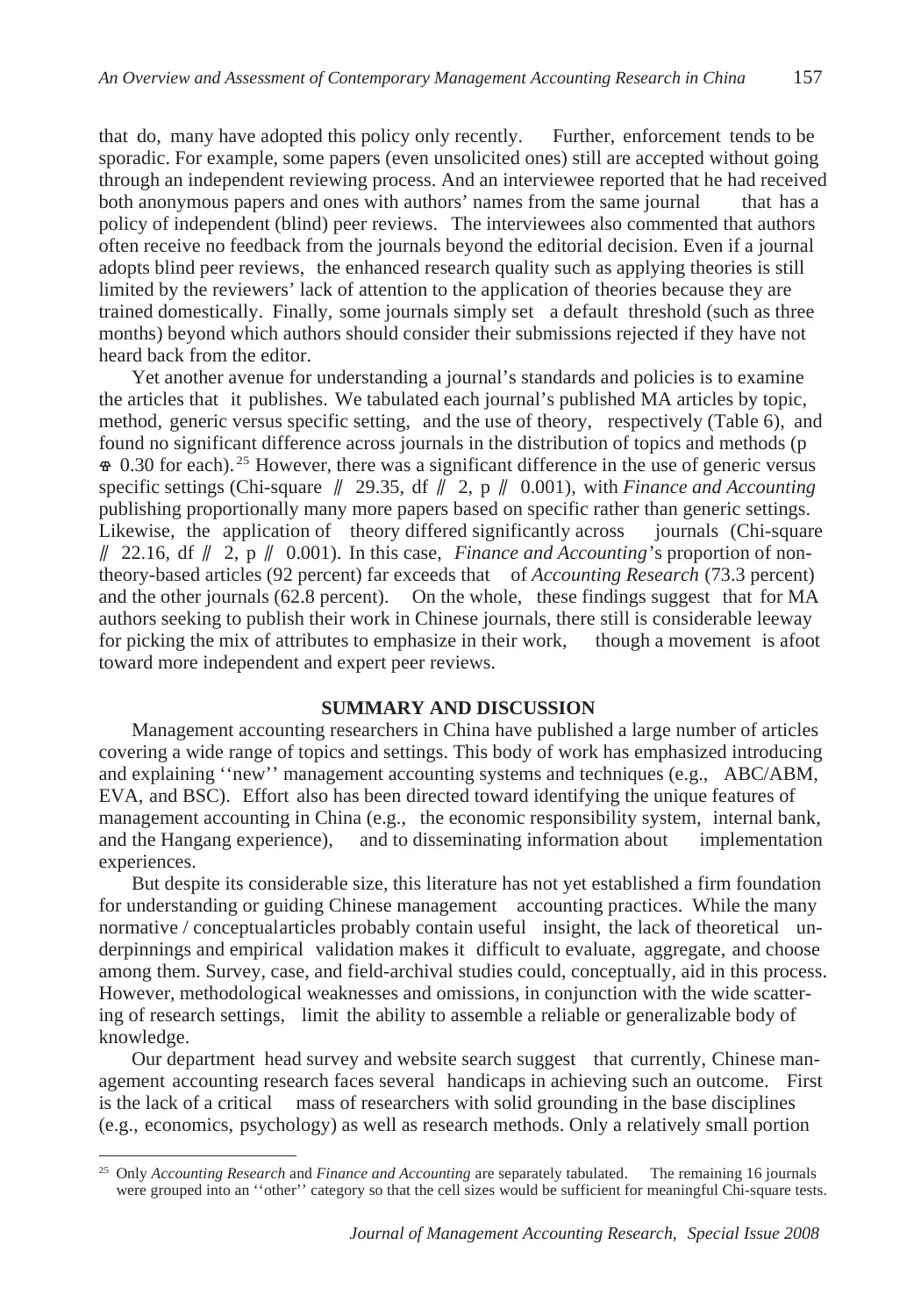
Journal of Management Accounting Research, Special Issue 2008
that do, many have adopted this policy only recently. Further, enforcement tends to be
sporadic. For example, some papers (even unsolicited ones) still are accepted without going
through an independent reviewing process. And an interviewee reported that he had received
both anonymous papers and ones with authors’ names from the same journal that has a
policy of independent (blind) peer reviews. The interviewees also commented that authors
often receive no feedback from the journals beyond the editorial decision. Even if a journal
adopts blind peer reviews, the enhanced research quality such as applying theories is still
limited by the reviewers’ lack of attention to the application of theories because they are
trained domestically. Finally, some journals simply set a default threshold (such as three
months) beyond which authors should consider their submissions rejected if they have not
heard back from the editor.
Yet another avenue for understanding a journal’s standards and policies is to examine
the articles that it publishes. We tabulated each journal’s published MA articles by topic,
method, generic versus specific setting, and the use of theory, respectively (Table 6), and
found no significant difference across journals in the distribution of topics and methods (p
ⱖ 0.30 for each). 25 However, there was a significant difference in the use of generic versus
specific settings (Chi-square ⫽ 29.35, df ⫽ 2, p ⫽ 0.001), with Finance and Accounting
publishing proportionally many more papers based on specific rather than generic settings.
Likewise, the application of theory differed significantly across journals (Chi-square
⫽ 22.16, df ⫽ 2, p ⫽ 0.001). In this case, Finance and Accounting’s proportion of non-
theory-based articles (92 percent) far exceeds that of Accounting Research (73.3 percent)
and the other journals (62.8 percent). On the whole, these findings suggest that for MA
authors seeking to publish their work in Chinese journals, there still is considerable leeway
for picking the mix of attributes to emphasize in their work, though a movement is afoot
toward more independent and expert peer reviews.
SUMMARY AND DISCUSSION
Management accounting researchers in China have published a large number of articles
covering a wide range of topics and settings. This body of work has emphasized introducing
and explaining ‘‘new’’ management accounting systems and techniques (e.g., ABC/ABM,
EVA, and BSC). Effort also has been directed toward identifying the unique features of
management accounting in China (e.g., the economic responsibility system, internal bank,
and the Hangang experience), and to disseminating information about implementation
experiences.
But despite its considerable size, this literature has not yet established a firm foundation
for understanding or guiding Chinese management accounting practices. While the many
normative / conceptualarticles probably contain useful insight, the lack of theoretical un-
derpinnings and empirical validation makes it difficult to evaluate, aggregate, and choose
among them. Survey, case, and field-archival studies could, conceptually, aid in this process.
However, methodological weaknesses and omissions, in conjunction with the wide scatter-
ing of research settings, limit the ability to assemble a reliable or generalizable body of
knowledge.
Our department head survey and website search suggest that currently, Chinese man-
agement accounting research faces several handicaps in achieving such an outcome. First
is the lack of a critical mass of researchers with solid grounding in the base disciplines
(e.g., economics, psychology) as well as research methods. Only a relatively small portion
25 Only Accounting Research and Finance and Accounting are separately tabulated. The remaining 16 journals
were grouped into an ‘‘other’’ category so that the cell sizes would be sufficient for meaningful Chi-square tests.
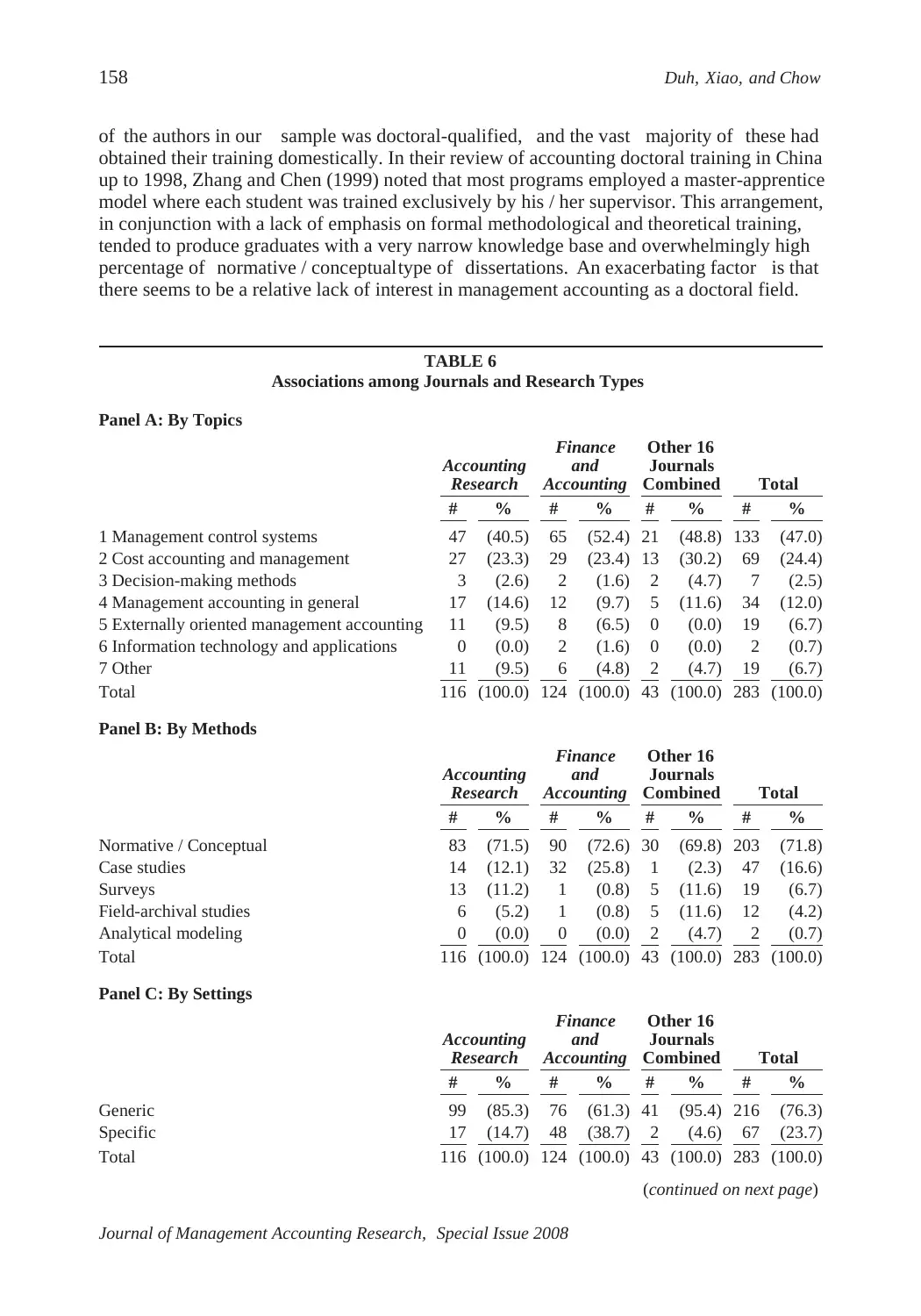
Journal of Management Accounting Research, Special Issue 2008
TABLE 6
Associations among Journals and Research Types
Panel A: By Topics
Accounting
Research
Finance
and
Accounting
Other 16
Journals
Combined Total
# % # % # % # %
1 Management control systems 47 (40.5) 65 (52.4) 21 (48.8) 133 (47.0)
2 Cost accounting and management 27 (23.3) 29 (23.4) 13 (30.2) 69 (24.4)
3 Decision-making methods 3 (2.6) 2 (1.6) 2 (4.7) 7 (2.5)
4 Management accounting in general 17 (14.6) 12 (9.7) 5 (11.6) 34 (12.0)
5 Externally oriented management accounting 11 (9.5) 8 (6.5) 0 (0.0) 19 (6.7)
6 Information technology and applications 0 (0.0) 2 (1.6) 0 (0.0) 2 (0.7)
7 Other 11 (9.5) 6 (4.8) 2 (4.7) 19 (6.7)
Total 116 (100.0) 124 (100.0) 43 (100.0) 283 (100.0)
Panel B: By Methods
Accounting
Research
Finance
and
Accounting
Other 16
Journals
Combined Total
# % # % # % # %
Normative / Conceptual 83 (71.5) 90 (72.6) 30 (69.8) 203 (71.8)
Case studies 14 (12.1) 32 (25.8) 1 (2.3) 47 (16.6)
Surveys 13 (11.2) 1 (0.8) 5 (11.6) 19 (6.7)
Field-archival studies 6 (5.2) 1 (0.8) 5 (11.6) 12 (4.2)
Analytical modeling 0 (0.0) 0 (0.0) 2 (4.7) 2 (0.7)
Total 116 (100.0) 124 (100.0) 43 (100.0) 283 (100.0)
Panel C: By Settings
Accounting
Research
Finance
and
Accounting
Other 16
Journals
Combined Total
# % # % # % # %
Generic 99 (85.3) 76 (61.3) 41 (95.4) 216 (76.3)
Specific 17 (14.7) 48 (38.7) 2 (4.6) 67 (23.7)
Total 116 (100.0) 124 (100.0) 43 (100.0) 283 (100.0)
(continued on next page)
of the authors in our sample was doctoral-qualified, and the vast majority of these had
obtained their training domestically. In their review of accounting doctoral training in China
up to 1998, Zhang and Chen (1999) noted that most programs employed a master-apprentice
model where each student was trained exclusively by his / her supervisor. This arrangement,
in conjunction with a lack of emphasis on formal methodological and theoretical training,
tended to produce graduates with a very narrow knowledge base and overwhelmingly high
percentage of normative / conceptualtype of dissertations. An exacerbating factor is that
there seems to be a relative lack of interest in management accounting as a doctoral field.
⊘ This is a preview!⊘
Do you want full access?
Subscribe today to unlock all pages.

Trusted by 1+ million students worldwide
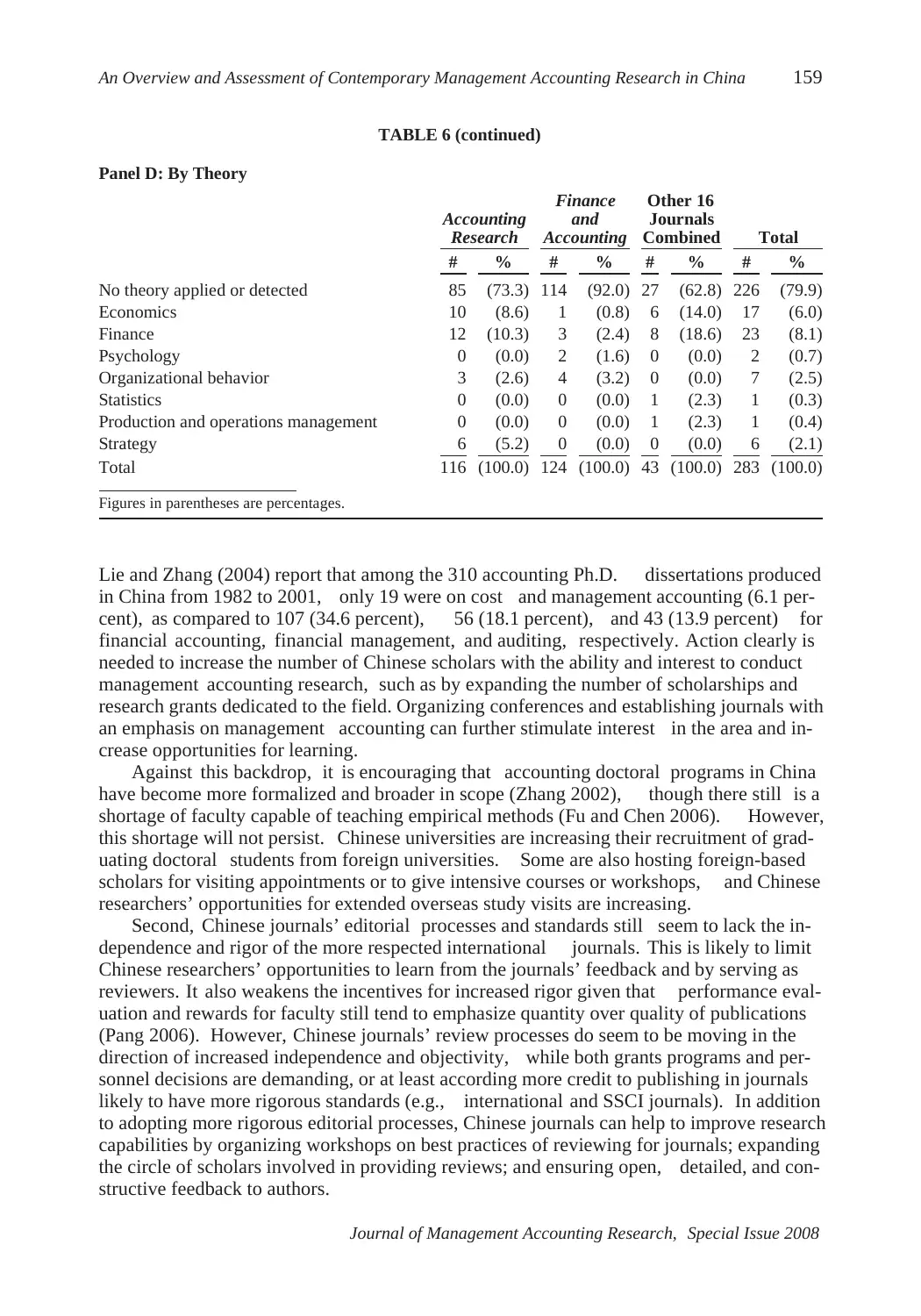
Journal of Management Accounting Research, Special Issue 2008
TABLE 6 (continued)
Panel D: By Theory
Accounting
Research
Finance
and
Accounting
Other 16
Journals
Combined Total
# % # % # % # %
No theory applied or detected 85 (73.3) 114 (92.0) 27 (62.8) 226 (79.9)
Economics 10 (8.6) 1 (0.8) 6 (14.0) 17 (6.0)
Finance 12 (10.3) 3 (2.4) 8 (18.6) 23 (8.1)
Psychology 0 (0.0) 2 (1.6) 0 (0.0) 2 (0.7)
Organizational behavior 3 (2.6) 4 (3.2) 0 (0.0) 7 (2.5)
Statistics 0 (0.0) 0 (0.0) 1 (2.3) 1 (0.3)
Production and operations management 0 (0.0) 0 (0.0) 1 (2.3) 1 (0.4)
Strategy 6 (5.2) 0 (0.0) 0 (0.0) 6 (2.1)
Total 116 (100.0) 124 (100.0) 43 (100.0) 283 (100.0)
Figures in parentheses are percentages.
Lie and Zhang (2004) report that among the 310 accounting Ph.D. dissertations produced
in China from 1982 to 2001, only 19 were on cost and management accounting (6.1 per-
cent), as compared to 107 (34.6 percent), 56 (18.1 percent), and 43 (13.9 percent) for
financial accounting, financial management, and auditing, respectively. Action clearly is
needed to increase the number of Chinese scholars with the ability and interest to conduct
management accounting research, such as by expanding the number of scholarships and
research grants dedicated to the field. Organizing conferences and establishing journals with
an emphasis on management accounting can further stimulate interest in the area and in-
crease opportunities for learning.
Against this backdrop, it is encouraging that accounting doctoral programs in China
have become more formalized and broader in scope (Zhang 2002), though there still is a
shortage of faculty capable of teaching empirical methods (Fu and Chen 2006). However,
this shortage will not persist. Chinese universities are increasing their recruitment of grad-
uating doctoral students from foreign universities. Some are also hosting foreign-based
scholars for visiting appointments or to give intensive courses or workshops, and Chinese
researchers’ opportunities for extended overseas study visits are increasing.
Second, Chinese journals’ editorial processes and standards still seem to lack the in-
dependence and rigor of the more respected international journals. This is likely to limit
Chinese researchers’ opportunities to learn from the journals’ feedback and by serving as
reviewers. It also weakens the incentives for increased rigor given that performance eval-
uation and rewards for faculty still tend to emphasize quantity over quality of publications
(Pang 2006). However, Chinese journals’ review processes do seem to be moving in the
direction of increased independence and objectivity, while both grants programs and per-
sonnel decisions are demanding, or at least according more credit to publishing in journals
likely to have more rigorous standards (e.g., international and SSCI journals). In addition
to adopting more rigorous editorial processes, Chinese journals can help to improve research
capabilities by organizing workshops on best practices of reviewing for journals; expanding
the circle of scholars involved in providing reviews; and ensuring open, detailed, and con-
structive feedback to authors.
Paraphrase This Document
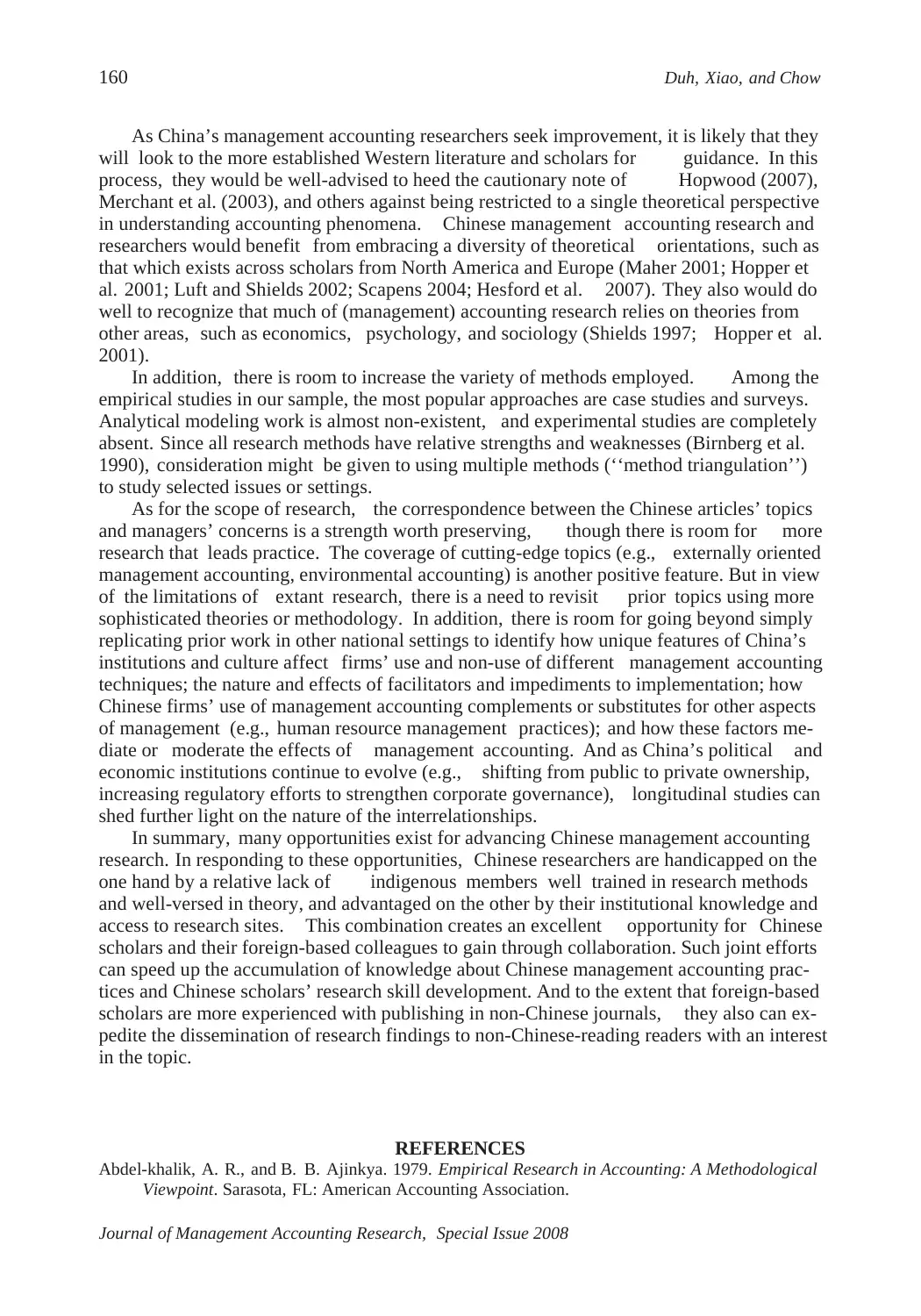
Journal of Management Accounting Research, Special Issue 2008
As China’s management accounting researchers seek improvement, it is likely that they
will look to the more established Western literature and scholars for guidance. In this
process, they would be well-advised to heed the cautionary note of Hopwood (2007),
Merchant et al. (2003), and others against being restricted to a single theoretical perspective
in understanding accounting phenomena. Chinese management accounting research and
researchers would benefit from embracing a diversity of theoretical orientations, such as
that which exists across scholars from North America and Europe (Maher 2001; Hopper et
al. 2001; Luft and Shields 2002; Scapens 2004; Hesford et al. 2007). They also would do
well to recognize that much of (management) accounting research relies on theories from
other areas, such as economics, psychology, and sociology (Shields 1997; Hopper et al.
2001).
In addition, there is room to increase the variety of methods employed. Among the
empirical studies in our sample, the most popular approaches are case studies and surveys.
Analytical modeling work is almost non-existent, and experimental studies are completely
absent. Since all research methods have relative strengths and weaknesses (Birnberg et al.
1990), consideration might be given to using multiple methods (‘‘method triangulation’’)
to study selected issues or settings.
As for the scope of research, the correspondence between the Chinese articles’ topics
and managers’ concerns is a strength worth preserving, though there is room for more
research that leads practice. The coverage of cutting-edge topics (e.g., externally oriented
management accounting, environmental accounting) is another positive feature. But in view
of the limitations of extant research, there is a need to revisit prior topics using more
sophisticated theories or methodology. In addition, there is room for going beyond simply
replicating prior work in other national settings to identify how unique features of China’s
institutions and culture affect firms’ use and non-use of different management accounting
techniques; the nature and effects of facilitators and impediments to implementation; how
Chinese firms’ use of management accounting complements or substitutes for other aspects
of management (e.g., human resource management practices); and how these factors me-
diate or moderate the effects of management accounting. And as China’s political and
economic institutions continue to evolve (e.g., shifting from public to private ownership,
increasing regulatory efforts to strengthen corporate governance), longitudinal studies can
shed further light on the nature of the interrelationships.
In summary, many opportunities exist for advancing Chinese management accounting
research. In responding to these opportunities, Chinese researchers are handicapped on the
one hand by a relative lack of indigenous members well trained in research methods
and well-versed in theory, and advantaged on the other by their institutional knowledge and
access to research sites. This combination creates an excellent opportunity for Chinese
scholars and their foreign-based colleagues to gain through collaboration. Such joint efforts
can speed up the accumulation of knowledge about Chinese management accounting prac-
tices and Chinese scholars’ research skill development. And to the extent that foreign-based
scholars are more experienced with publishing in non-Chinese journals, they also can ex-
pedite the dissemination of research findings to non-Chinese-reading readers with an interest
in the topic.
REFERENCES
Abdel-khalik, A. R., and B. B. Ajinkya. 1979. Empirical Research in Accounting: A Methodological
Viewpoint. Sarasota, FL: American Accounting Association.
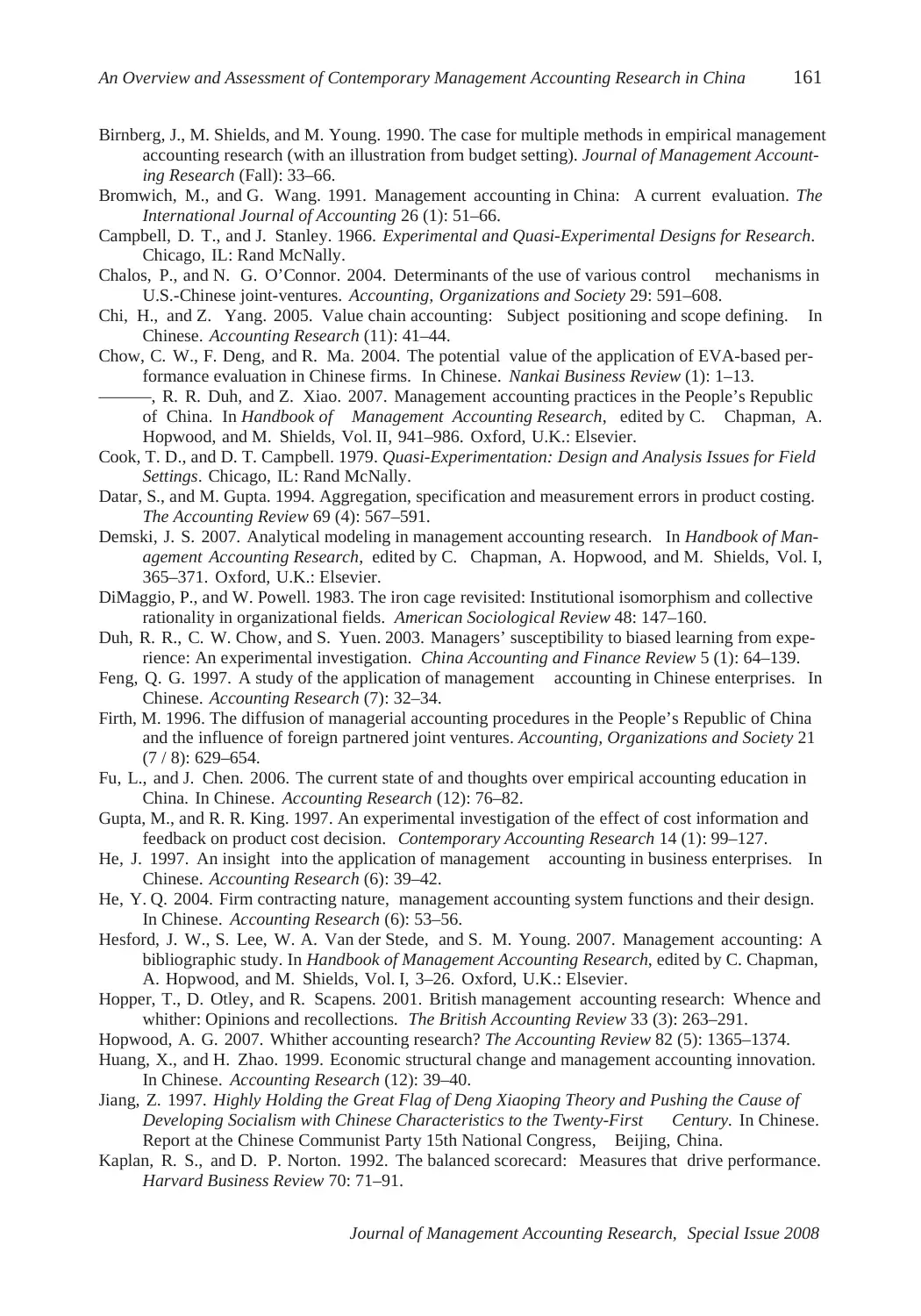
Journal of Management Accounting Research, Special Issue 2008
Birnberg, J., M. Shields, and M. Young. 1990. The case for multiple methods in empirical management
accounting research (with an illustration from budget setting). Journal of Management Account-
ing Research (Fall): 33–66.
Bromwich, M., and G. Wang. 1991. Management accounting in China: A current evaluation. The
International Journal of Accounting 26 (1): 51–66.
Campbell, D. T., and J. Stanley. 1966. Experimental and Quasi-Experimental Designs for Research.
Chicago, IL: Rand McNally.
Chalos, P., and N. G. O’Connor. 2004. Determinants of the use of various control mechanisms in
U.S.-Chinese joint-ventures. Accounting, Organizations and Society 29: 591–608.
Chi, H., and Z. Yang. 2005. Value chain accounting: Subject positioning and scope defining. In
Chinese. Accounting Research (11): 41–44.
Chow, C. W., F. Deng, and R. Ma. 2004. The potential value of the application of EVA-based per-
formance evaluation in Chinese firms. In Chinese. Nankai Business Review (1): 1–13.
———, R. R. Duh, and Z. Xiao. 2007. Management accounting practices in the People’s Republic
of China. In Handbook of Management Accounting Research, edited by C. Chapman, A.
Hopwood, and M. Shields, Vol. II, 941–986. Oxford, U.K.: Elsevier.
Cook, T. D., and D. T. Campbell. 1979. Quasi-Experimentation: Design and Analysis Issues for Field
Settings. Chicago, IL: Rand McNally.
Datar, S., and M. Gupta. 1994. Aggregation, specification and measurement errors in product costing.
The Accounting Review 69 (4): 567–591.
Demski, J. S. 2007. Analytical modeling in management accounting research. In Handbook of Man-
agement Accounting Research, edited by C. Chapman, A. Hopwood, and M. Shields, Vol. I,
365–371. Oxford, U.K.: Elsevier.
DiMaggio, P., and W. Powell. 1983. The iron cage revisited: Institutional isomorphism and collective
rationality in organizational fields. American Sociological Review 48: 147–160.
Duh, R. R., C. W. Chow, and S. Yuen. 2003. Managers’ susceptibility to biased learning from expe-
rience: An experimental investigation. China Accounting and Finance Review 5 (1): 64–139.
Feng, Q. G. 1997. A study of the application of management accounting in Chinese enterprises. In
Chinese. Accounting Research (7): 32–34.
Firth, M. 1996. The diffusion of managerial accounting procedures in the People’s Republic of China
and the influence of foreign partnered joint ventures. Accounting, Organizations and Society 21
(7 / 8): 629–654.
Fu, L., and J. Chen. 2006. The current state of and thoughts over empirical accounting education in
China. In Chinese. Accounting Research (12): 76–82.
Gupta, M., and R. R. King. 1997. An experimental investigation of the effect of cost information and
feedback on product cost decision. Contemporary Accounting Research 14 (1): 99–127.
He, J. 1997. An insight into the application of management accounting in business enterprises. In
Chinese. Accounting Research (6): 39–42.
He, Y. Q. 2004. Firm contracting nature, management accounting system functions and their design.
In Chinese. Accounting Research (6): 53–56.
Hesford, J. W., S. Lee, W. A. Van der Stede, and S. M. Young. 2007. Management accounting: A
bibliographic study. In Handbook of Management Accounting Research, edited by C. Chapman,
A. Hopwood, and M. Shields, Vol. I, 3–26. Oxford, U.K.: Elsevier.
Hopper, T., D. Otley, and R. Scapens. 2001. British management accounting research: Whence and
whither: Opinions and recollections. The British Accounting Review 33 (3): 263–291.
Hopwood, A. G. 2007. Whither accounting research? The Accounting Review 82 (5): 1365–1374.
Huang, X., and H. Zhao. 1999. Economic structural change and management accounting innovation.
In Chinese. Accounting Research (12): 39–40.
Jiang, Z. 1997. Highly Holding the Great Flag of Deng Xiaoping Theory and Pushing the Cause of
Developing Socialism with Chinese Characteristics to the Twenty-First Century. In Chinese.
Report at the Chinese Communist Party 15th National Congress, Beijing, China.
Kaplan, R. S., and D. P. Norton. 1992. The balanced scorecard: Measures that drive performance.
Harvard Business Review 70: 71–91.
⊘ This is a preview!⊘
Do you want full access?
Subscribe today to unlock all pages.

Trusted by 1+ million students worldwide
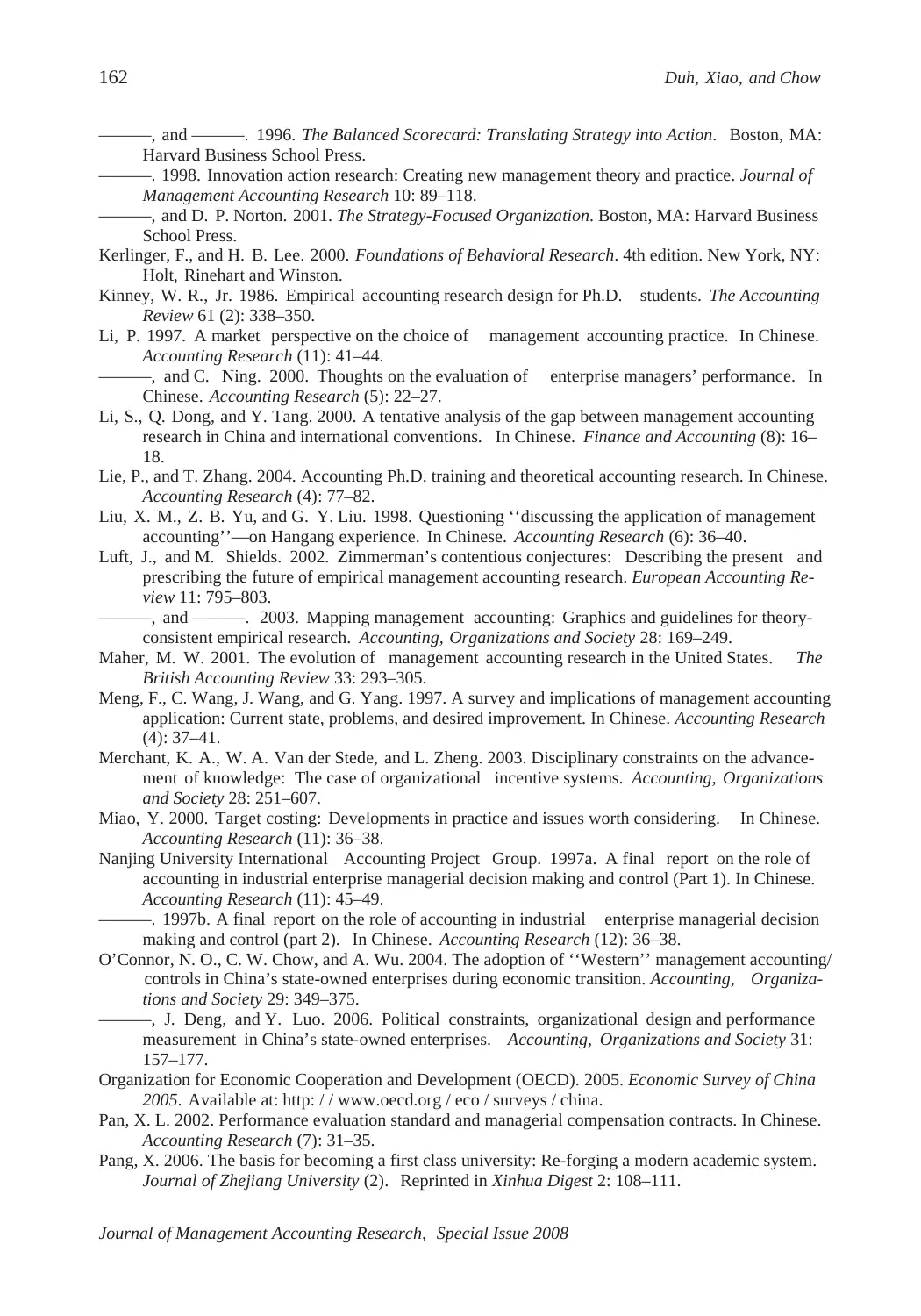
Journal of Management Accounting Research, Special Issue 2008
———, and ———. 1996. The Balanced Scorecard: Translating Strategy into Action. Boston, MA:
Harvard Business School Press.
———. 1998. Innovation action research: Creating new management theory and practice. Journal of
Management Accounting Research 10: 89–118.
———, and D. P. Norton. 2001. The Strategy-Focused Organization. Boston, MA: Harvard Business
School Press.
Kerlinger, F., and H. B. Lee. 2000. Foundations of Behavioral Research. 4th edition. New York, NY:
Holt, Rinehart and Winston.
Kinney, W. R., Jr. 1986. Empirical accounting research design for Ph.D. students. The Accounting
Review 61 (2): 338–350.
Li, P. 1997. A market perspective on the choice of management accounting practice. In Chinese.
Accounting Research (11): 41–44.
———, and C. Ning. 2000. Thoughts on the evaluation of enterprise managers’ performance. In
Chinese. Accounting Research (5): 22–27.
Li, S., Q. Dong, and Y. Tang. 2000. A tentative analysis of the gap between management accounting
research in China and international conventions. In Chinese. Finance and Accounting (8): 16–
18.
Lie, P., and T. Zhang. 2004. Accounting Ph.D. training and theoretical accounting research. In Chinese.
Accounting Research (4): 77–82.
Liu, X. M., Z. B. Yu, and G. Y. Liu. 1998. Questioning ‘‘discussing the application of management
accounting’’—on Hangang experience. In Chinese. Accounting Research (6): 36–40.
Luft, J., and M. Shields. 2002. Zimmerman’s contentious conjectures: Describing the present and
prescribing the future of empirical management accounting research. European Accounting Re-
view 11: 795–803.
———, and ———. 2003. Mapping management accounting: Graphics and guidelines for theory-
consistent empirical research. Accounting, Organizations and Society 28: 169–249.
Maher, M. W. 2001. The evolution of management accounting research in the United States. The
British Accounting Review 33: 293–305.
Meng, F., C. Wang, J. Wang, and G. Yang. 1997. A survey and implications of management accounting
application: Current state, problems, and desired improvement. In Chinese. Accounting Research
(4): 37–41.
Merchant, K. A., W. A. Van der Stede, and L. Zheng. 2003. Disciplinary constraints on the advance-
ment of knowledge: The case of organizational incentive systems. Accounting, Organizations
and Society 28: 251–607.
Miao, Y. 2000. Target costing: Developments in practice and issues worth considering. In Chinese.
Accounting Research (11): 36–38.
Nanjing University International Accounting Project Group. 1997a. A final report on the role of
accounting in industrial enterprise managerial decision making and control (Part 1). In Chinese.
Accounting Research (11): 45–49.
———. 1997b. A final report on the role of accounting in industrial enterprise managerial decision
making and control (part 2). In Chinese. Accounting Research (12): 36–38.
O’Connor, N. O., C. W. Chow, and A. Wu. 2004. The adoption of ‘‘Western’’ management accounting/
controls in China’s state-owned enterprises during economic transition. Accounting, Organiza-
tions and Society 29: 349–375.
———, J. Deng, and Y. Luo. 2006. Political constraints, organizational design and performance
measurement in China’s state-owned enterprises. Accounting, Organizations and Society 31:
157–177.
Organization for Economic Cooperation and Development (OECD). 2005. Economic Survey of China
2005. Available at: http: / / www.oecd.org / eco / surveys / china.
Pan, X. L. 2002. Performance evaluation standard and managerial compensation contracts. In Chinese.
Accounting Research (7): 31–35.
Pang, X. 2006. The basis for becoming a first class university: Re-forging a modern academic system.
Journal of Zhejiang University (2). Reprinted in Xinhua Digest 2: 108–111.
Paraphrase This Document
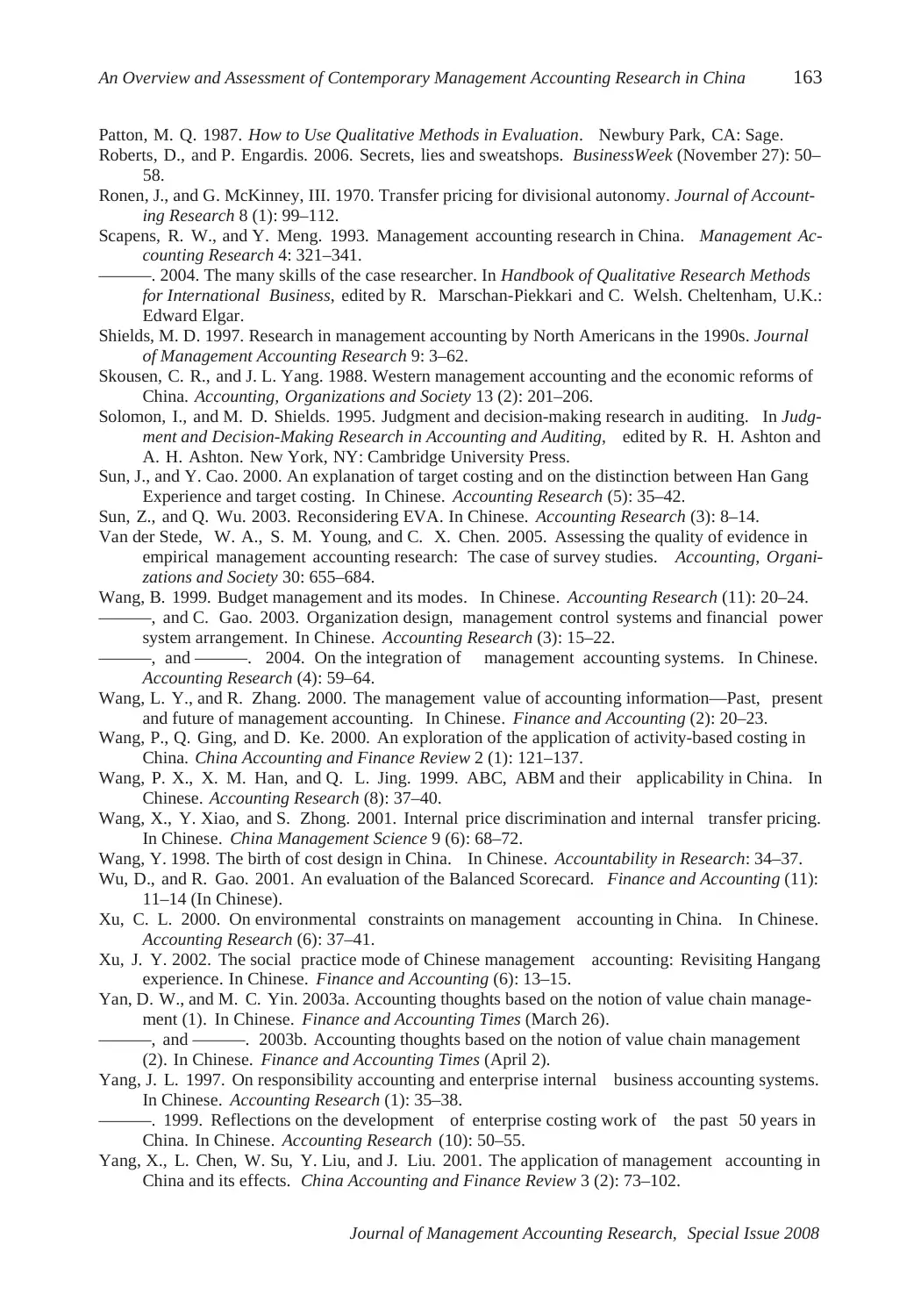
Journal of Management Accounting Research, Special Issue 2008
Patton, M. Q. 1987. How to Use Qualitative Methods in Evaluation. Newbury Park, CA: Sage.
Roberts, D., and P. Engardis. 2006. Secrets, lies and sweatshops. BusinessWeek (November 27): 50–
58.
Ronen, J., and G. McKinney, III. 1970. Transfer pricing for divisional autonomy. Journal of Account-
ing Research 8 (1): 99–112.
Scapens, R. W., and Y. Meng. 1993. Management accounting research in China. Management Ac-
counting Research 4: 321–341.
———. 2004. The many skills of the case researcher. In Handbook of Qualitative Research Methods
for International Business, edited by R. Marschan-Piekkari and C. Welsh. Cheltenham, U.K.:
Edward Elgar.
Shields, M. D. 1997. Research in management accounting by North Americans in the 1990s. Journal
of Management Accounting Research 9: 3–62.
Skousen, C. R., and J. L. Yang. 1988. Western management accounting and the economic reforms of
China. Accounting, Organizations and Society 13 (2): 201–206.
Solomon, I., and M. D. Shields. 1995. Judgment and decision-making research in auditing. In Judg-
ment and Decision-Making Research in Accounting and Auditing, edited by R. H. Ashton and
A. H. Ashton. New York, NY: Cambridge University Press.
Sun, J., and Y. Cao. 2000. An explanation of target costing and on the distinction between Han Gang
Experience and target costing. In Chinese. Accounting Research (5): 35–42.
Sun, Z., and Q. Wu. 2003. Reconsidering EVA. In Chinese. Accounting Research (3): 8–14.
Van der Stede, W. A., S. M. Young, and C. X. Chen. 2005. Assessing the quality of evidence in
empirical management accounting research: The case of survey studies. Accounting, Organi-
zations and Society 30: 655–684.
Wang, B. 1999. Budget management and its modes. In Chinese. Accounting Research (11): 20–24.
———, and C. Gao. 2003. Organization design, management control systems and financial power
system arrangement. In Chinese. Accounting Research (3): 15–22.
———, and ———. 2004. On the integration of management accounting systems. In Chinese.
Accounting Research (4): 59–64.
Wang, L. Y., and R. Zhang. 2000. The management value of accounting information—Past, present
and future of management accounting. In Chinese. Finance and Accounting (2): 20–23.
Wang, P., Q. Ging, and D. Ke. 2000. An exploration of the application of activity-based costing in
China. China Accounting and Finance Review 2 (1): 121–137.
Wang, P. X., X. M. Han, and Q. L. Jing. 1999. ABC, ABM and their applicability in China. In
Chinese. Accounting Research (8): 37–40.
Wang, X., Y. Xiao, and S. Zhong. 2001. Internal price discrimination and internal transfer pricing.
In Chinese. China Management Science 9 (6): 68–72.
Wang, Y. 1998. The birth of cost design in China. In Chinese. Accountability in Research: 34–37.
Wu, D., and R. Gao. 2001. An evaluation of the Balanced Scorecard. Finance and Accounting (11):
11–14 (In Chinese).
Xu, C. L. 2000. On environmental constraints on management accounting in China. In Chinese.
Accounting Research (6): 37–41.
Xu, J. Y. 2002. The social practice mode of Chinese management accounting: Revisiting Hangang
experience. In Chinese. Finance and Accounting (6): 13–15.
Yan, D. W., and M. C. Yin. 2003a. Accounting thoughts based on the notion of value chain manage-
ment (1). In Chinese. Finance and Accounting Times (March 26).
———, and ———. 2003b. Accounting thoughts based on the notion of value chain management
(2). In Chinese. Finance and Accounting Times (April 2).
Yang, J. L. 1997. On responsibility accounting and enterprise internal business accounting systems.
In Chinese. Accounting Research (1): 35–38.
———. 1999. Reflections on the development of enterprise costing work of the past 50 years in
China. In Chinese. Accounting Research (10): 50–55.
Yang, X., L. Chen, W. Su, Y. Liu, and J. Liu. 2001. The application of management accounting in
China and its effects. China Accounting and Finance Review 3 (2): 73–102.
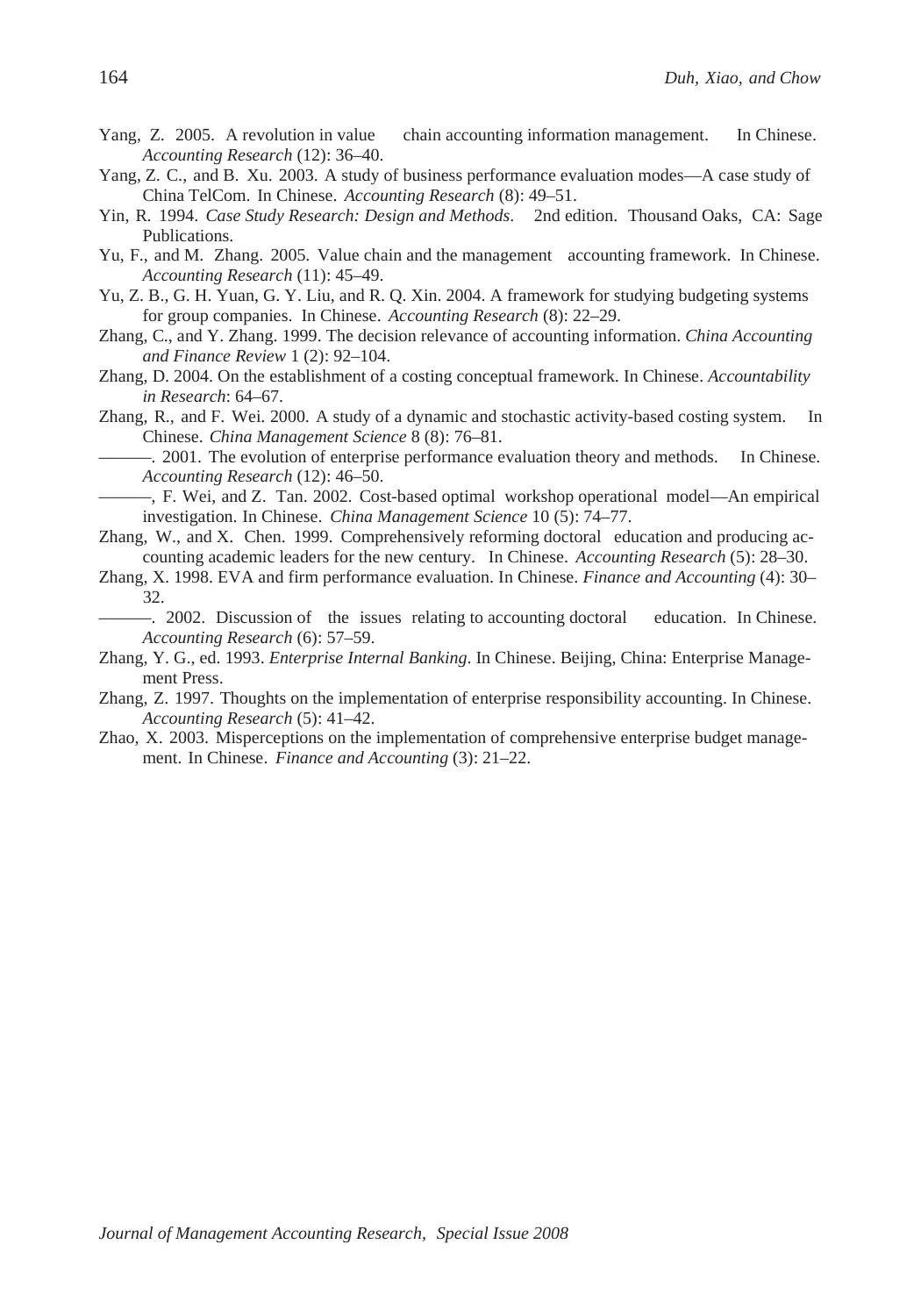
Journal of Management Accounting Research, Special Issue 2008
Yang, Z. 2005. A revolution in value chain accounting information management. In Chinese.
Accounting Research (12): 36–40.
Yang, Z. C., and B. Xu. 2003. A study of business performance evaluation modes—A case study of
China TelCom. In Chinese. Accounting Research (8): 49–51.
Yin, R. 1994. Case Study Research: Design and Methods. 2nd edition. Thousand Oaks, CA: Sage
Publications.
Yu, F., and M. Zhang. 2005. Value chain and the management accounting framework. In Chinese.
Accounting Research (11): 45–49.
Yu, Z. B., G. H. Yuan, G. Y. Liu, and R. Q. Xin. 2004. A framework for studying budgeting systems
for group companies. In Chinese. Accounting Research (8): 22–29.
Zhang, C., and Y. Zhang. 1999. The decision relevance of accounting information. China Accounting
and Finance Review 1 (2): 92–104.
Zhang, D. 2004. On the establishment of a costing conceptual framework. In Chinese. Accountability
in Research: 64–67.
Zhang, R., and F. Wei. 2000. A study of a dynamic and stochastic activity-based costing system. In
Chinese. China Management Science 8 (8): 76–81.
———. 2001. The evolution of enterprise performance evaluation theory and methods. In Chinese.
Accounting Research (12): 46–50.
———, F. Wei, and Z. Tan. 2002. Cost-based optimal workshop operational model—An empirical
investigation. In Chinese. China Management Science 10 (5): 74–77.
Zhang, W., and X. Chen. 1999. Comprehensively reforming doctoral education and producing ac-
counting academic leaders for the new century. In Chinese. Accounting Research (5): 28–30.
Zhang, X. 1998. EVA and firm performance evaluation. In Chinese. Finance and Accounting (4): 30–
32.
———. 2002. Discussion of the issues relating to accounting doctoral education. In Chinese.
Accounting Research (6): 57–59.
Zhang, Y. G., ed. 1993. Enterprise Internal Banking. In Chinese. Beijing, China: Enterprise Manage-
ment Press.
Zhang, Z. 1997. Thoughts on the implementation of enterprise responsibility accounting. In Chinese.
Accounting Research (5): 41–42.
Zhao, X. 2003. Misperceptions on the implementation of comprehensive enterprise budget manage-
ment. In Chinese. Finance and Accounting (3): 21–22.
⊘ This is a preview!⊘
Do you want full access?
Subscribe today to unlock all pages.

Trusted by 1+ million students worldwide

Related Documents
Your All-in-One AI-Powered Toolkit for Academic Success.
+13062052269
info@desklib.com
Available 24*7 on WhatsApp / Email
![[object Object]](/_next/static/media/star-bottom.7253800d.svg)
© 2024 | Zucol Services PVT LTD | All rights reserved.



